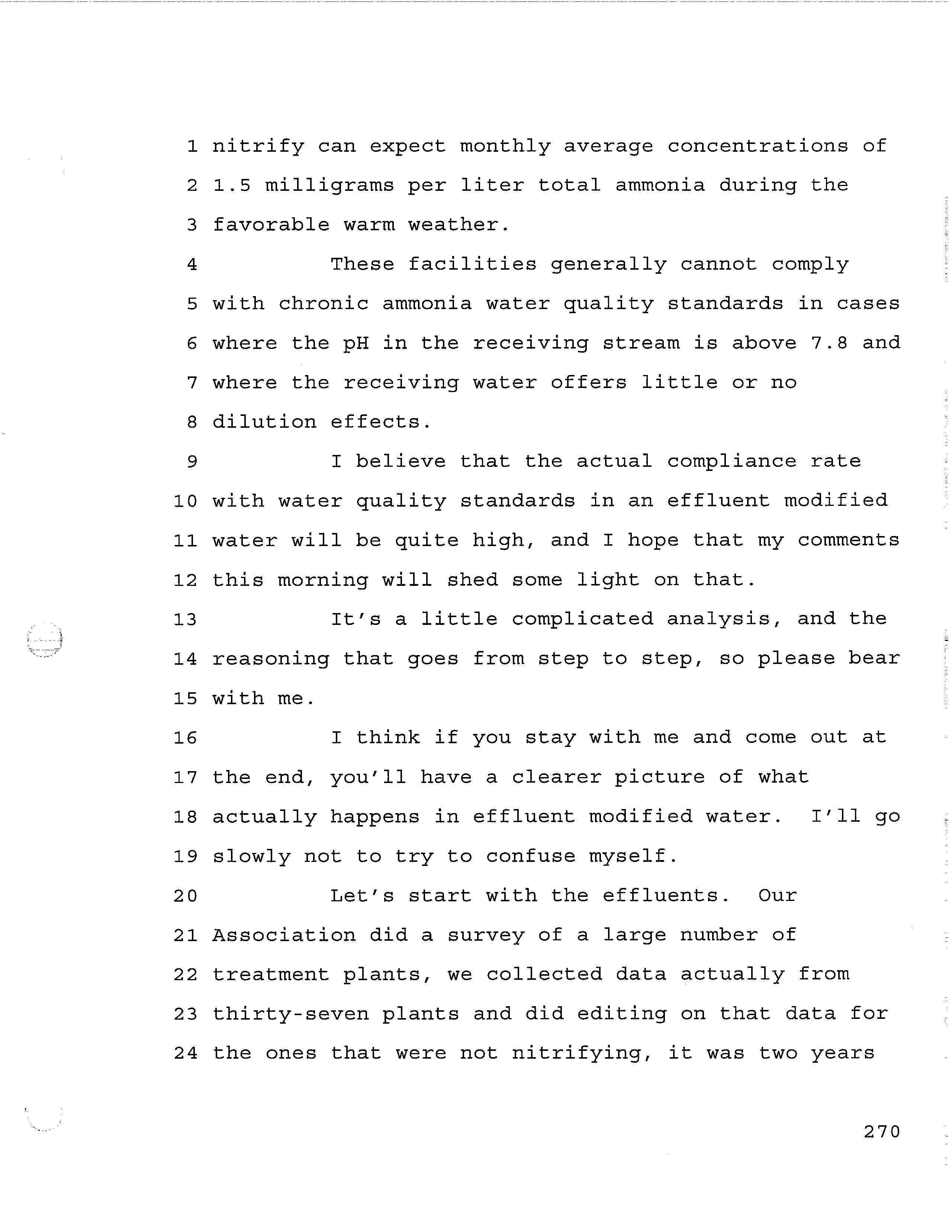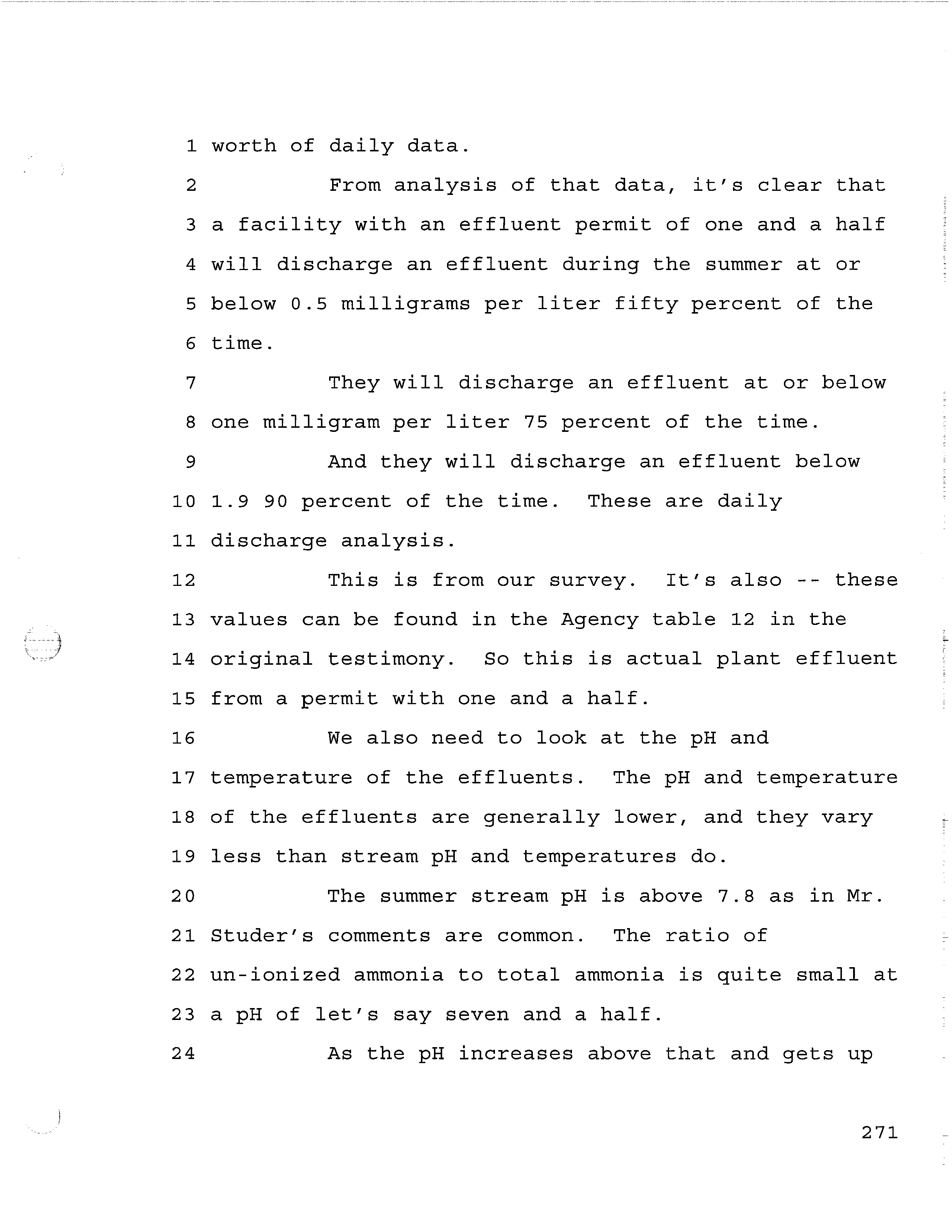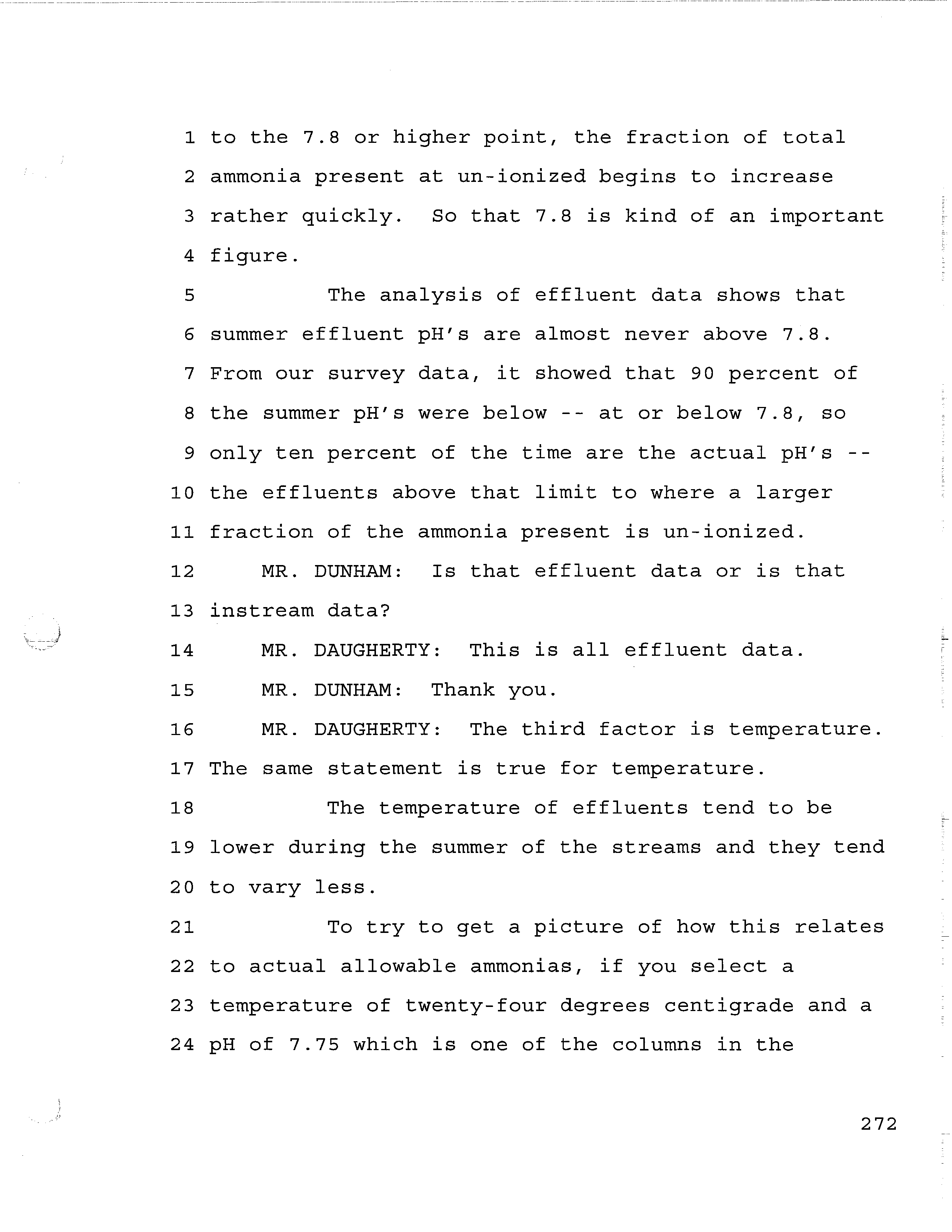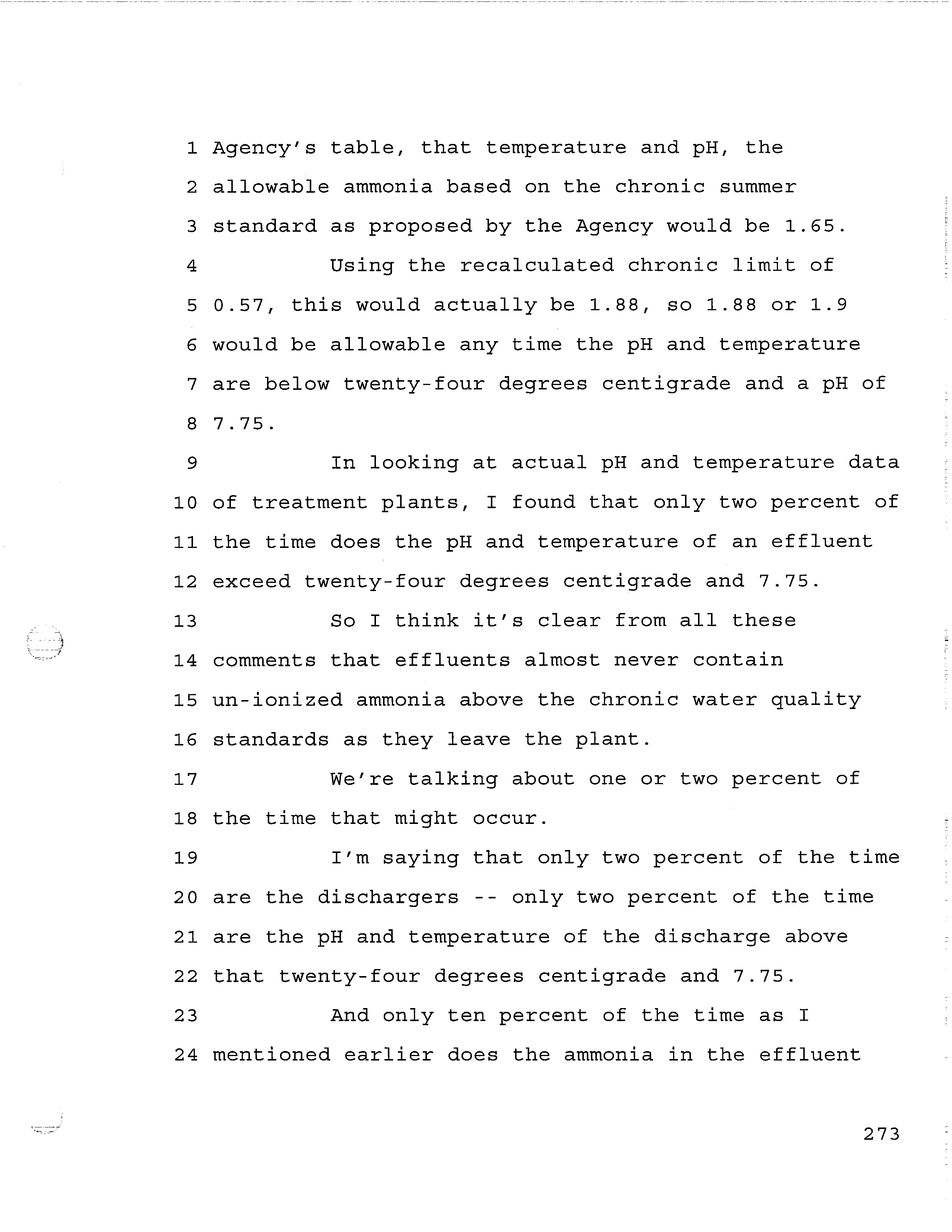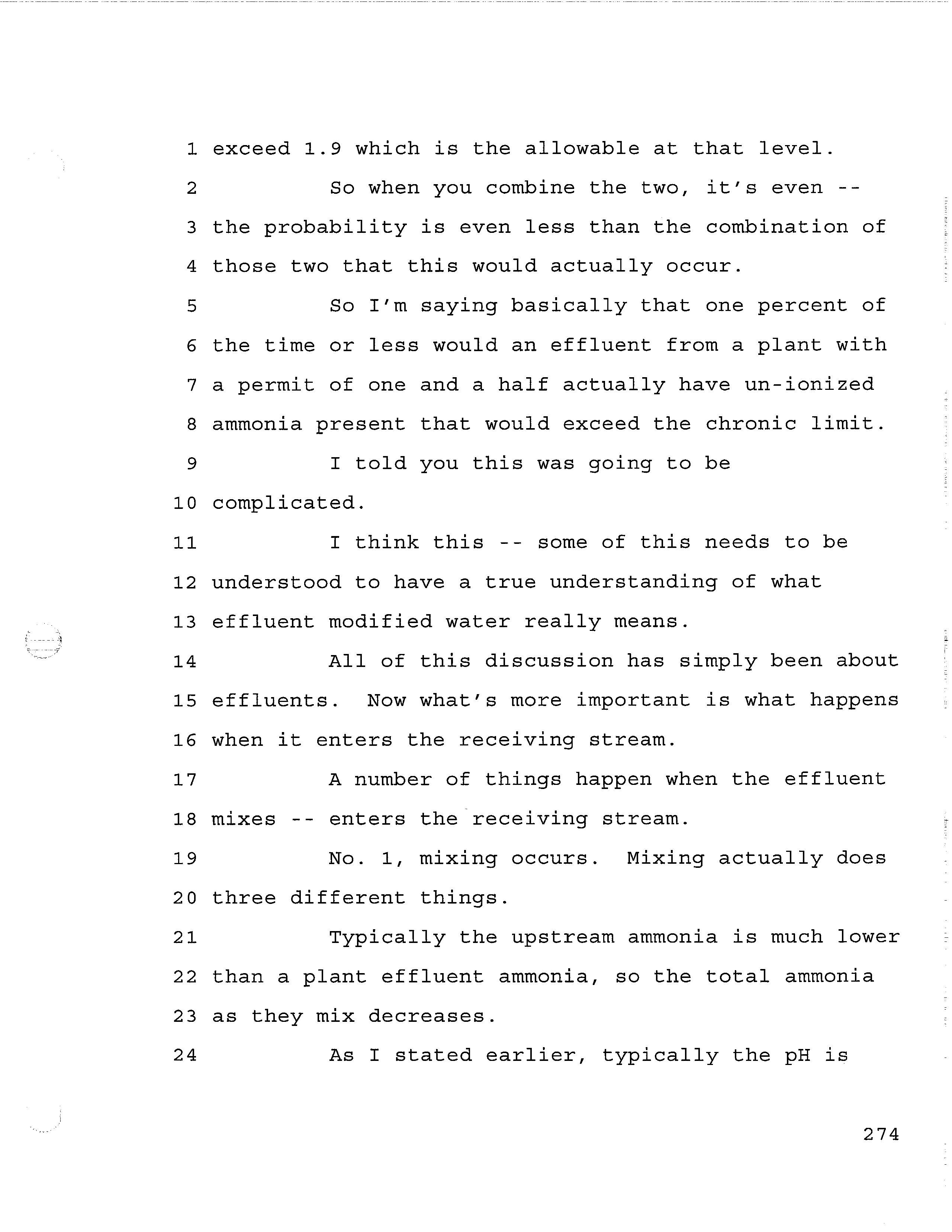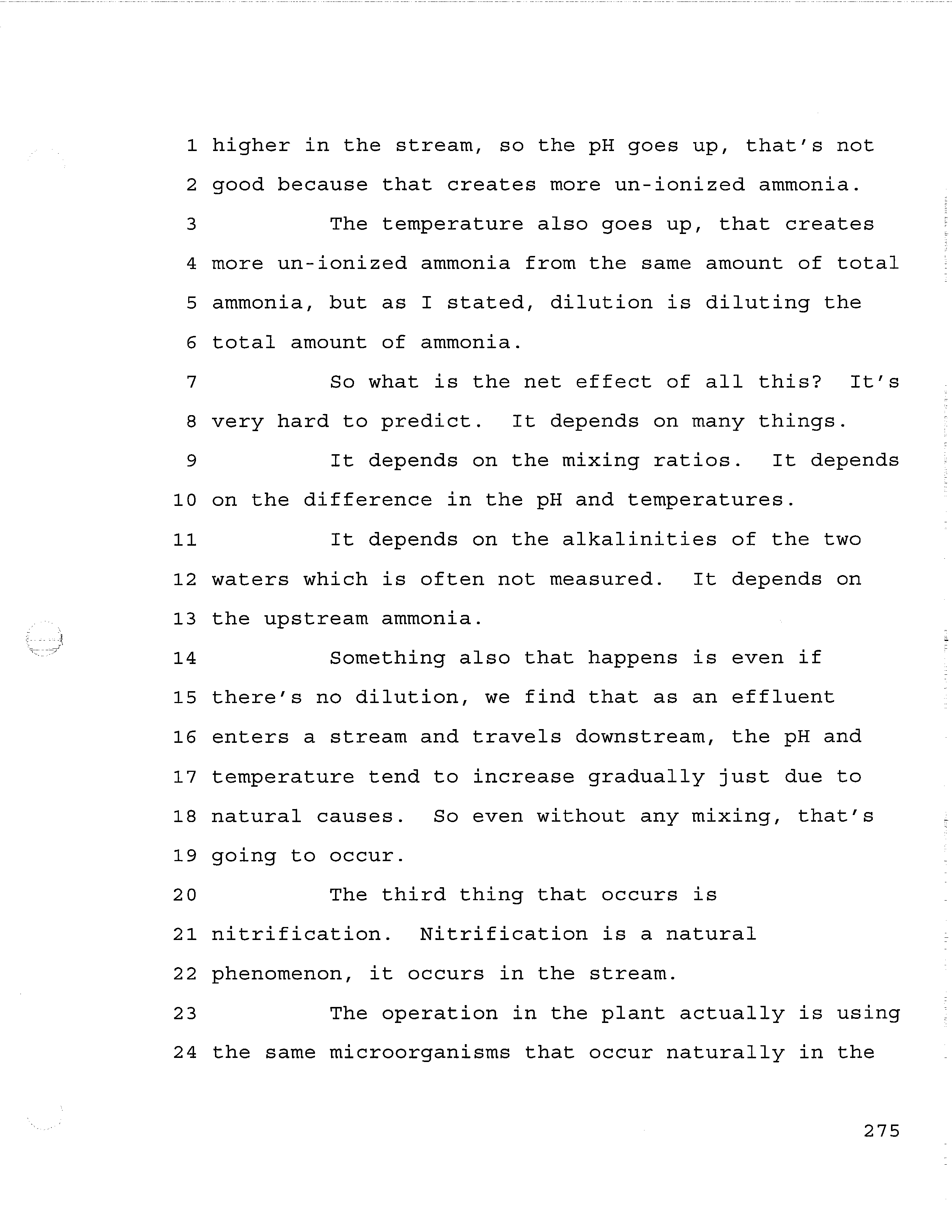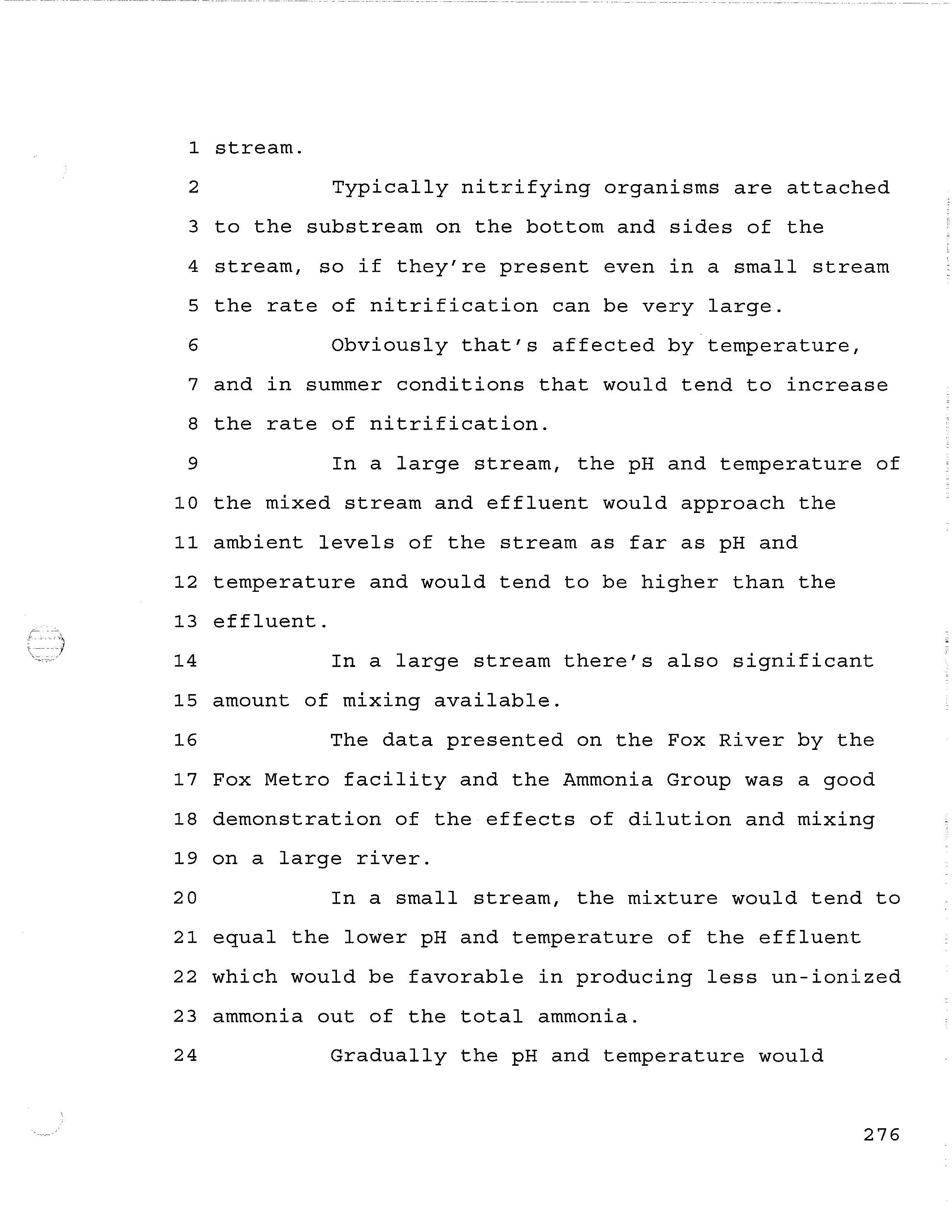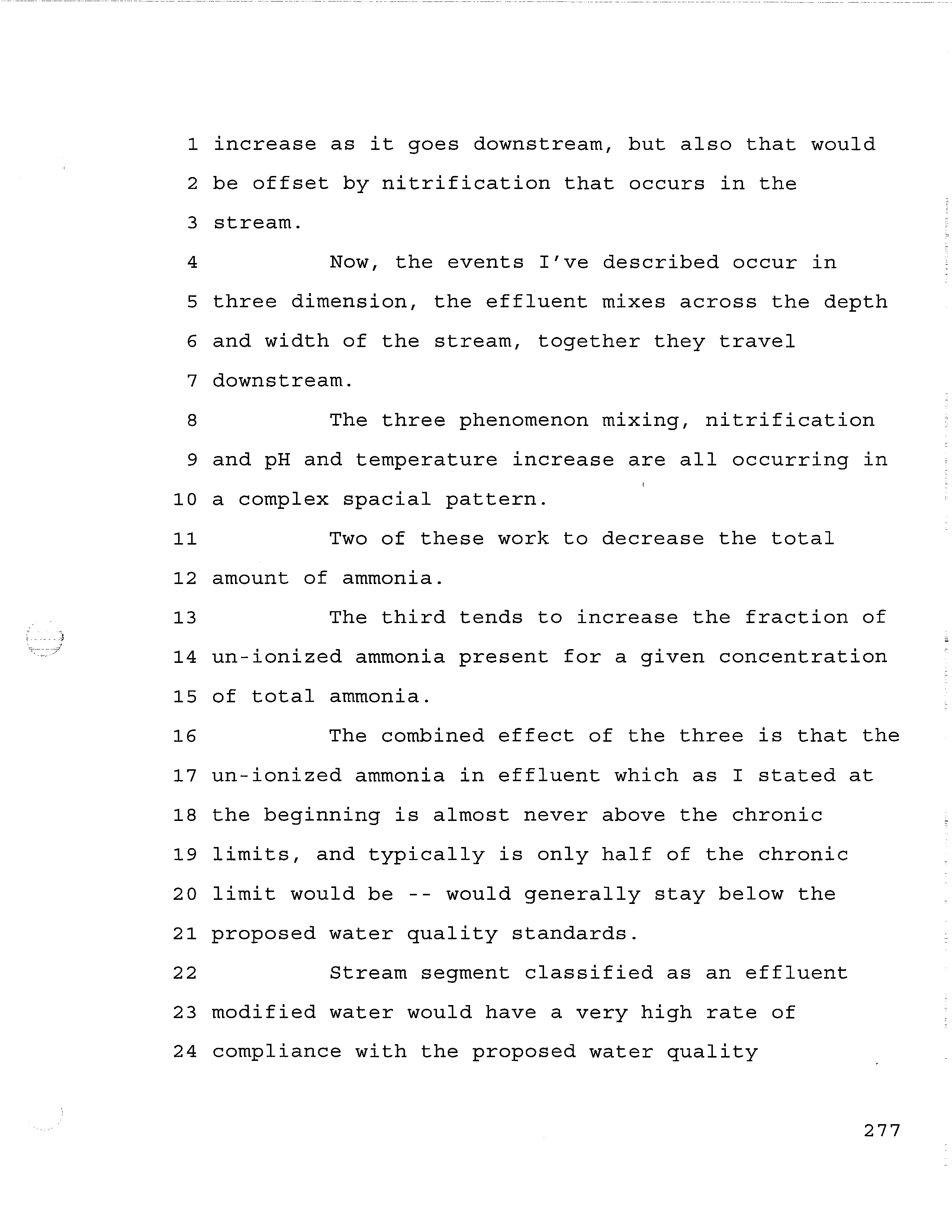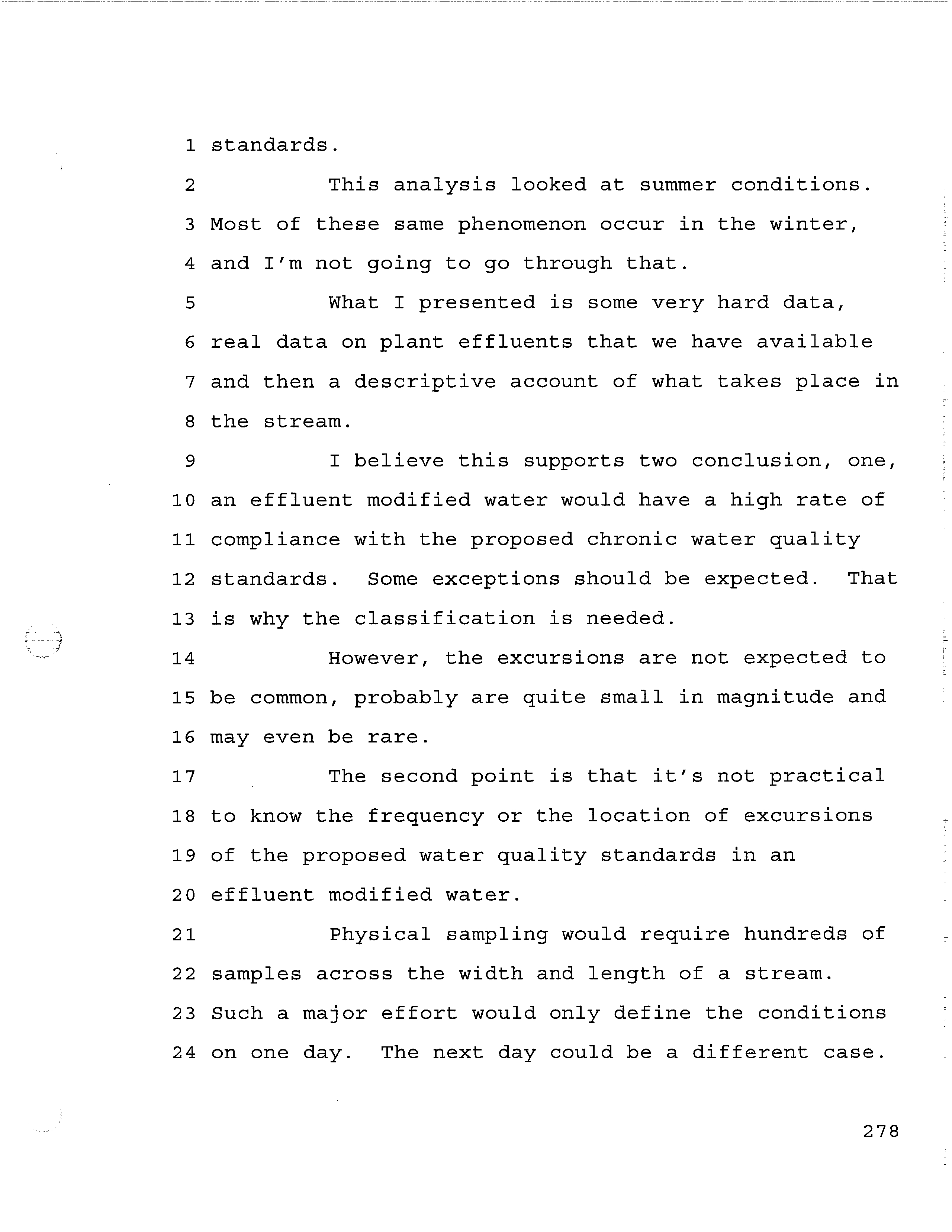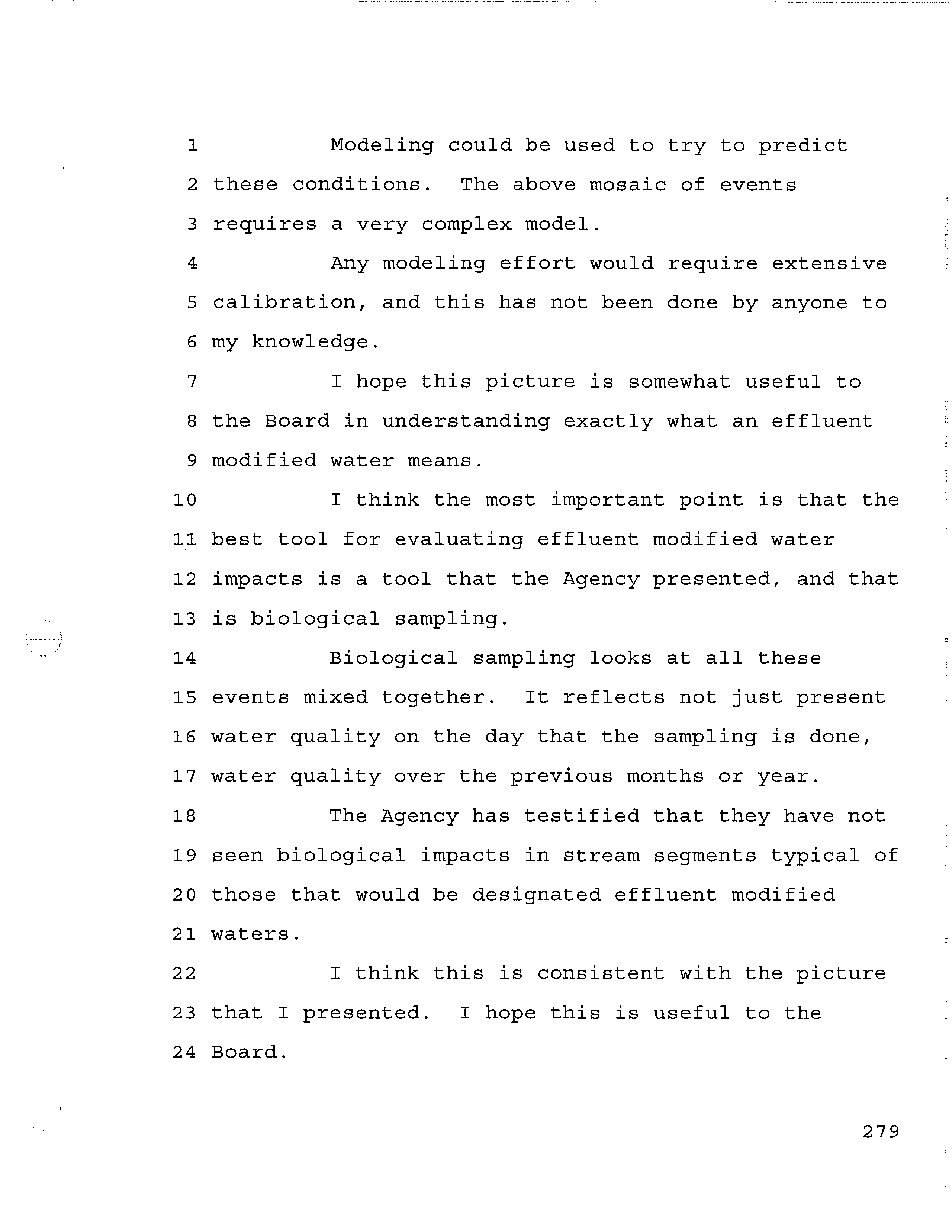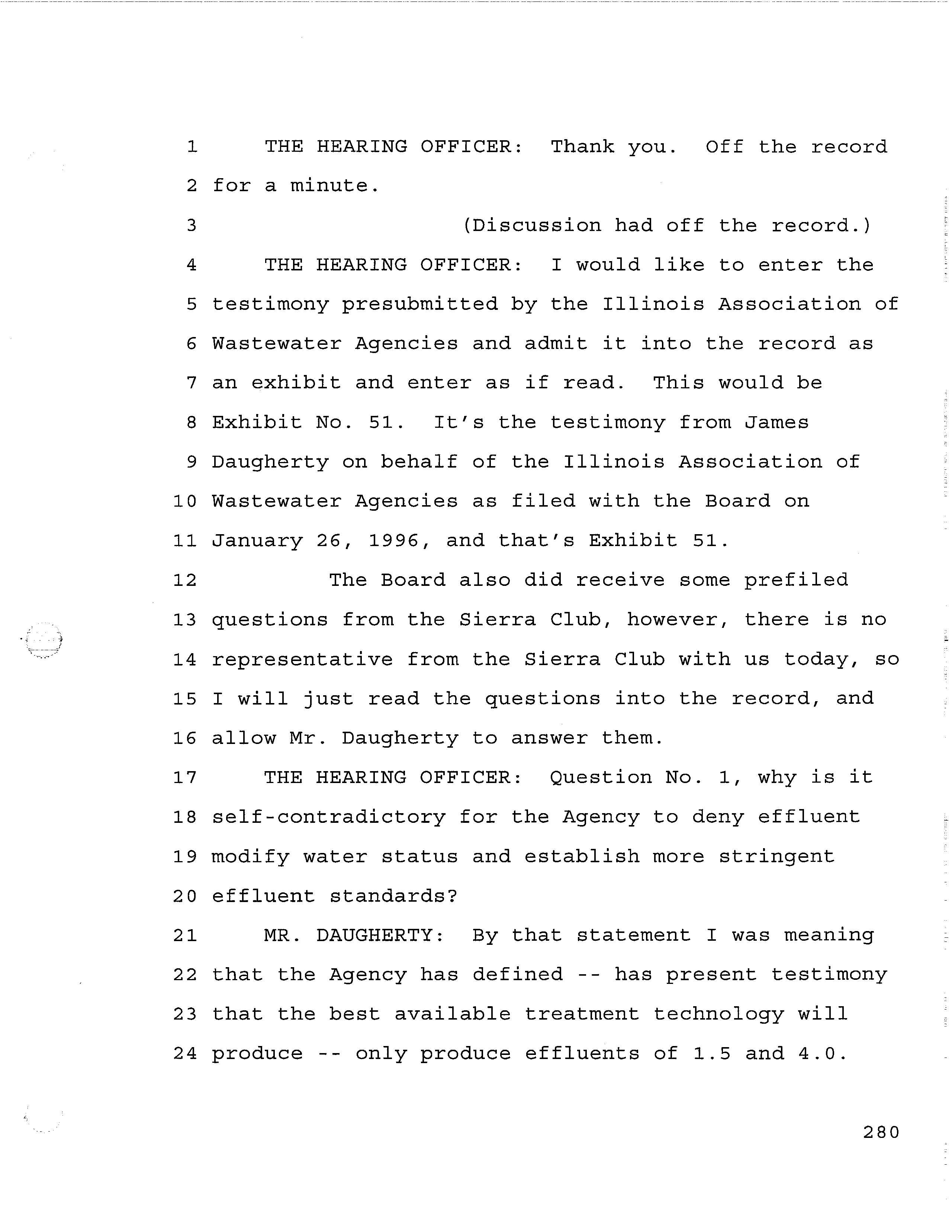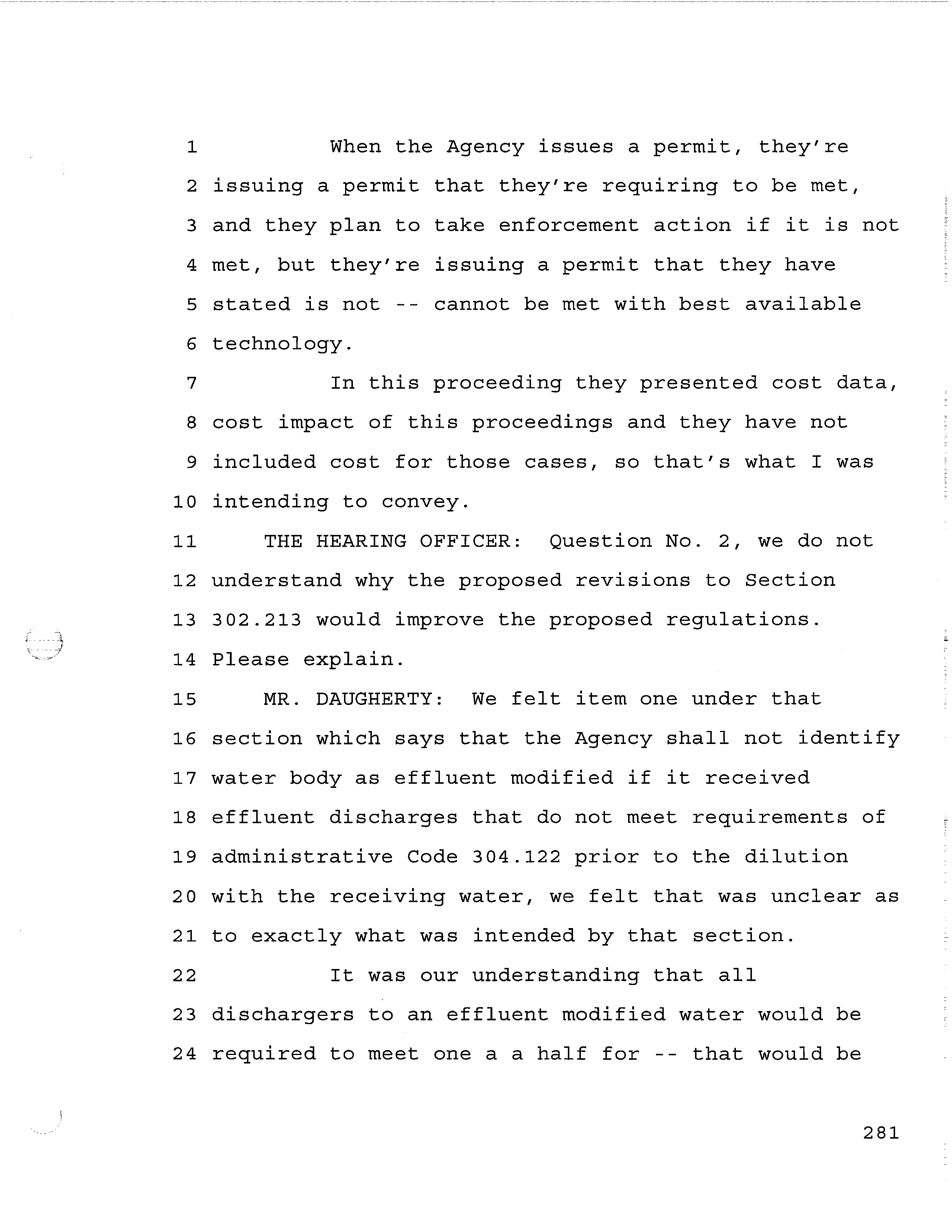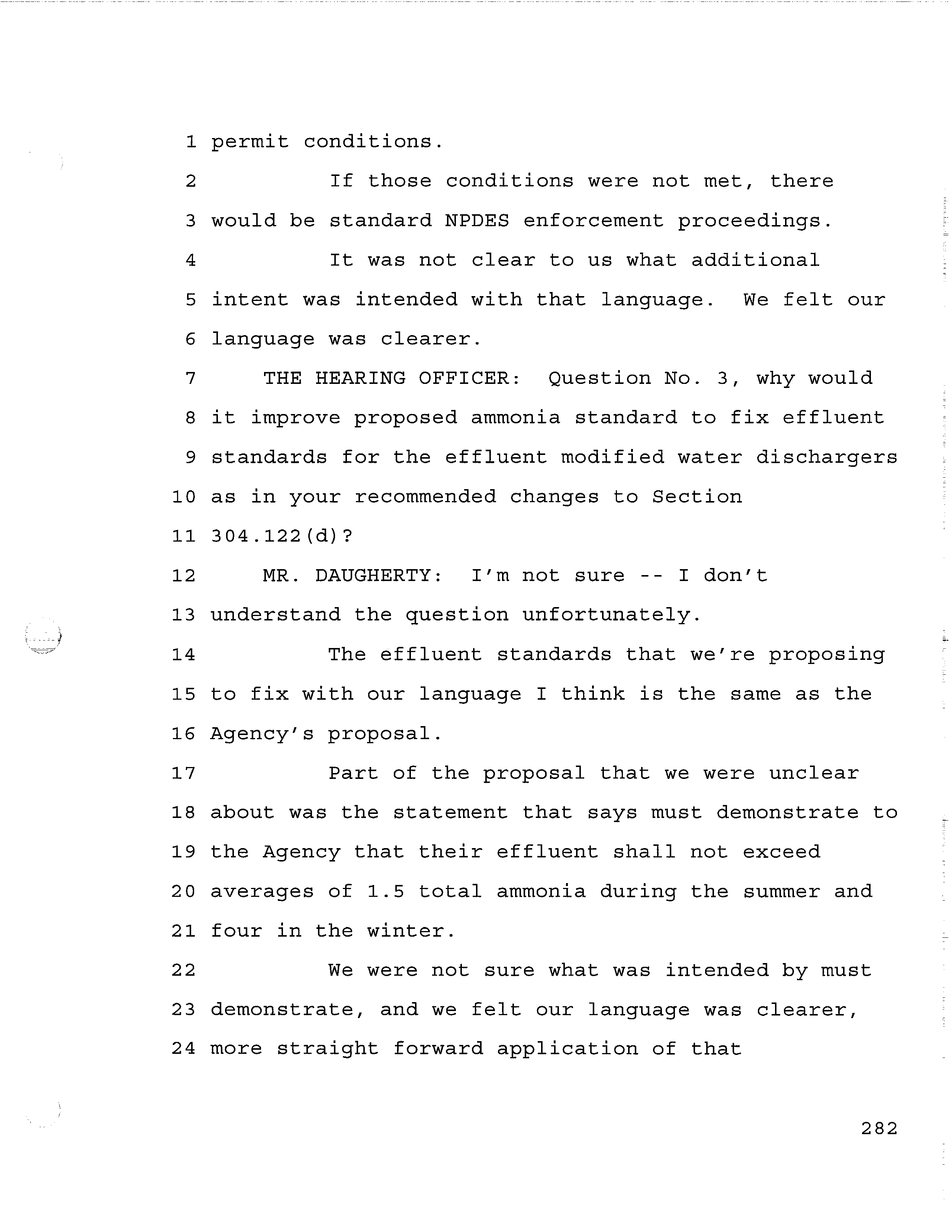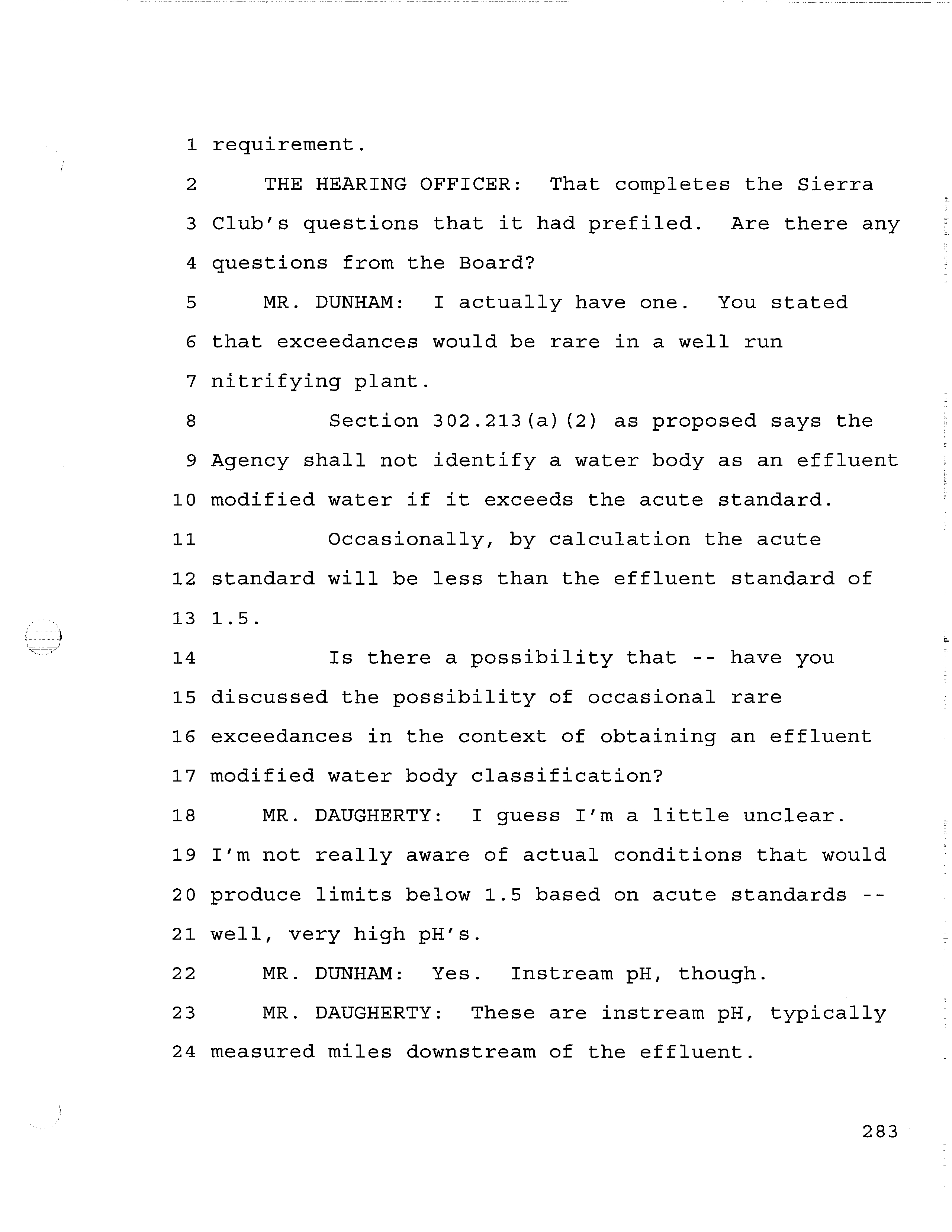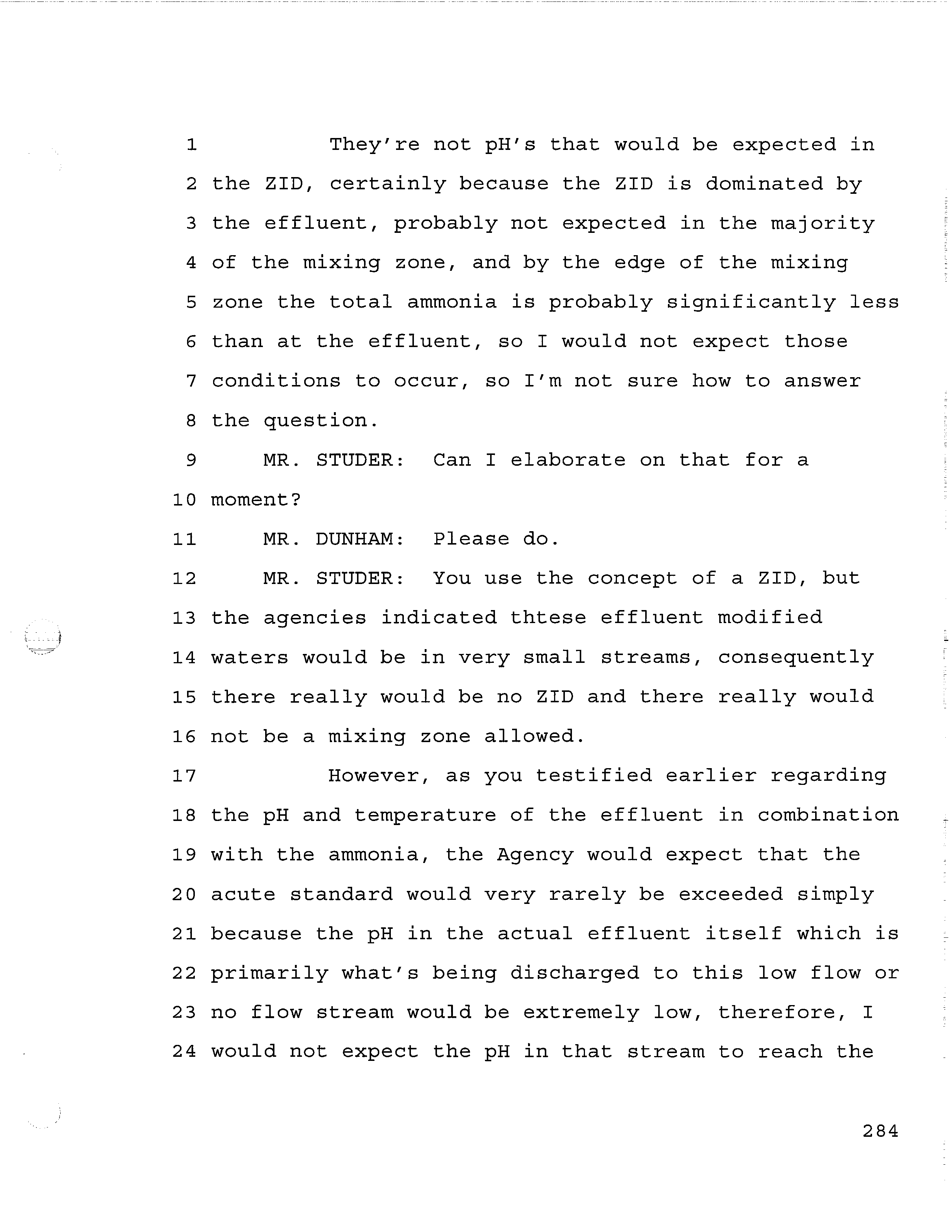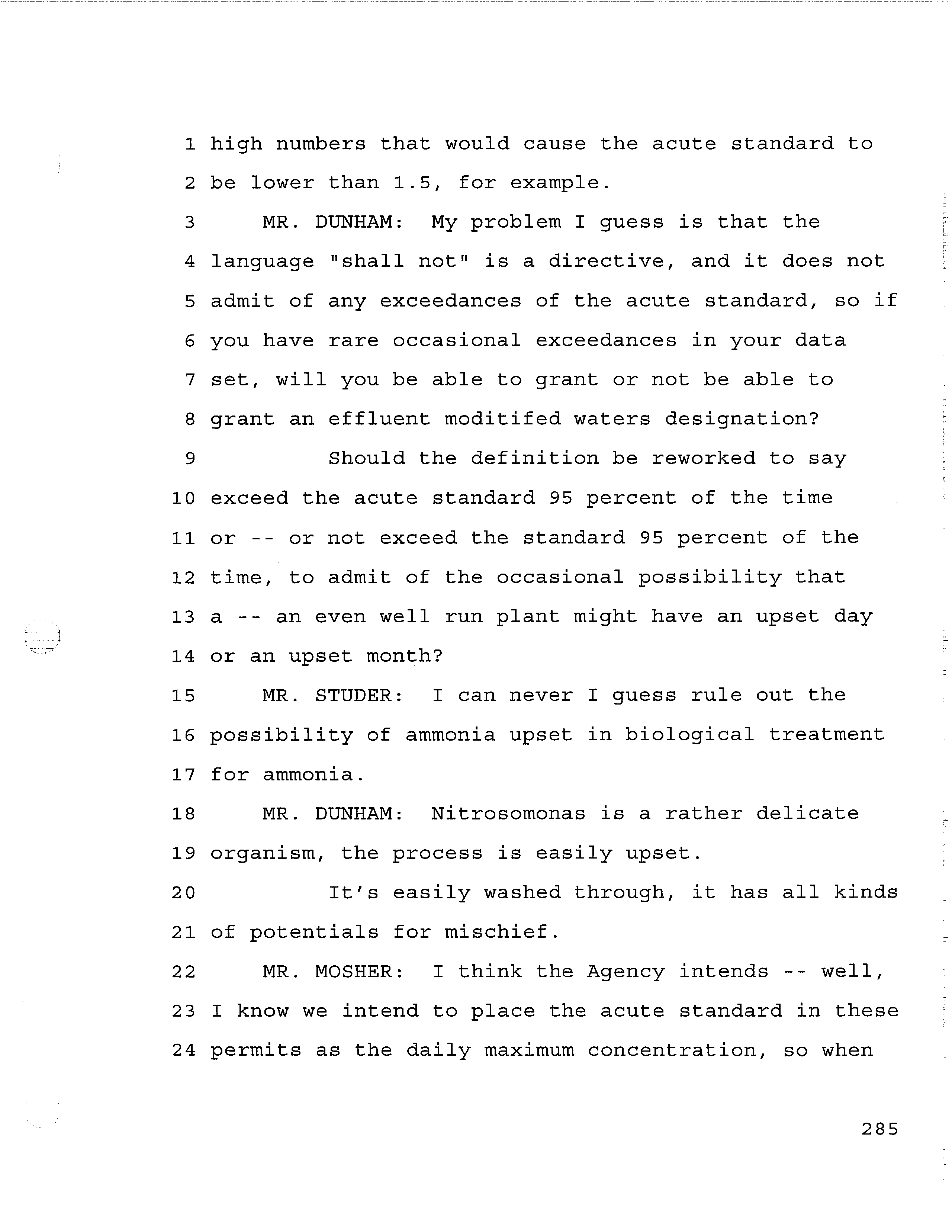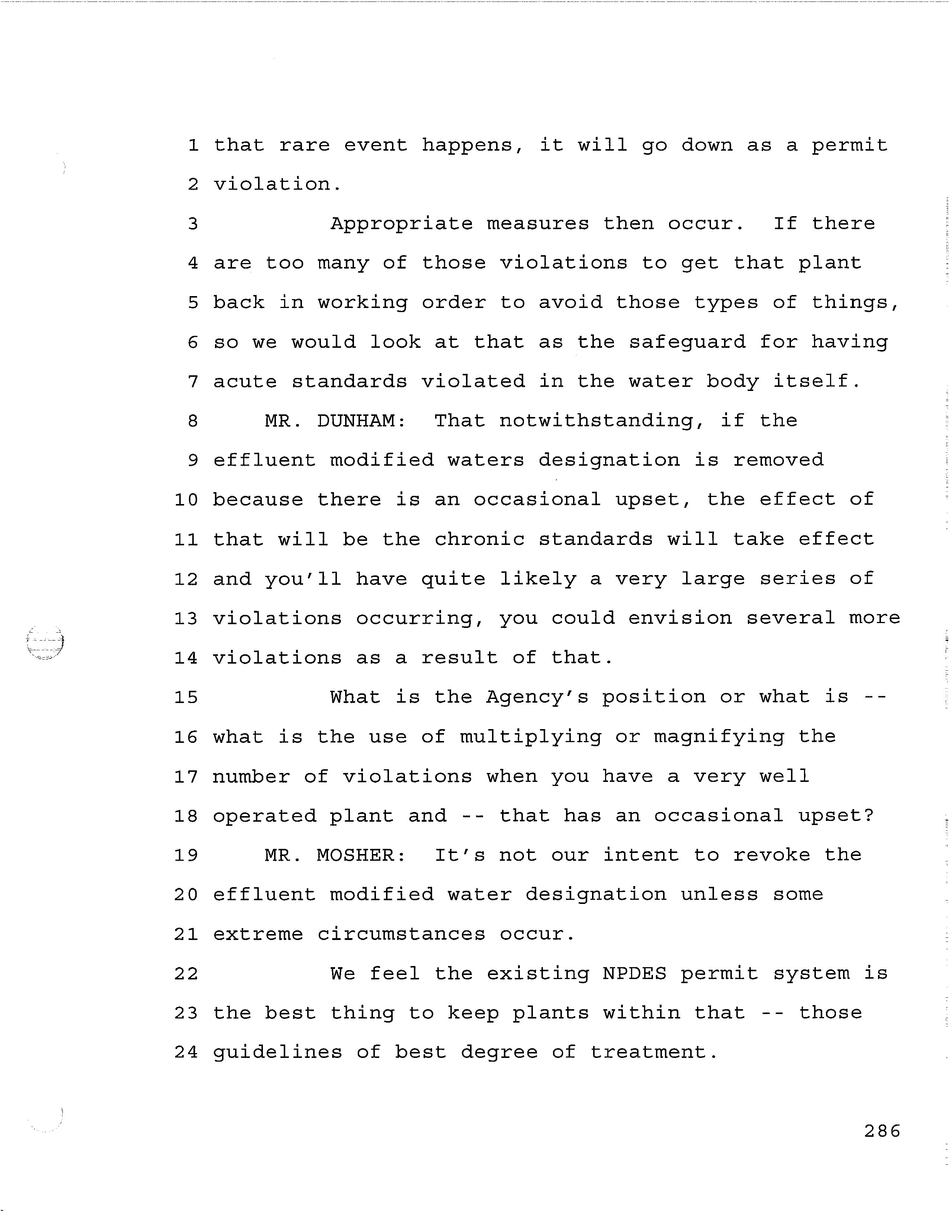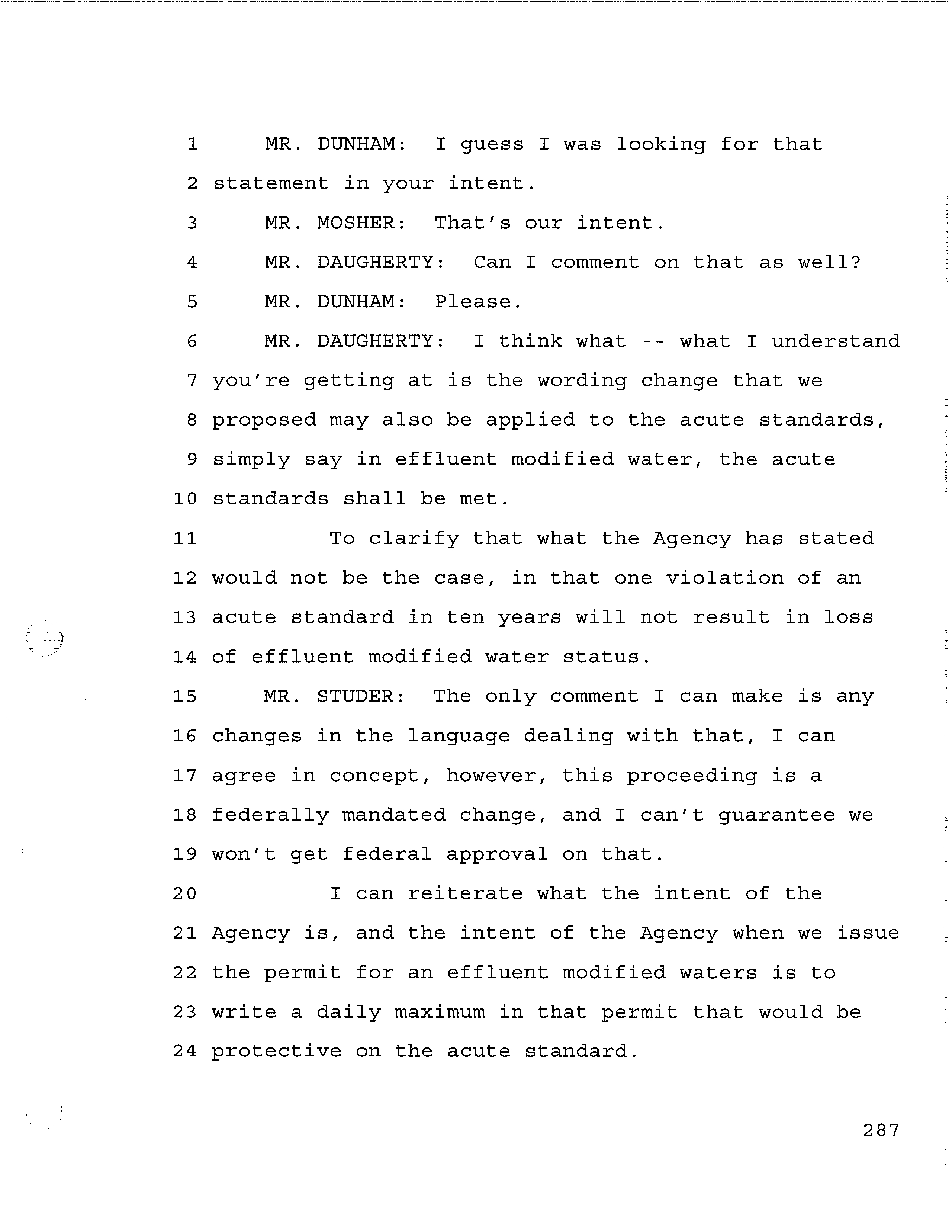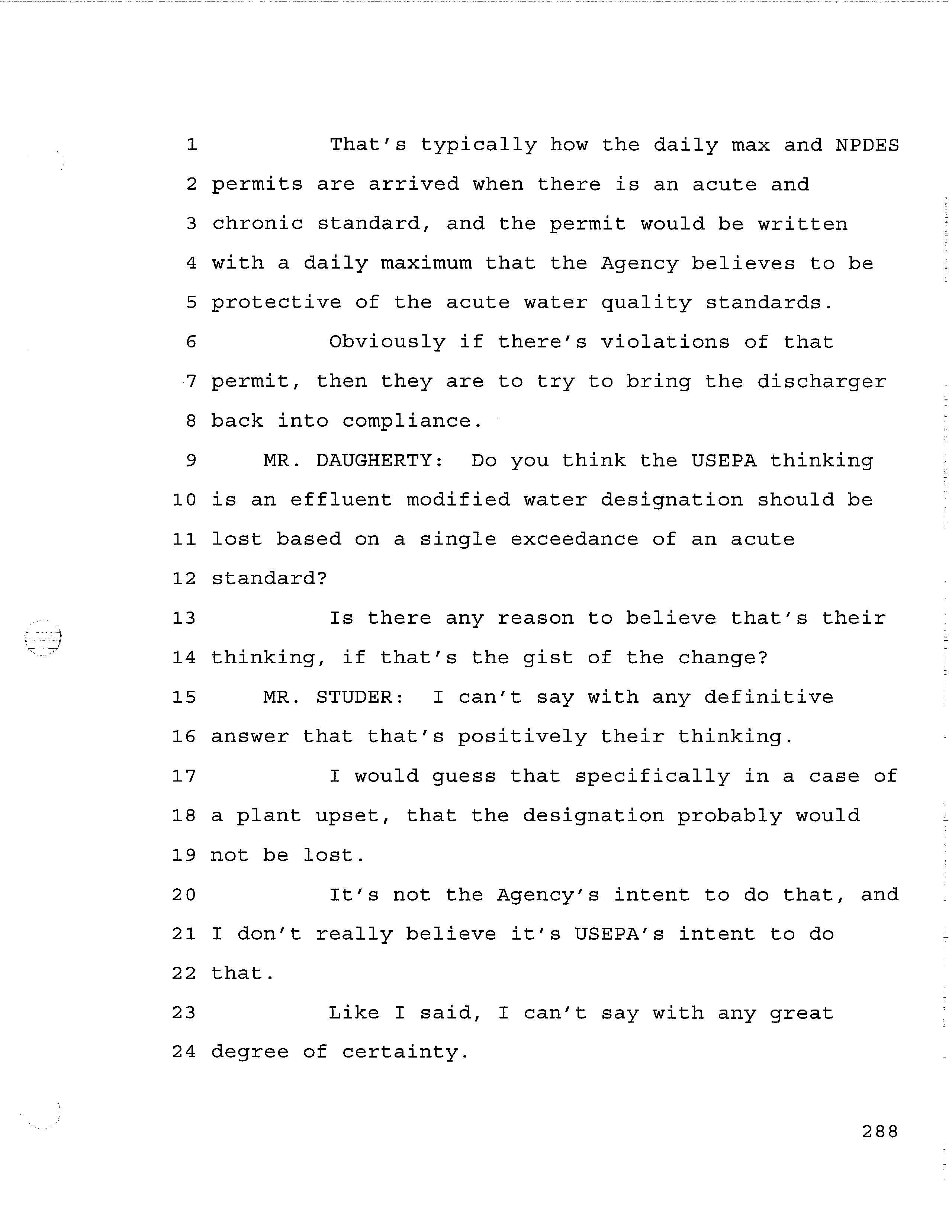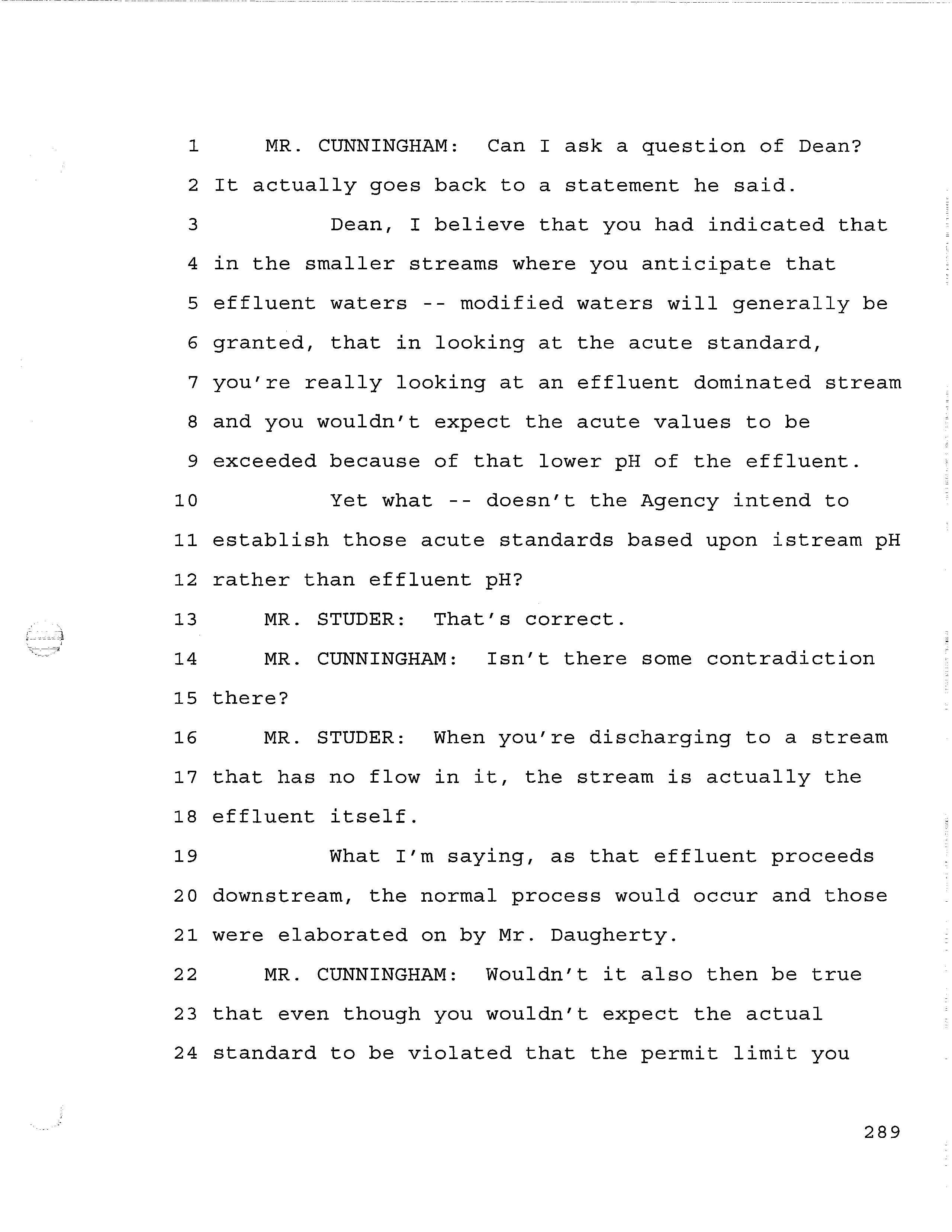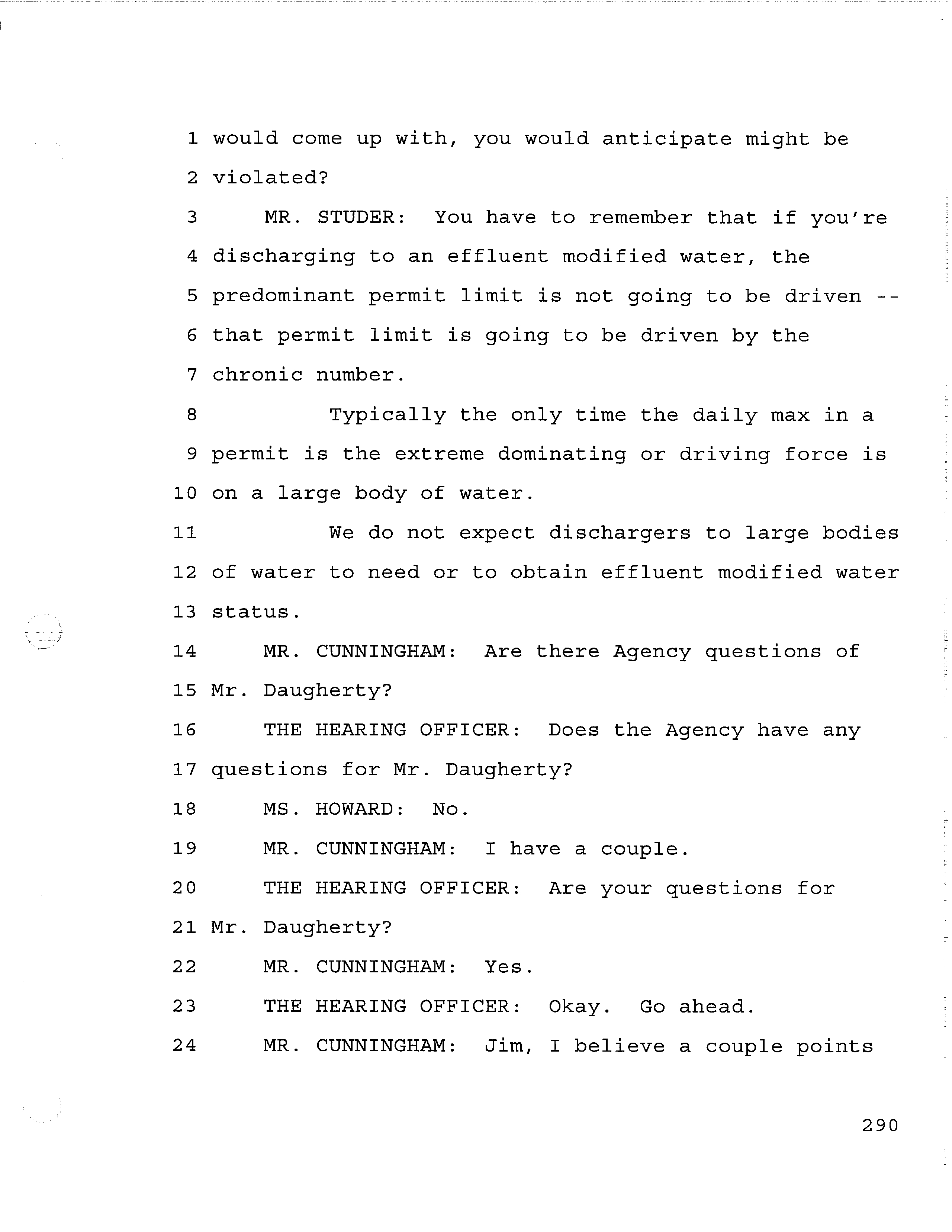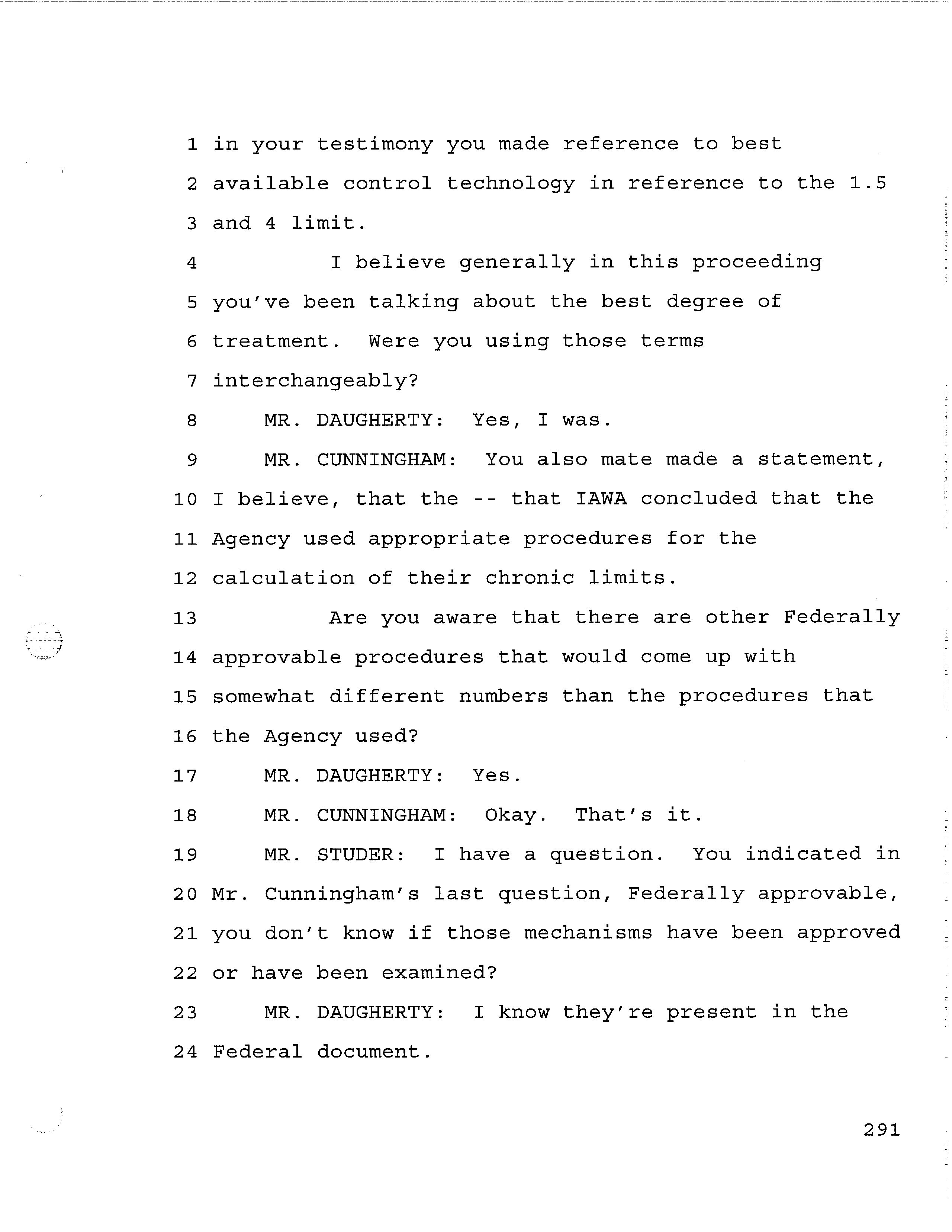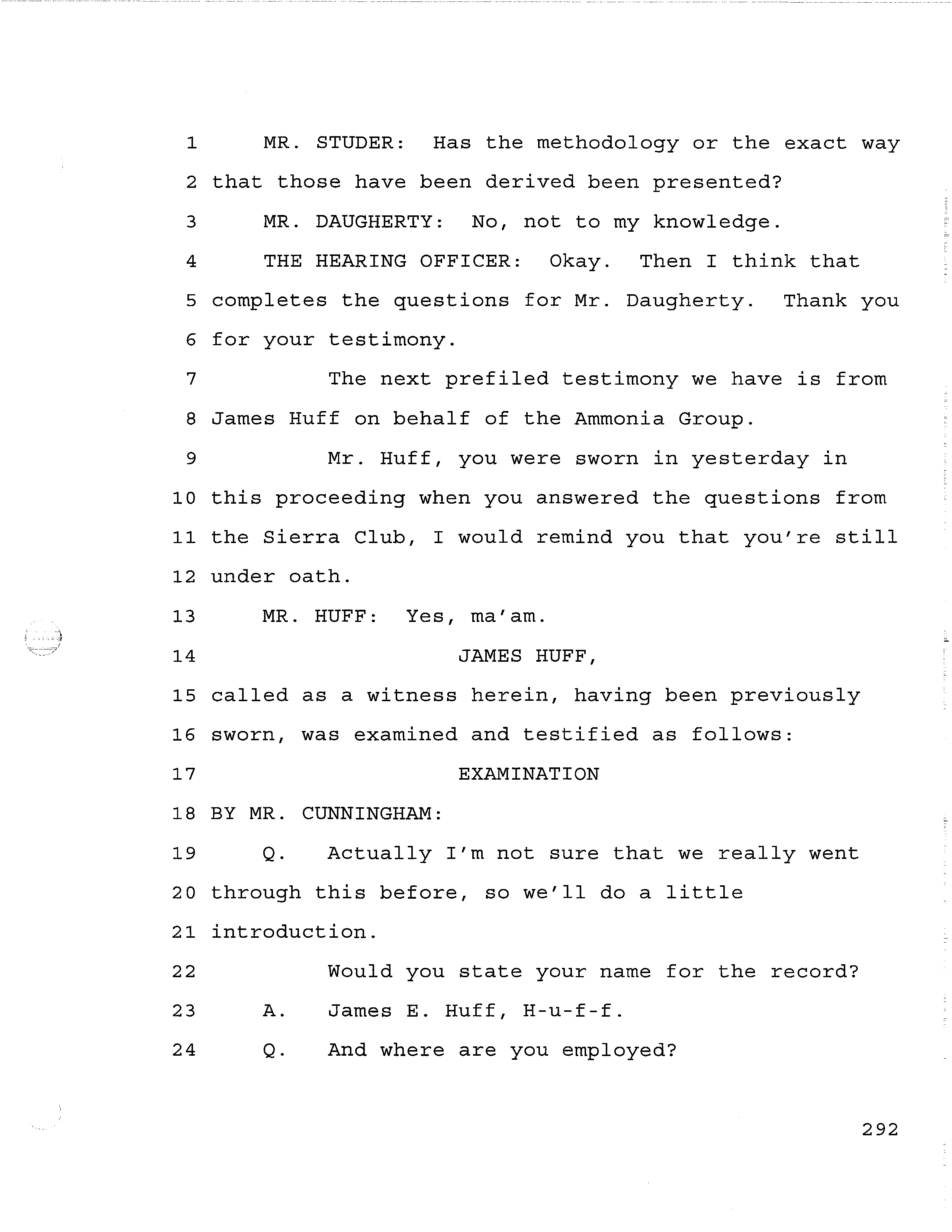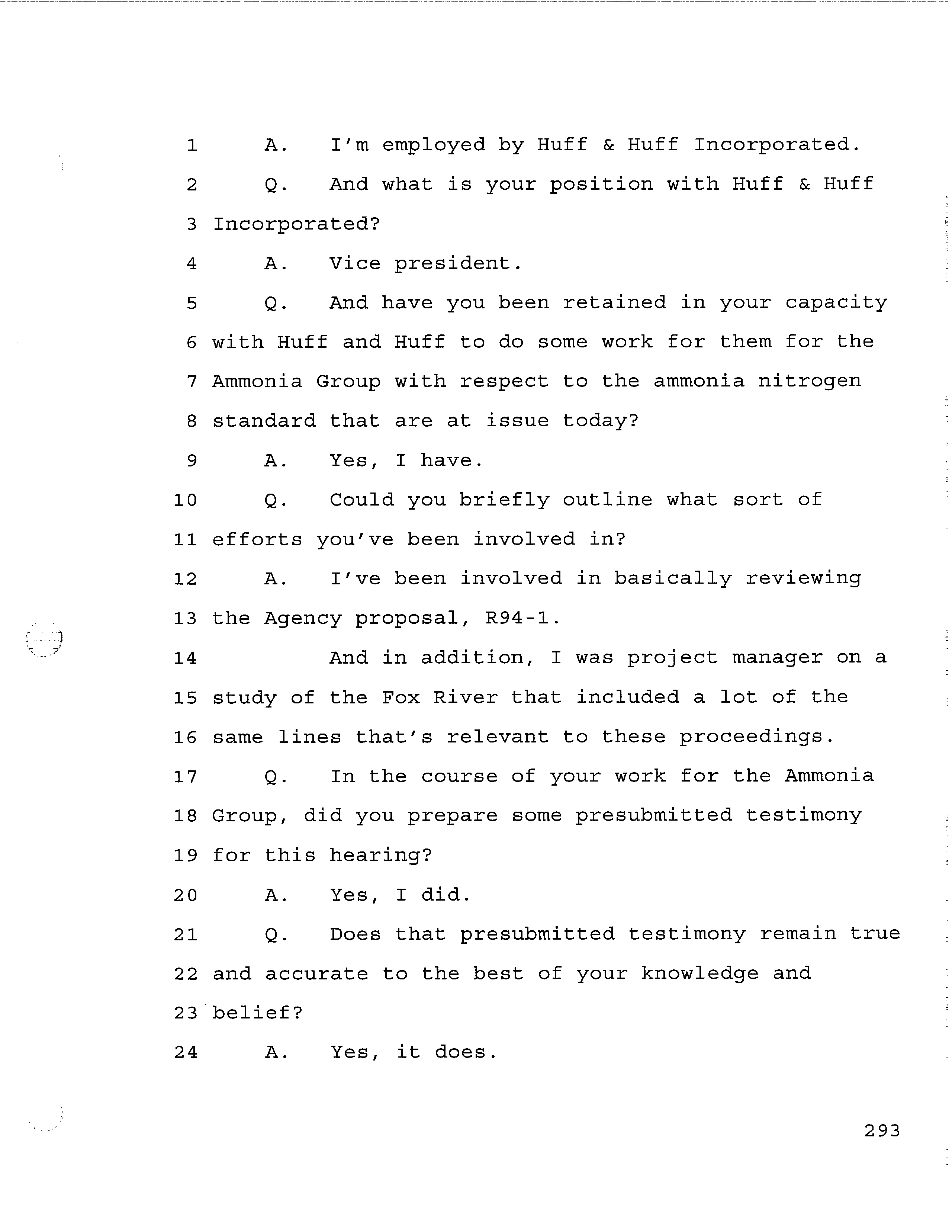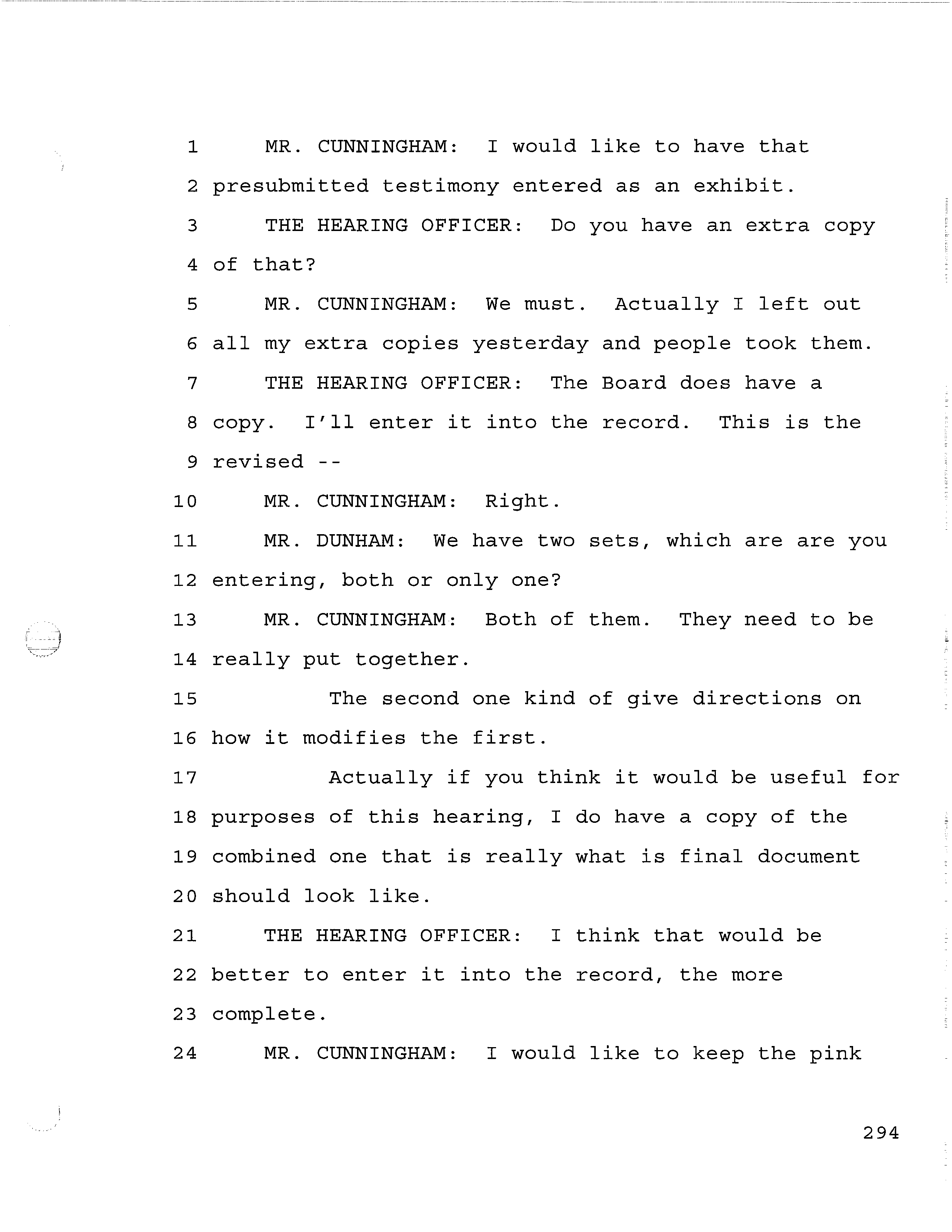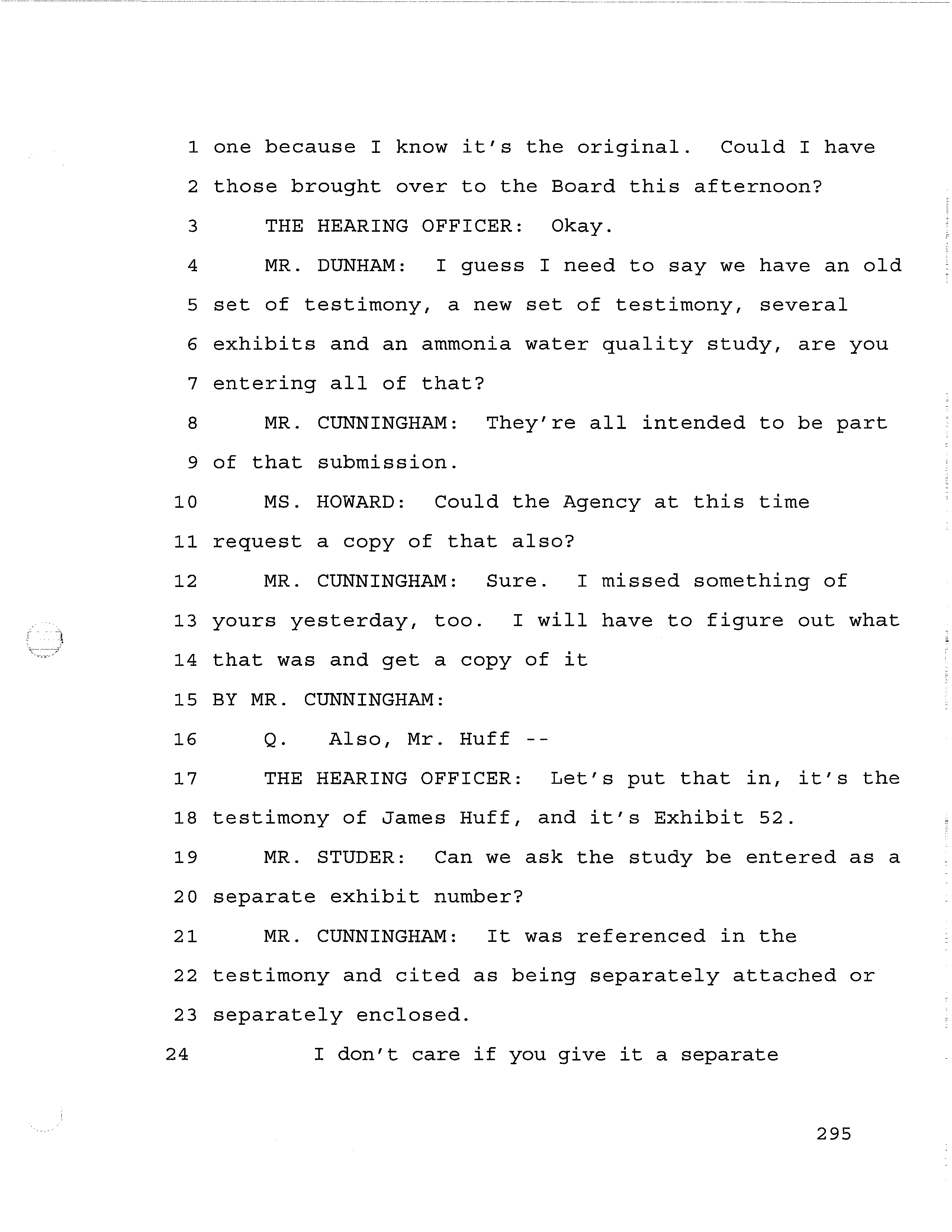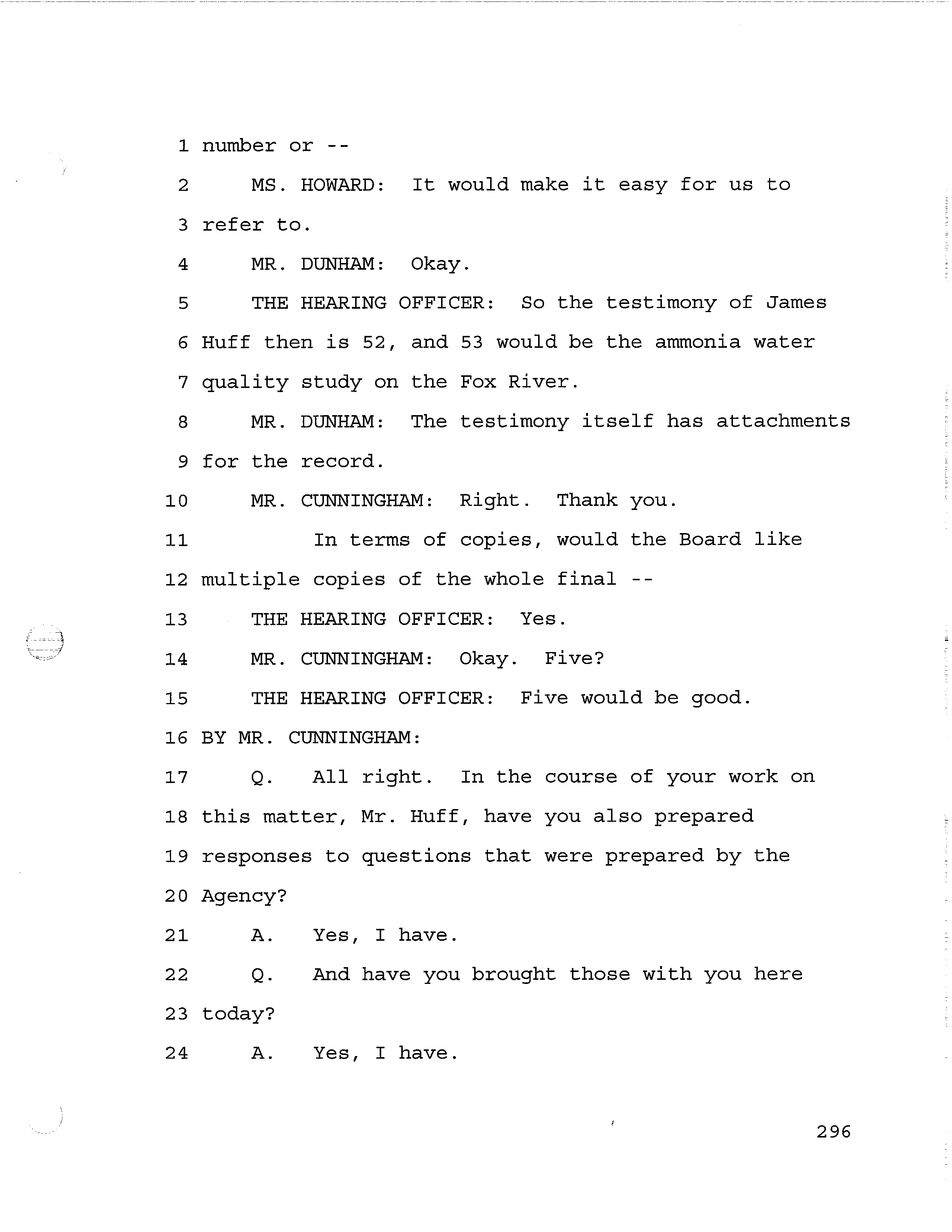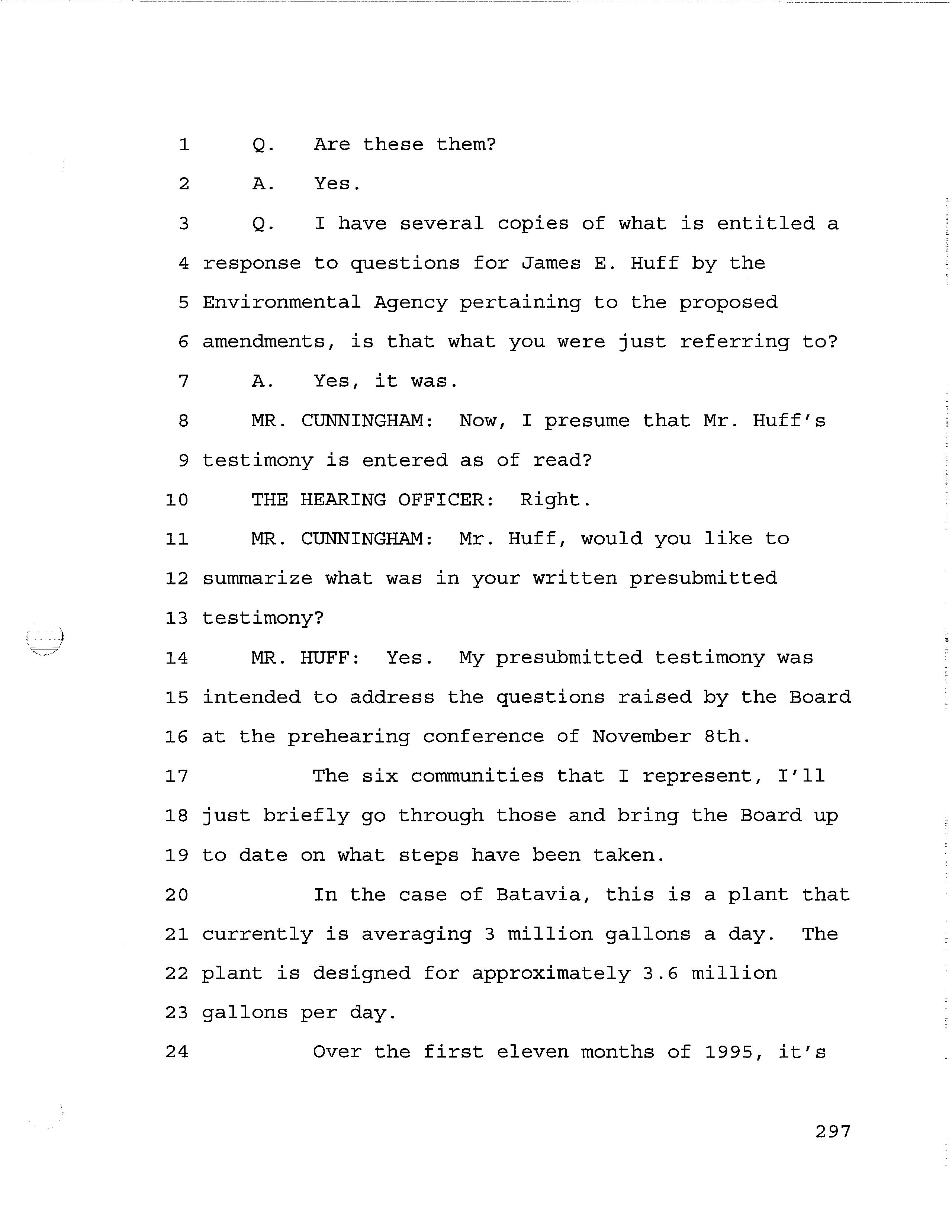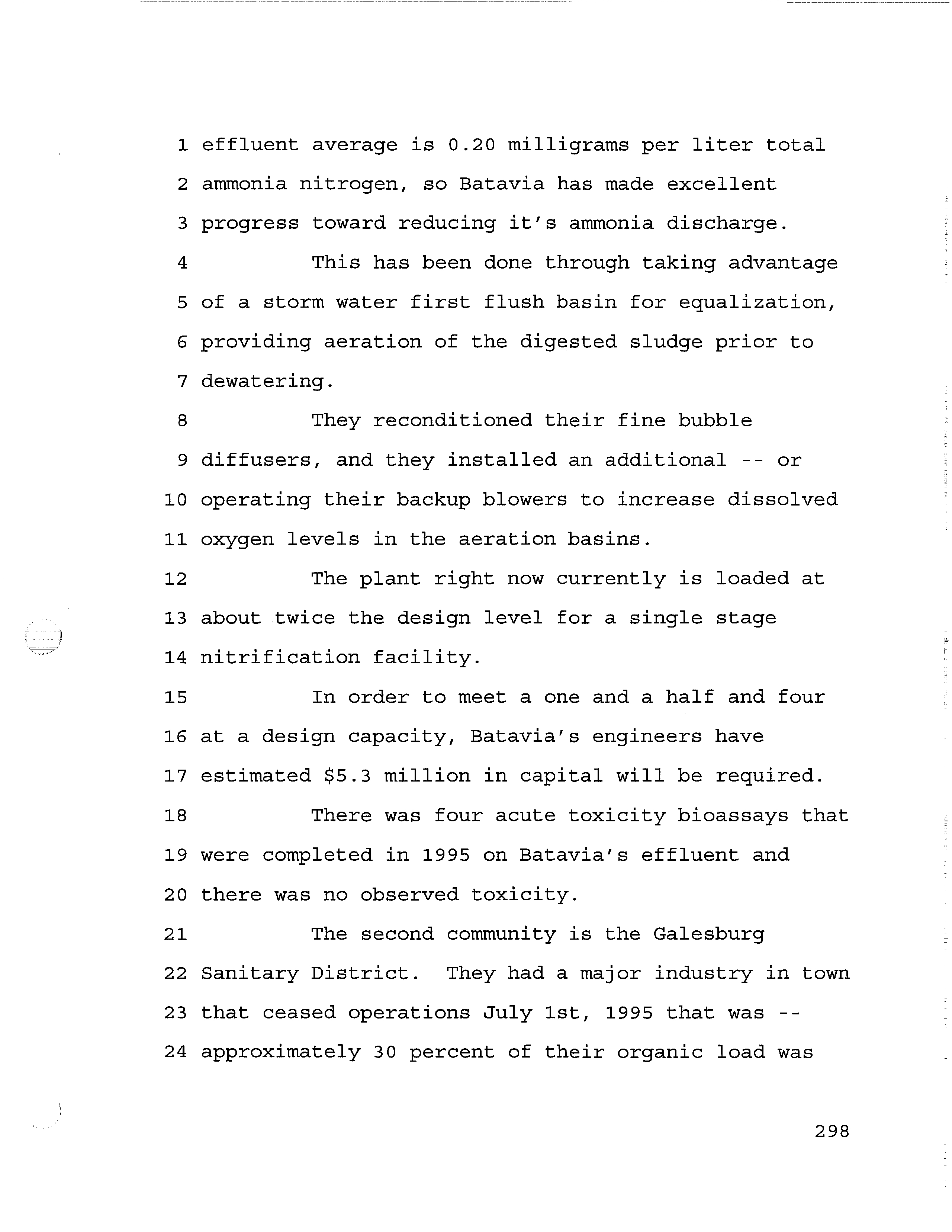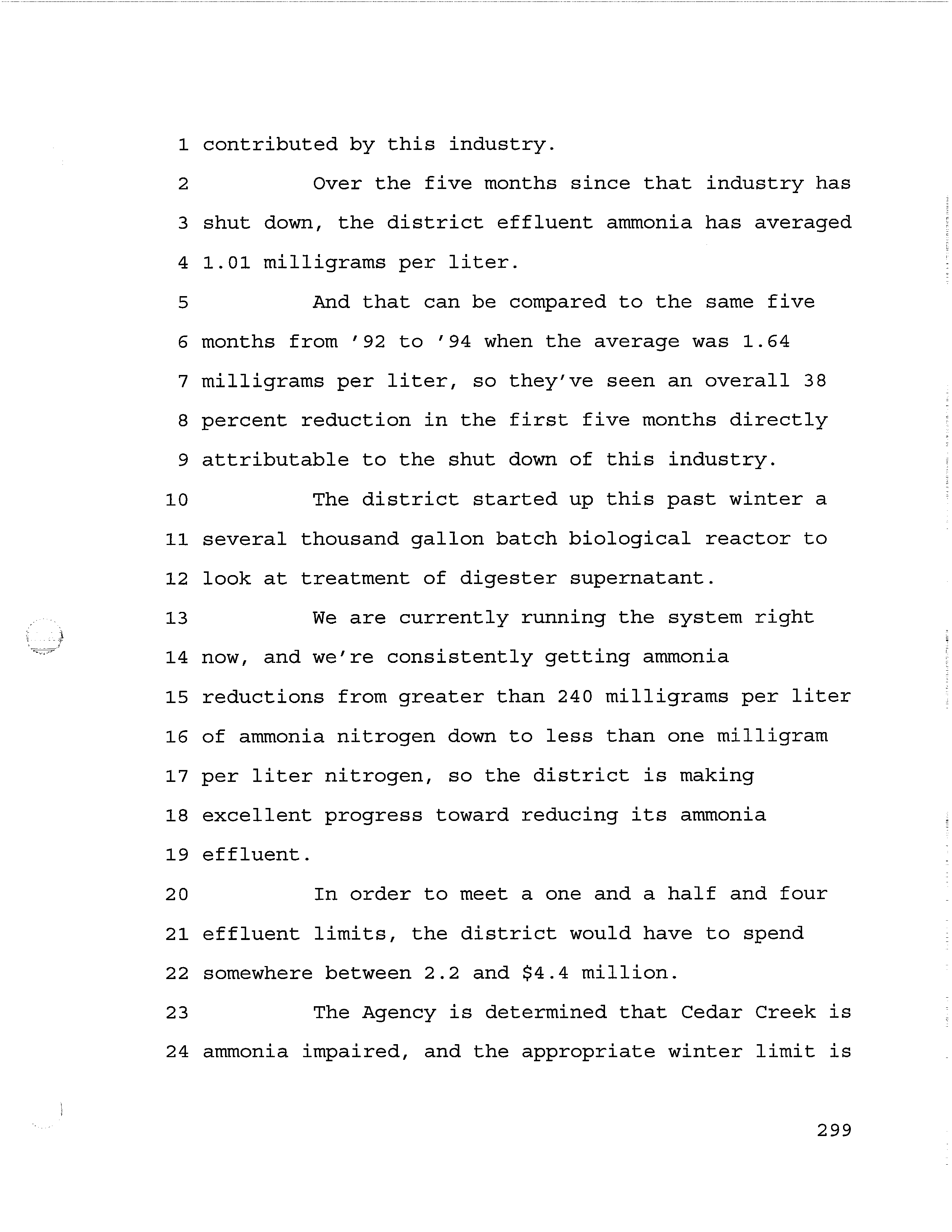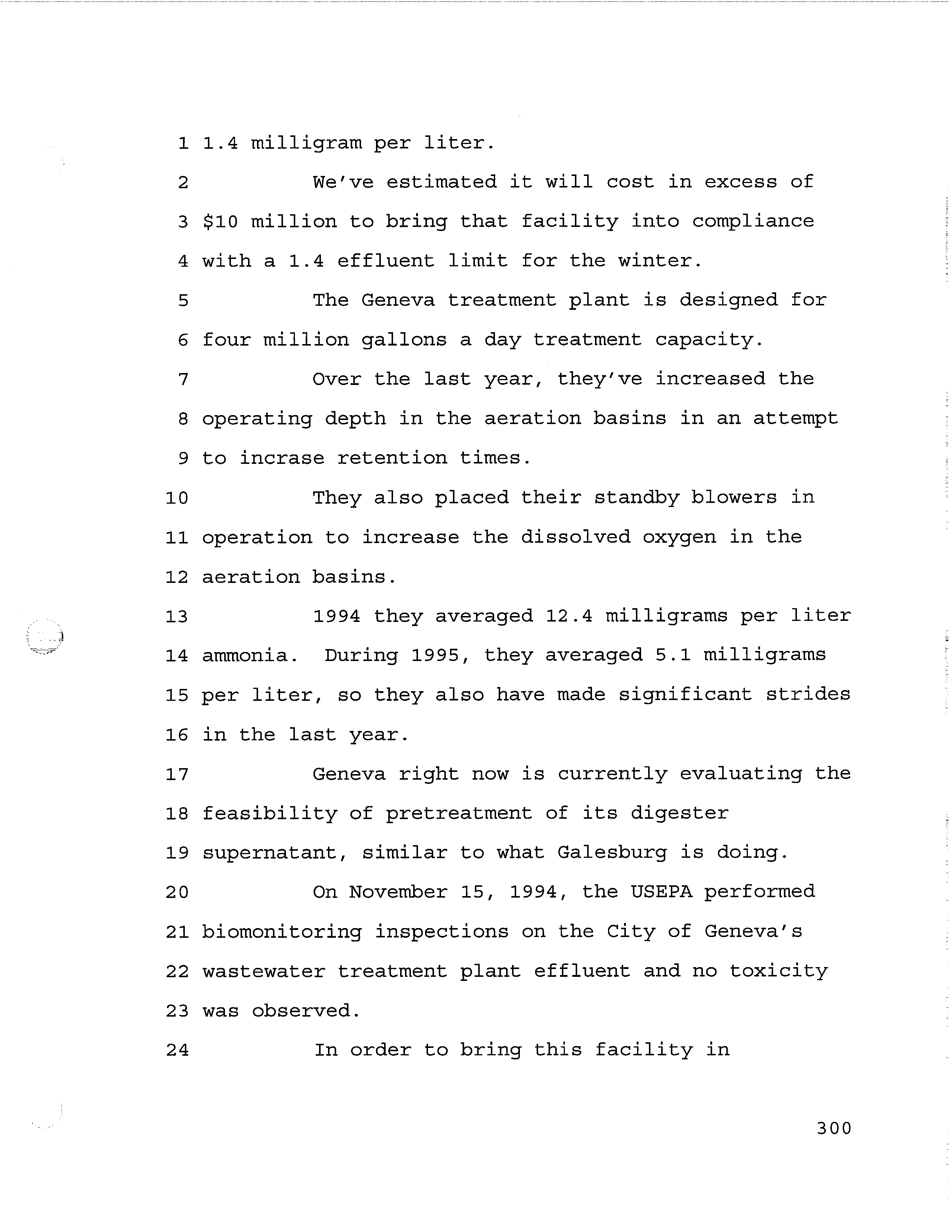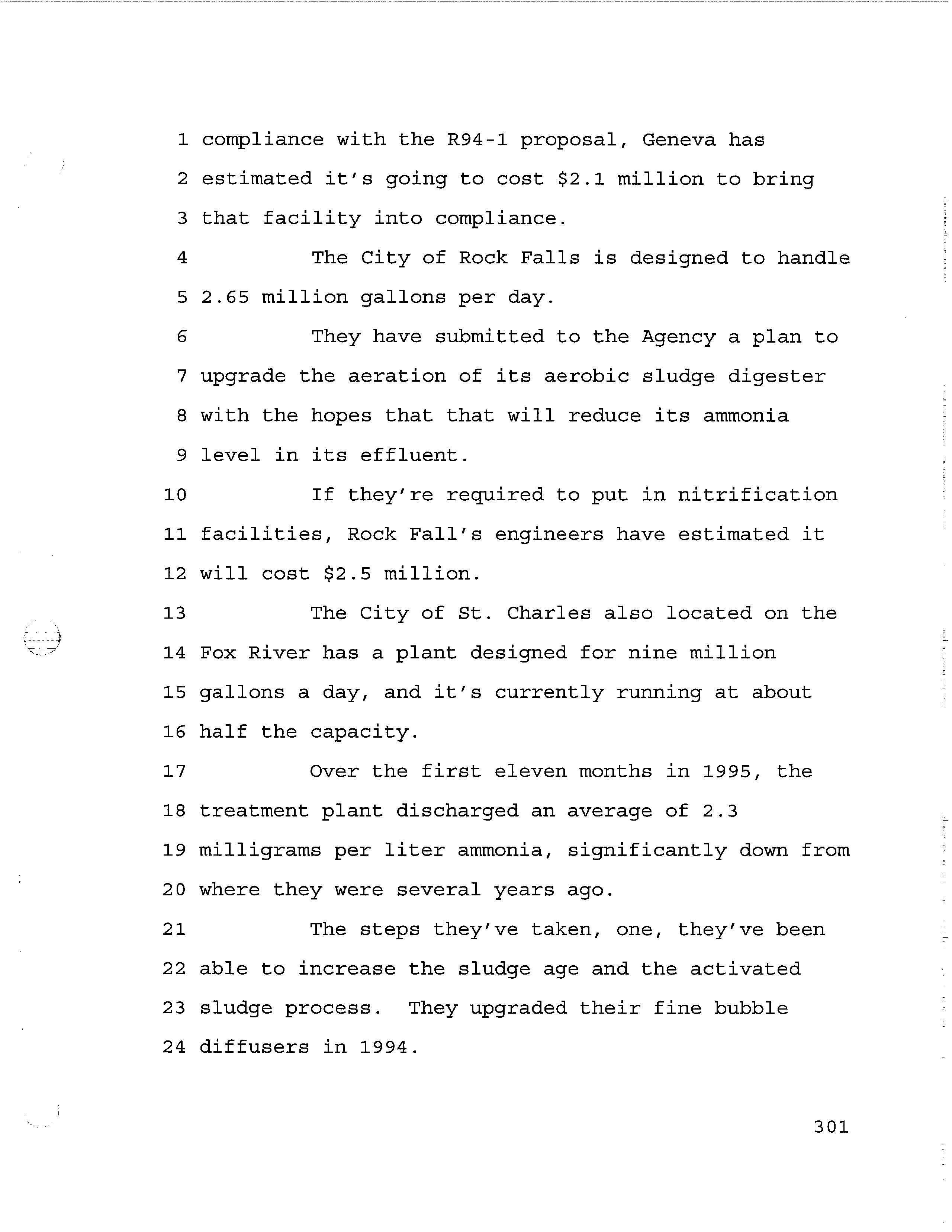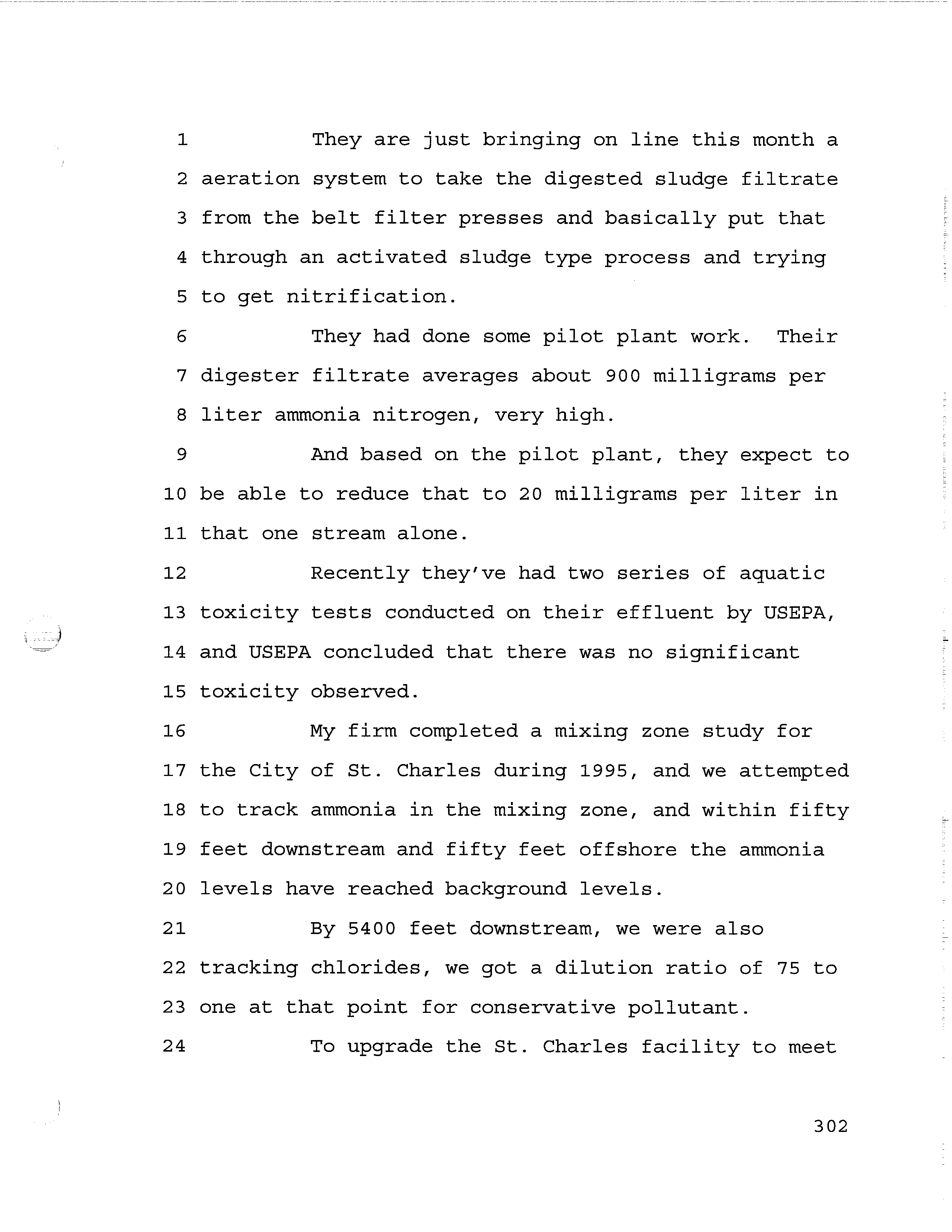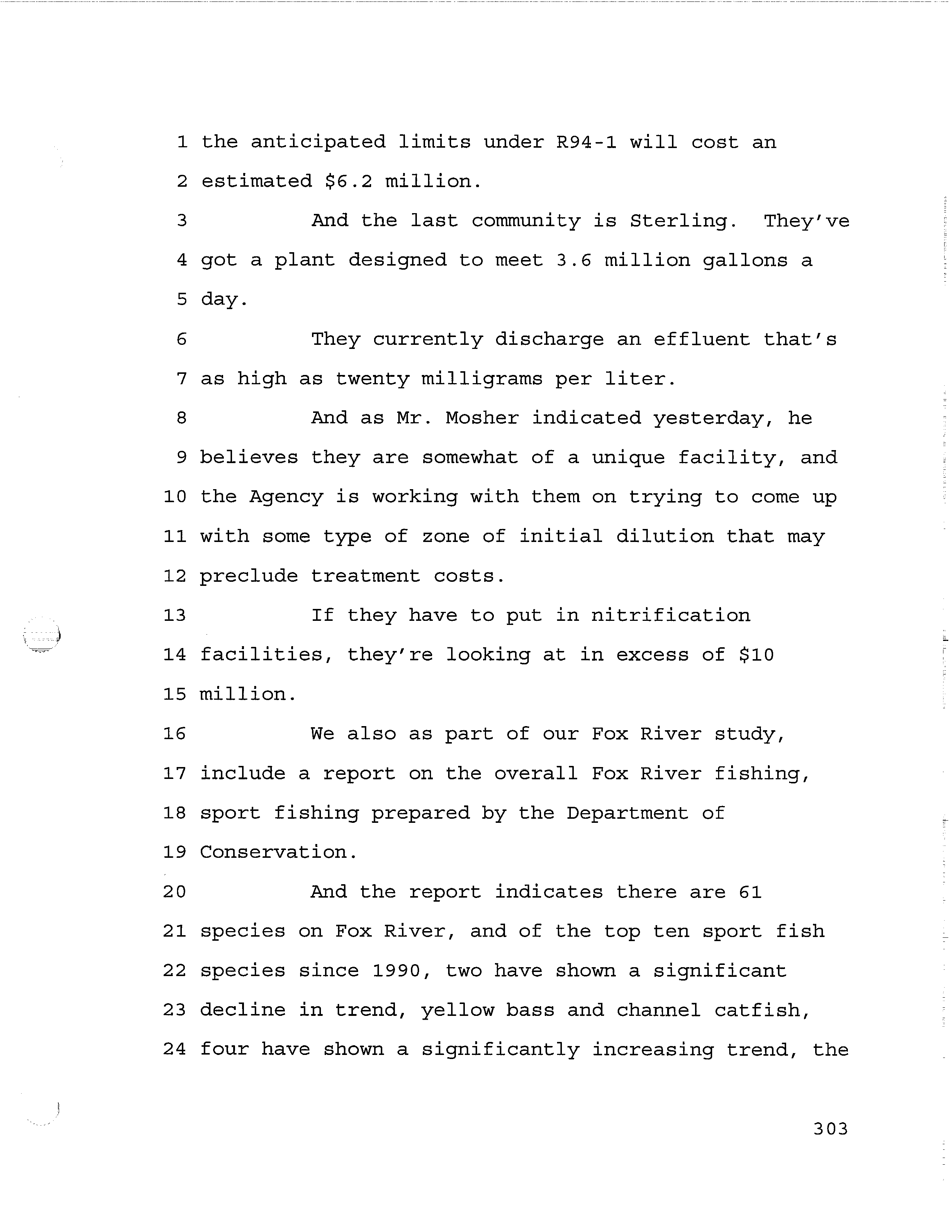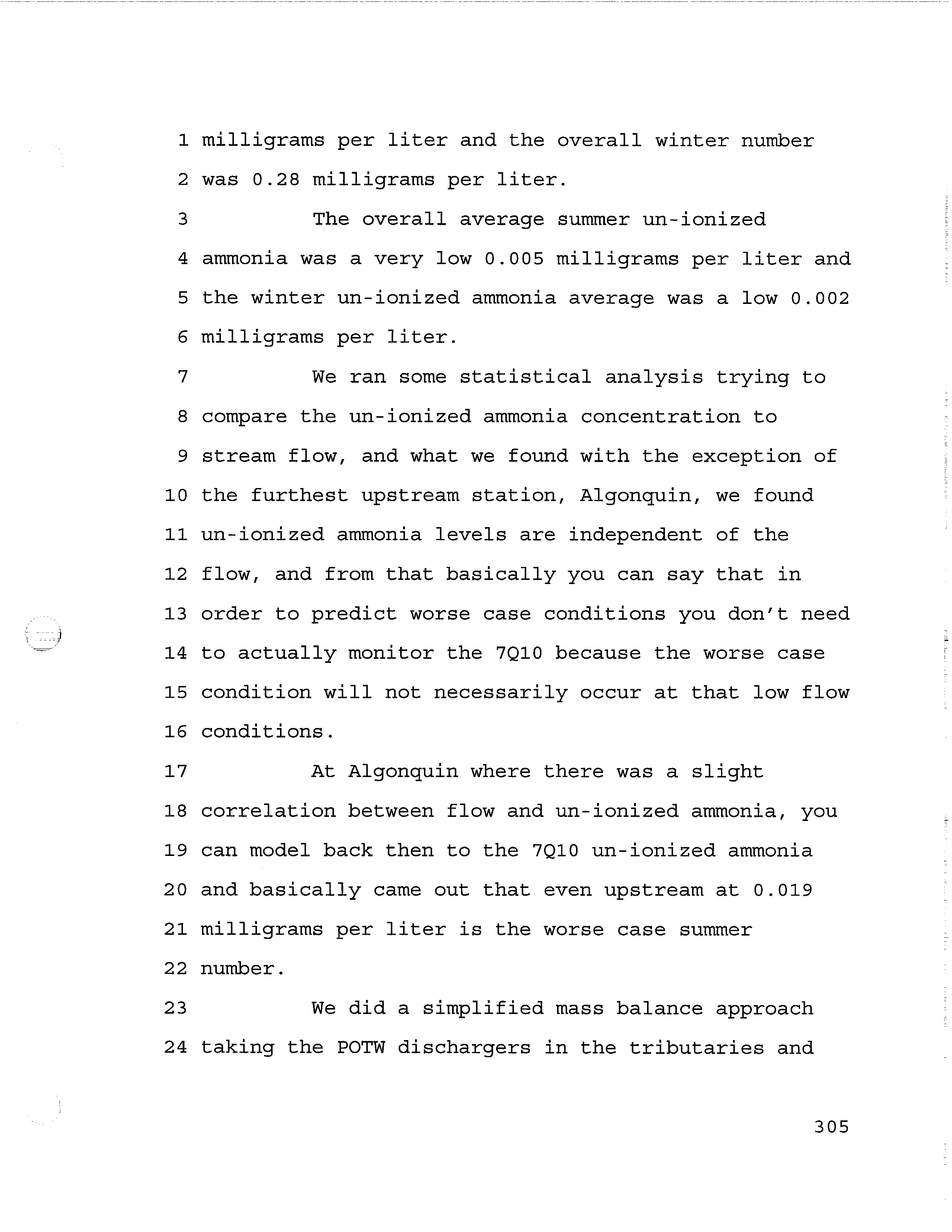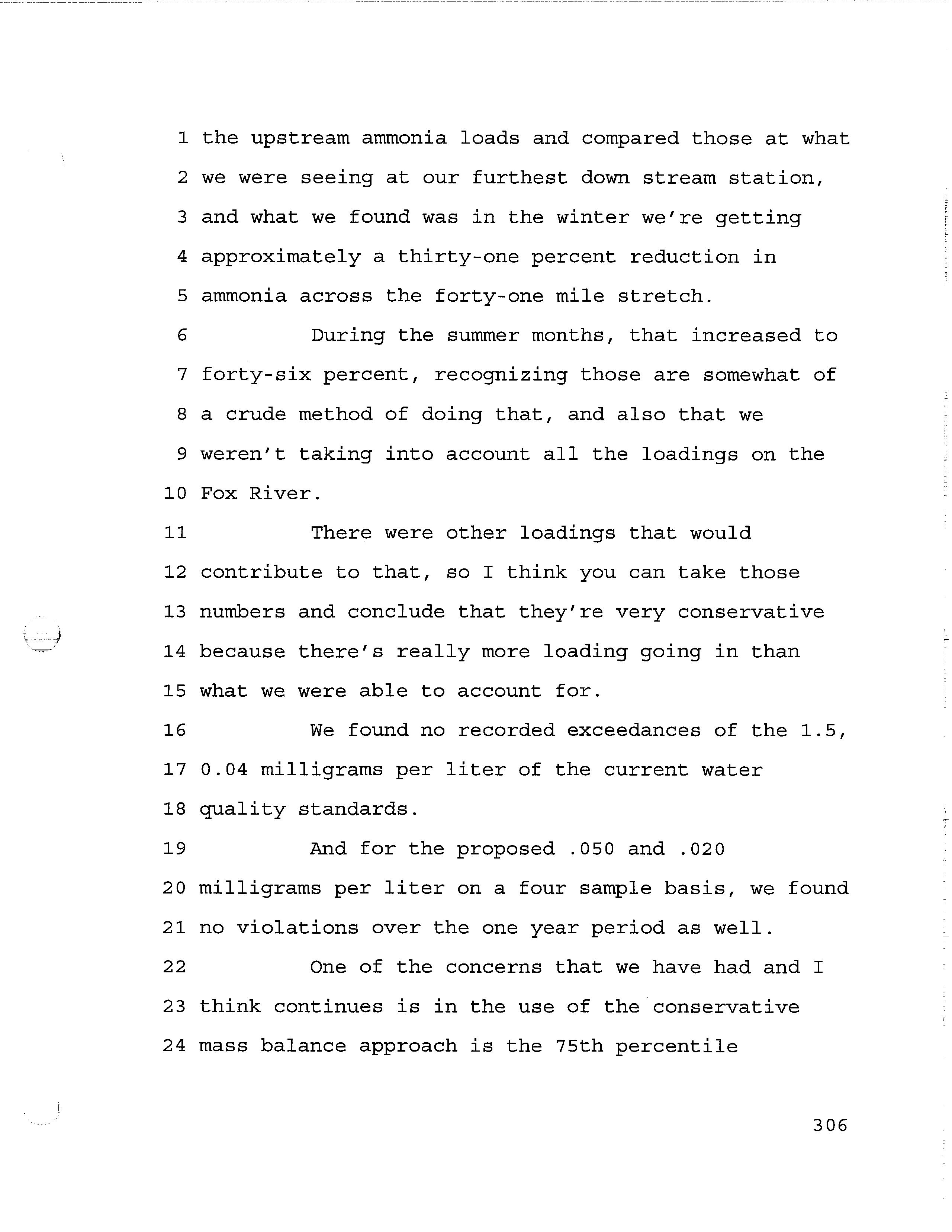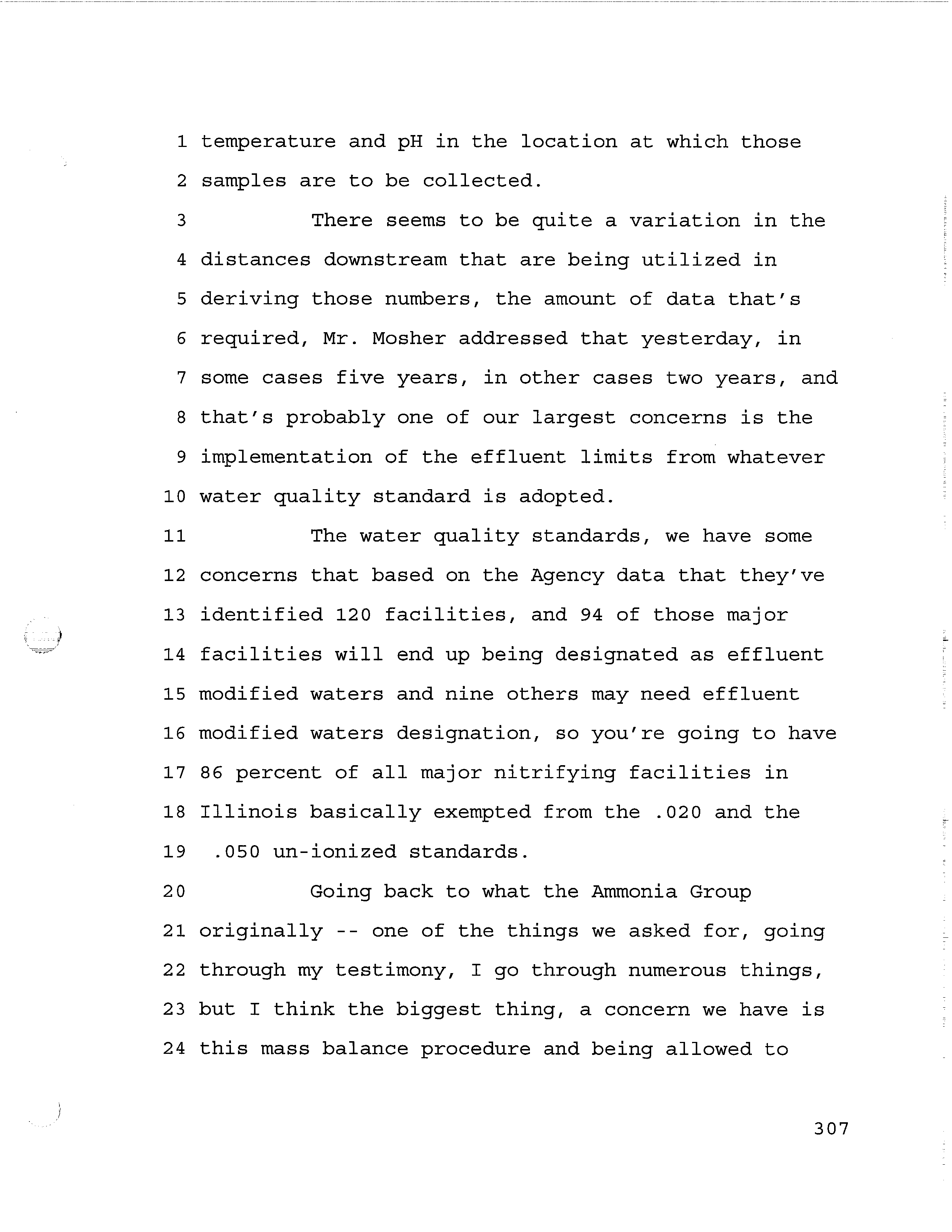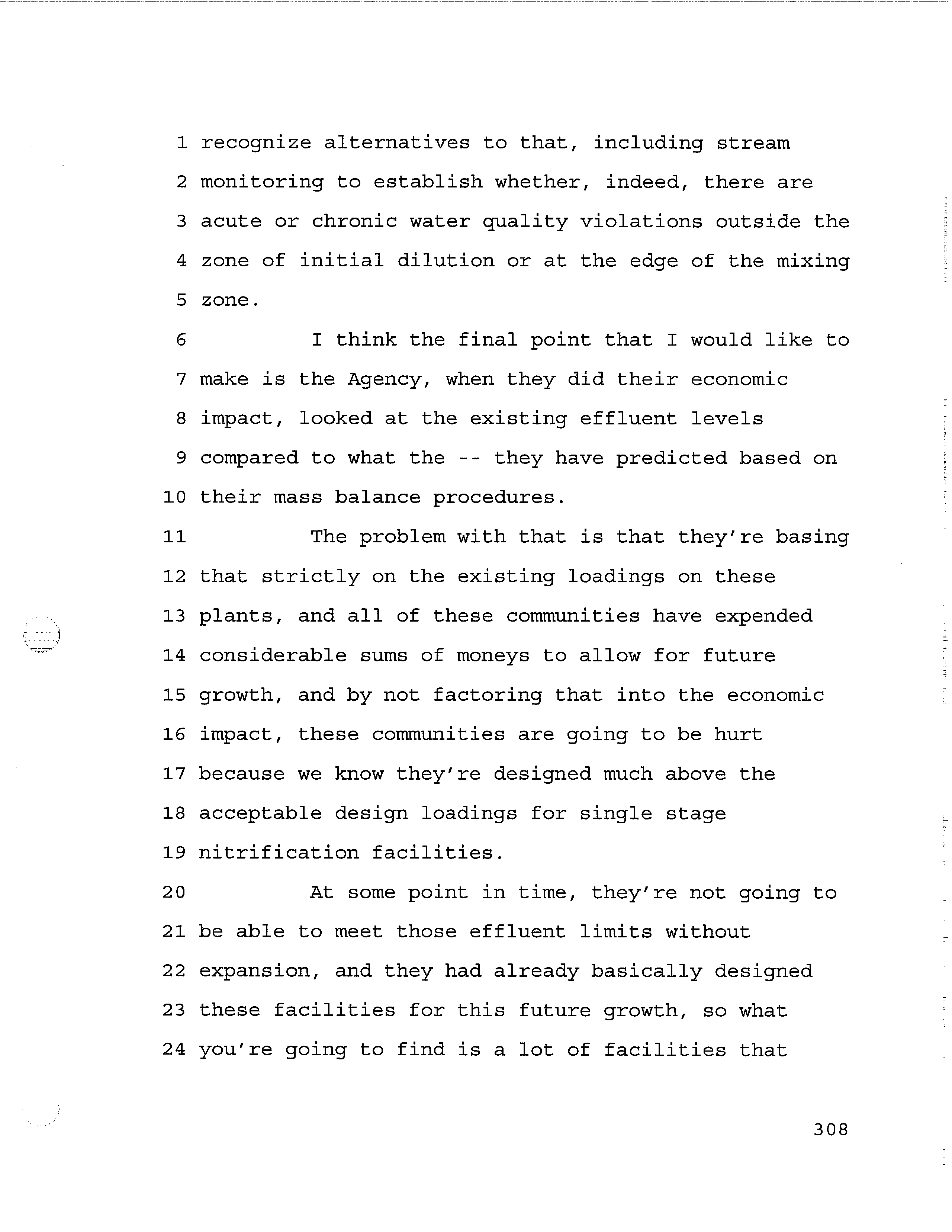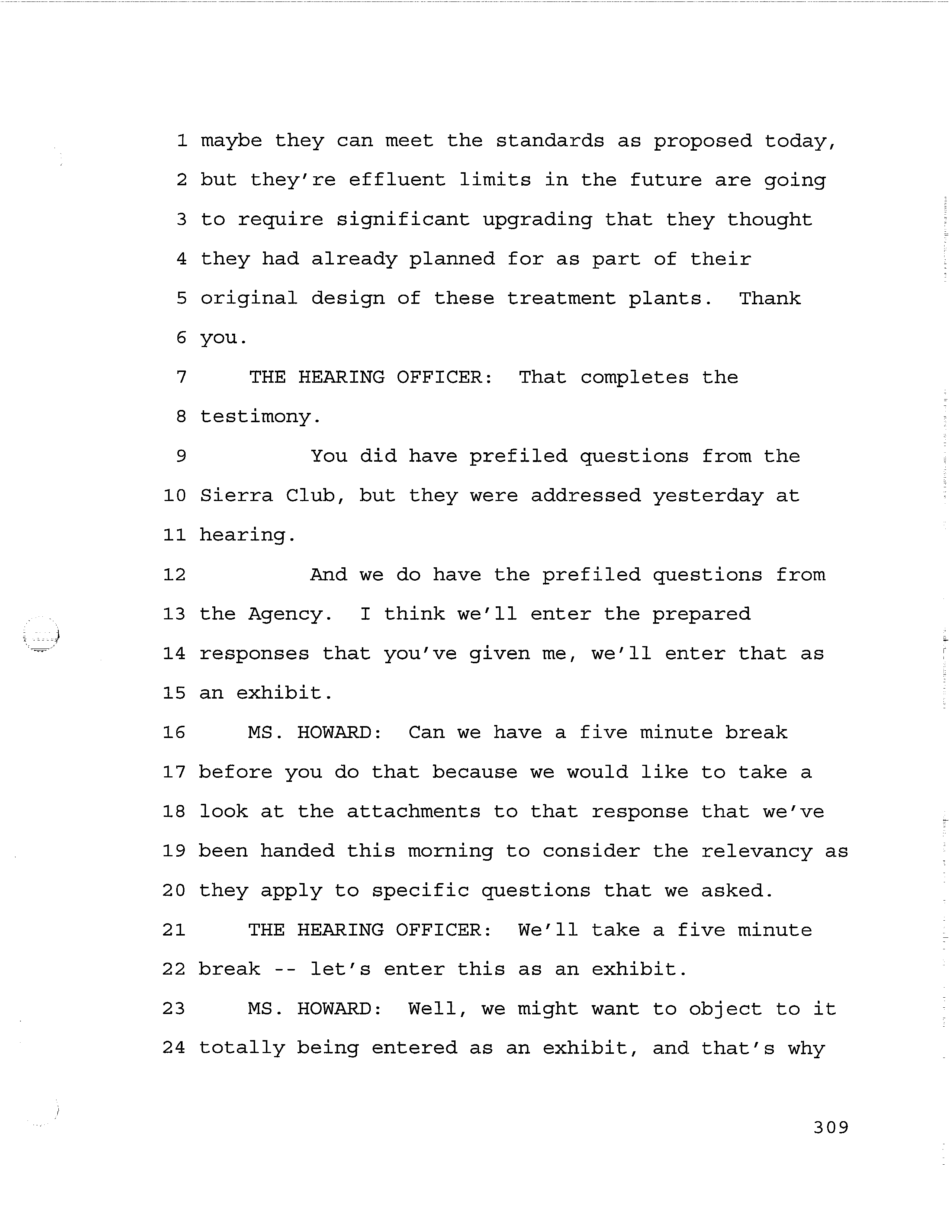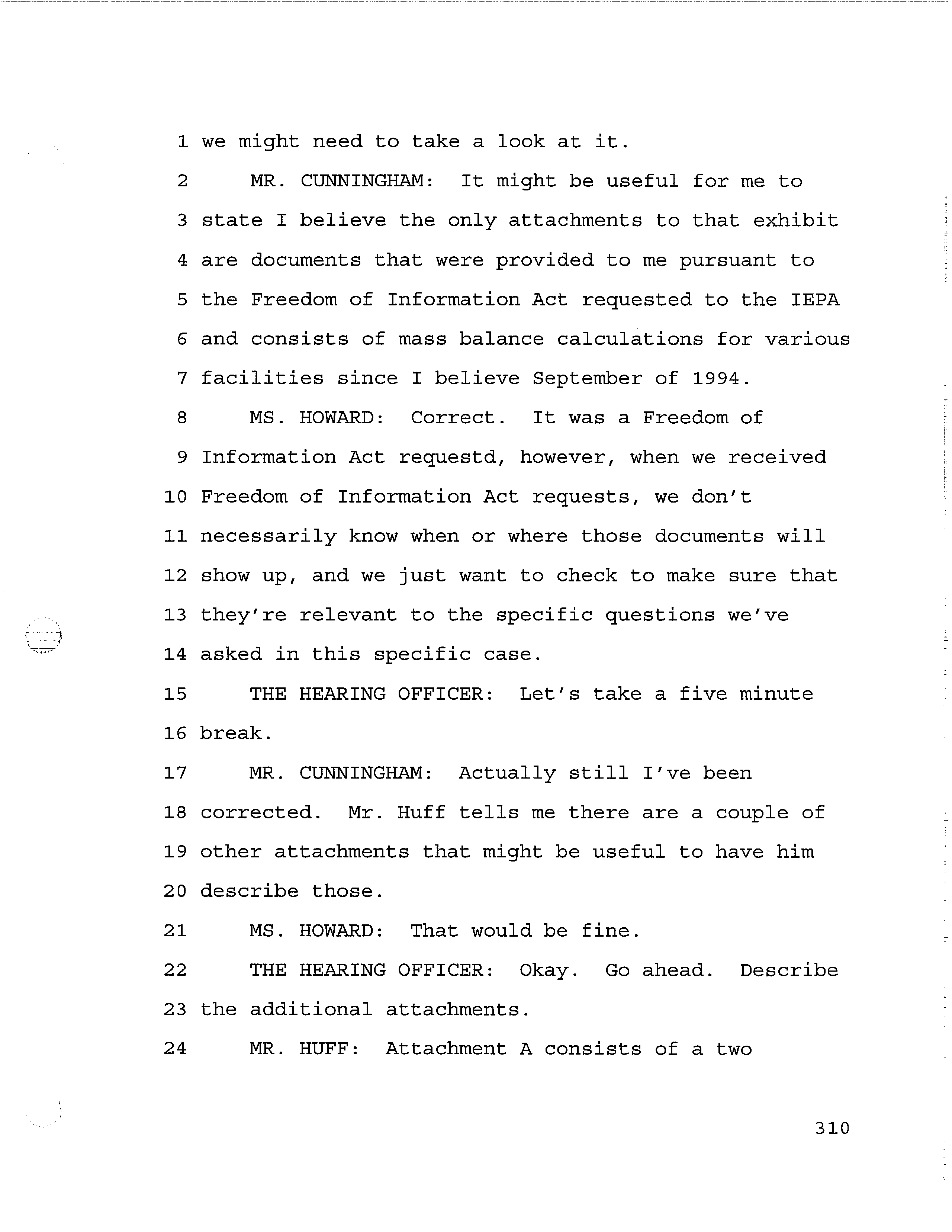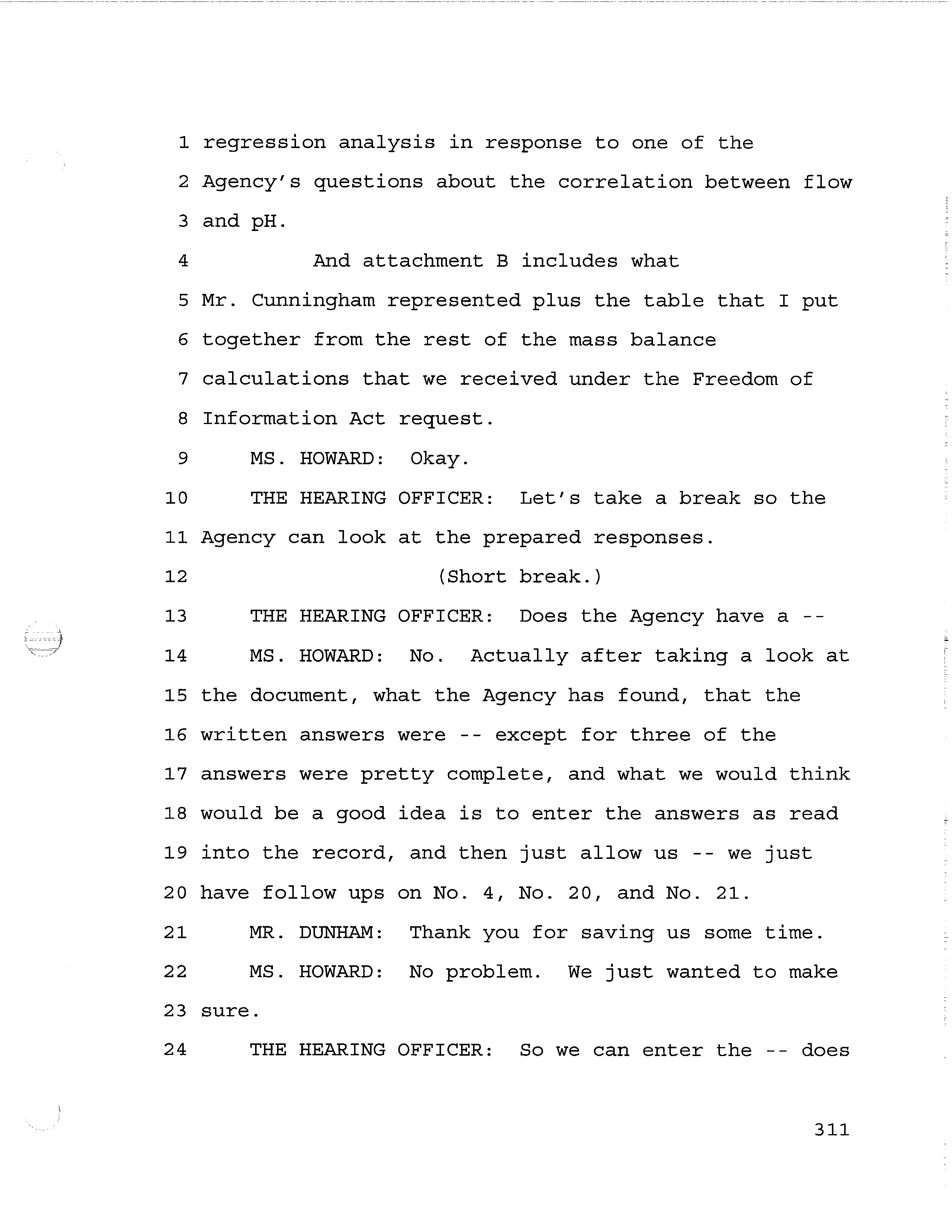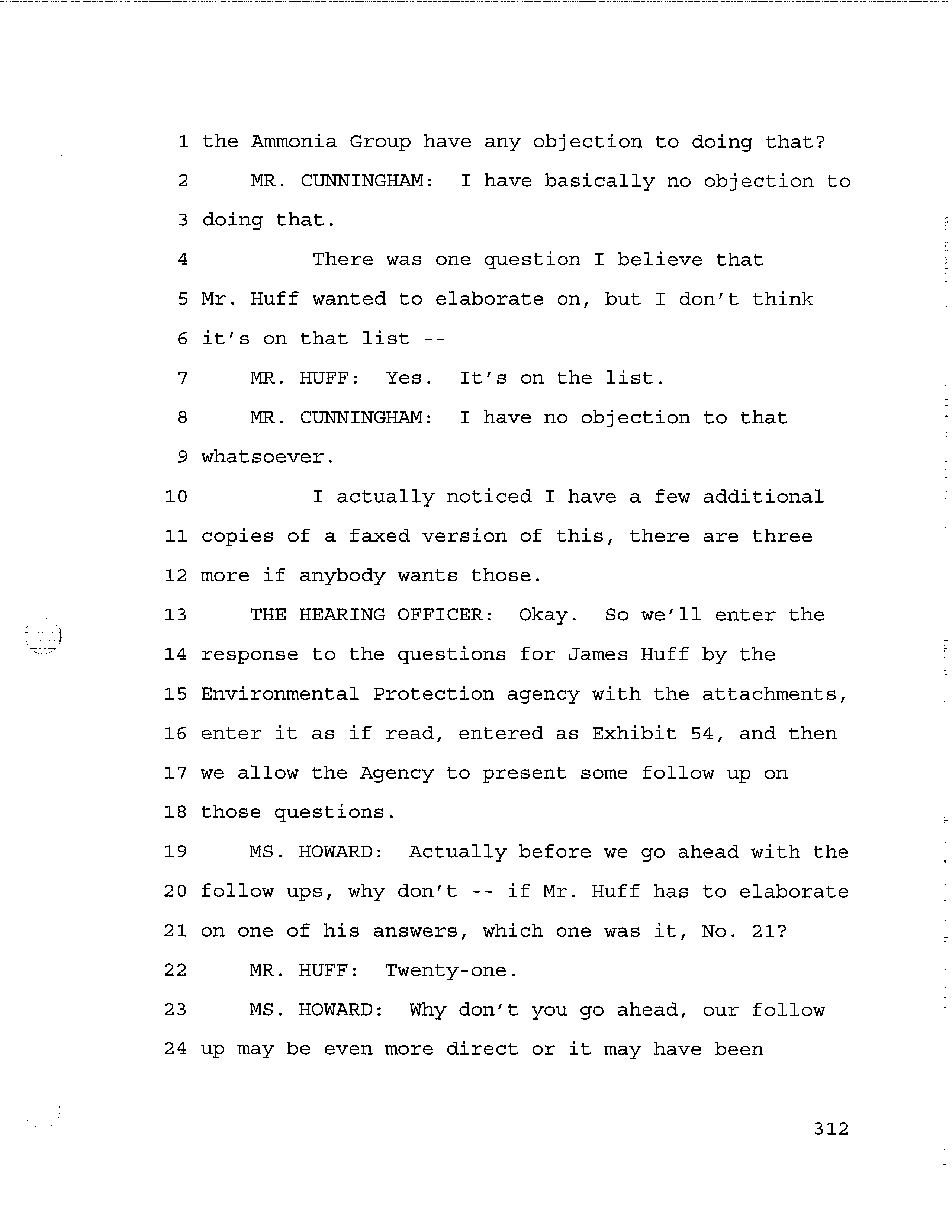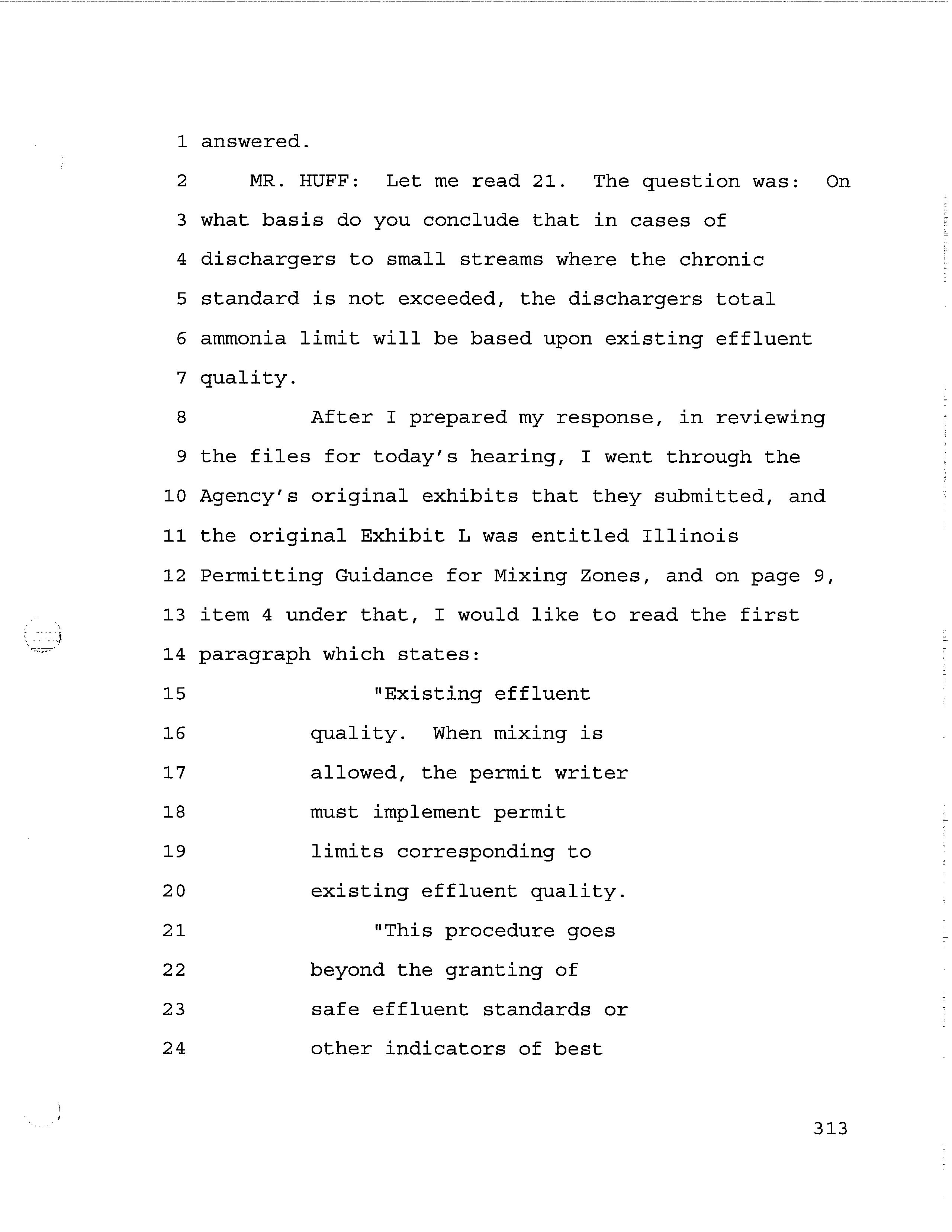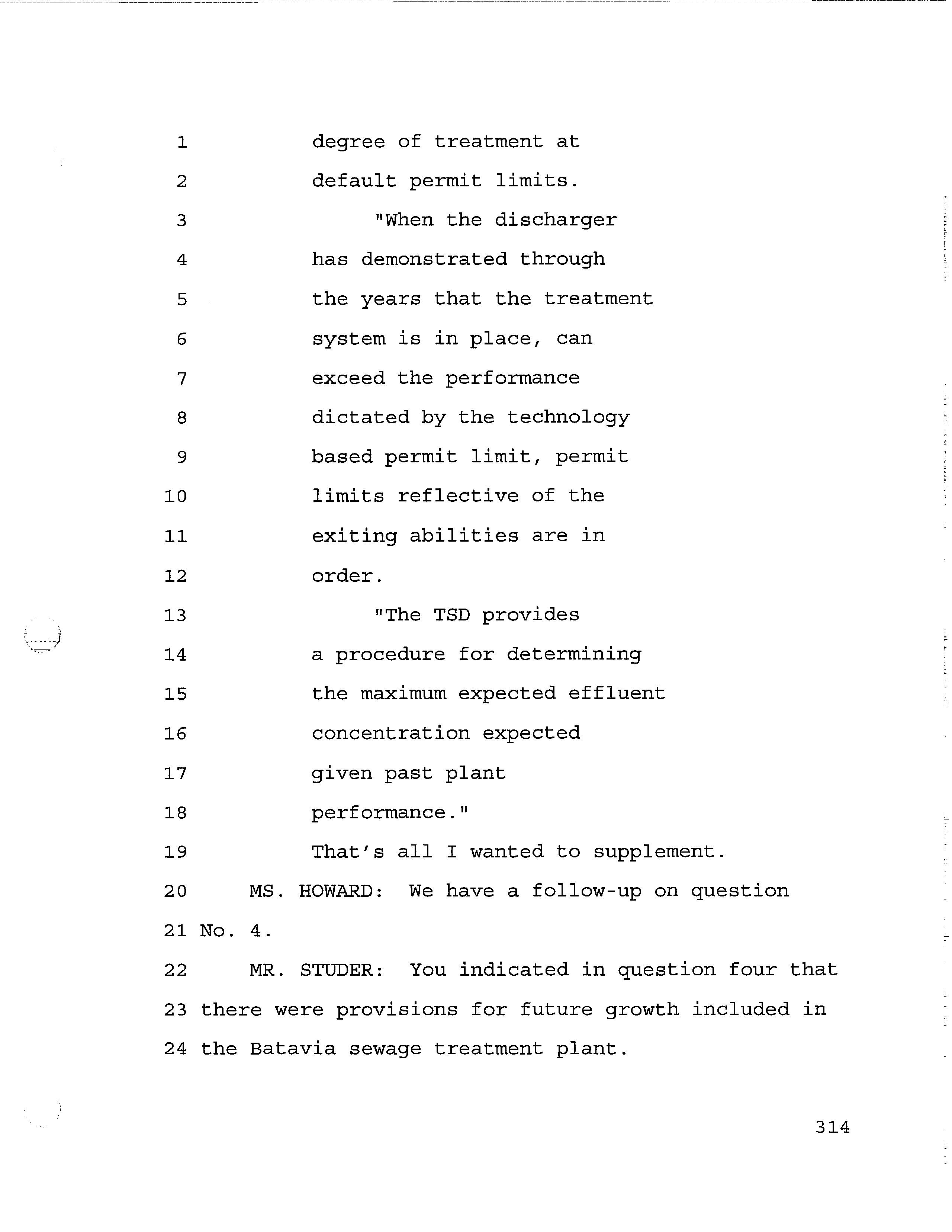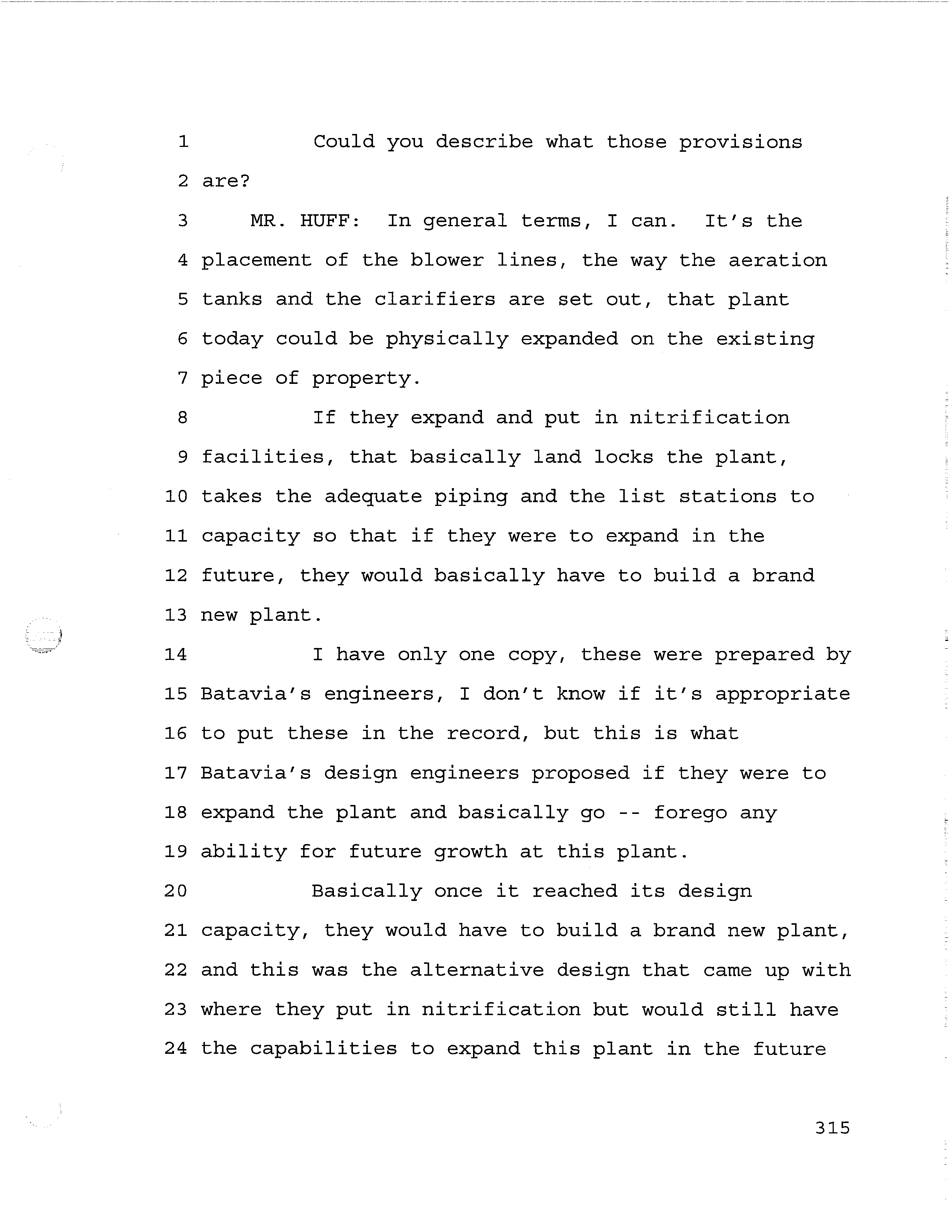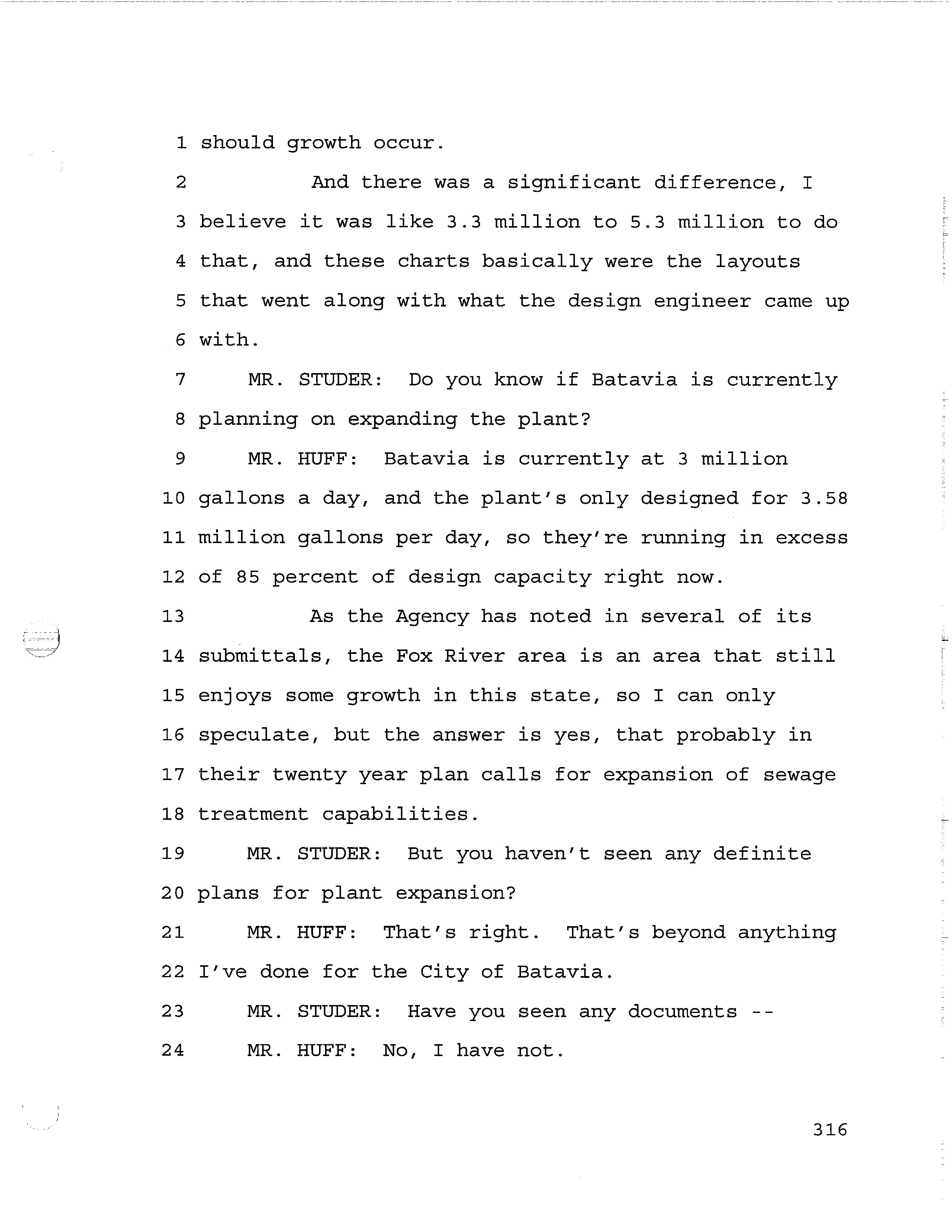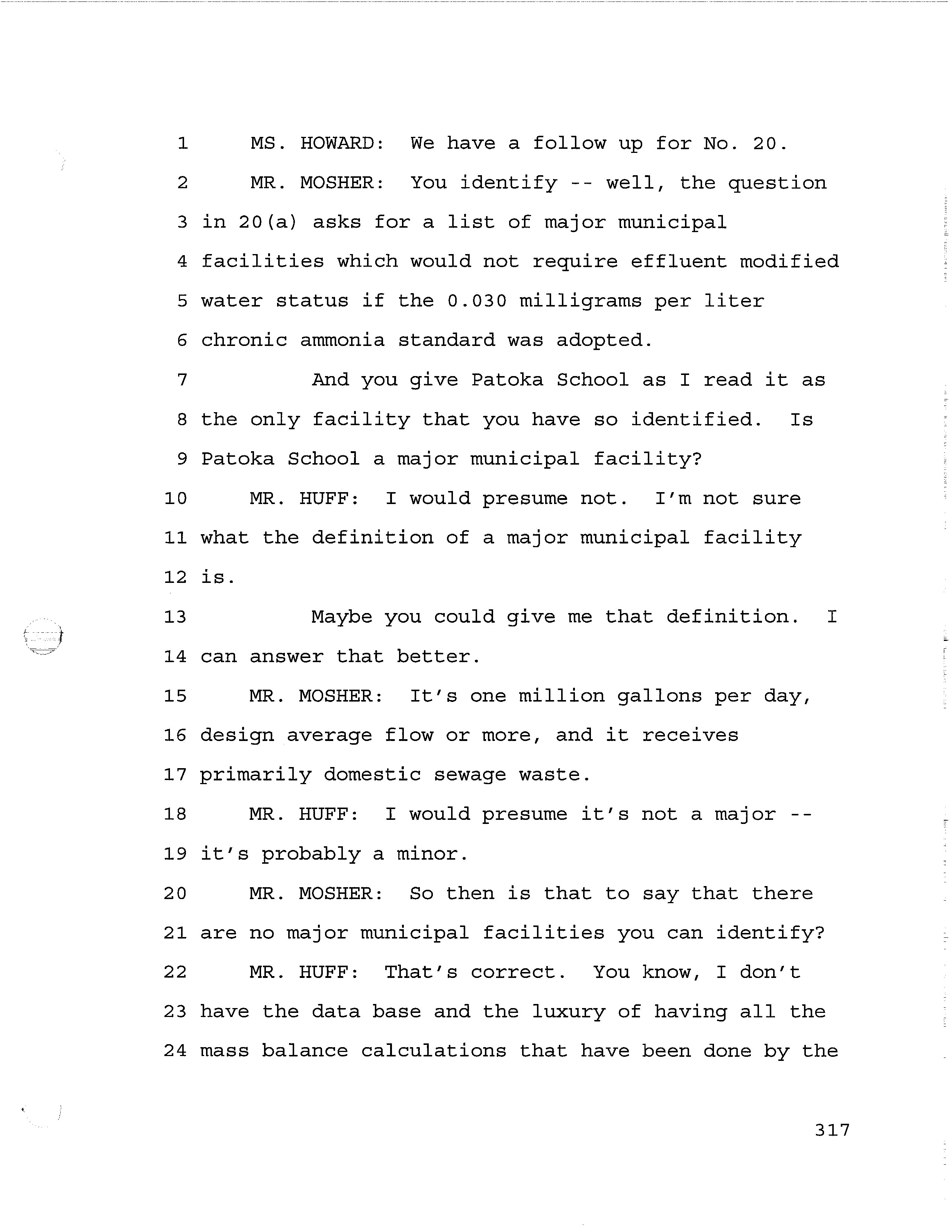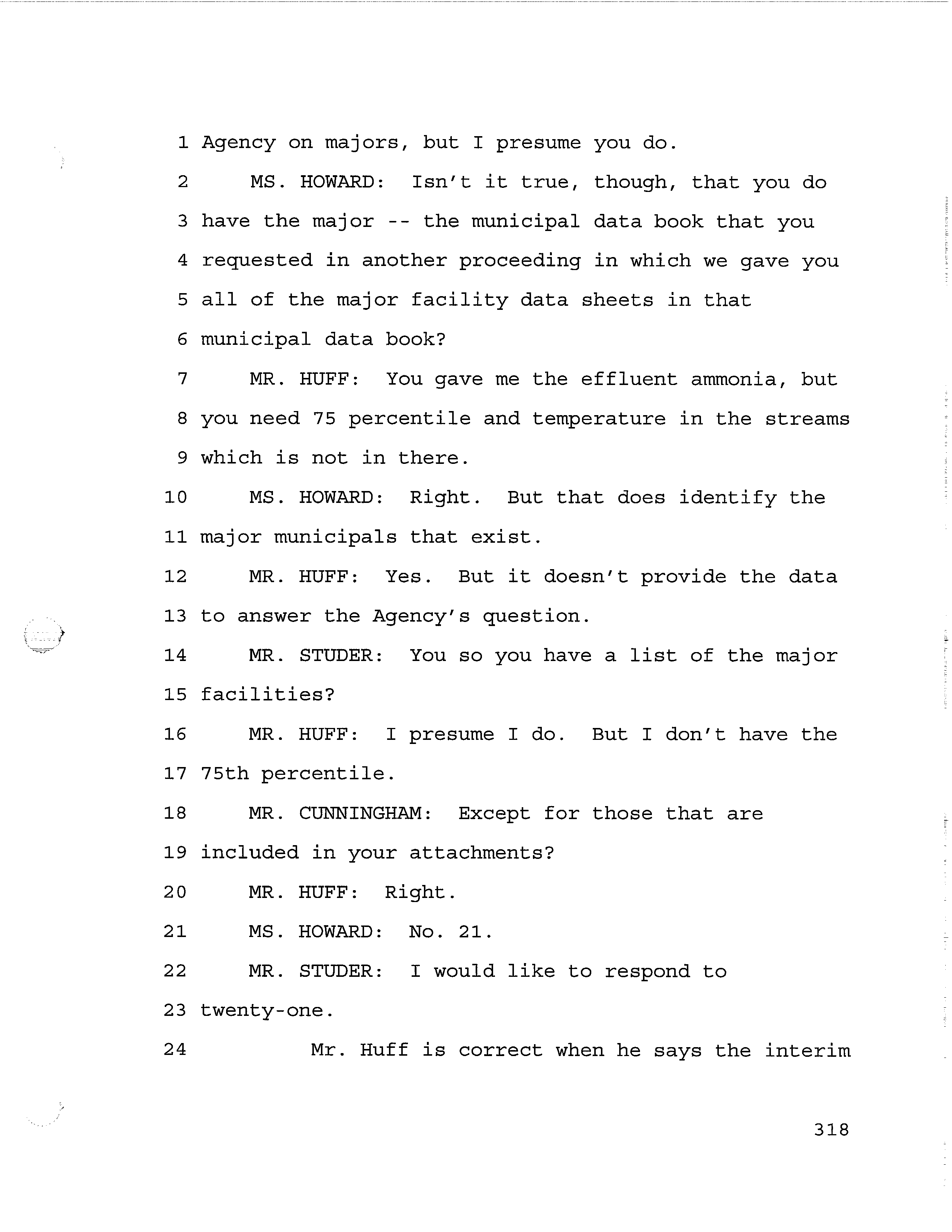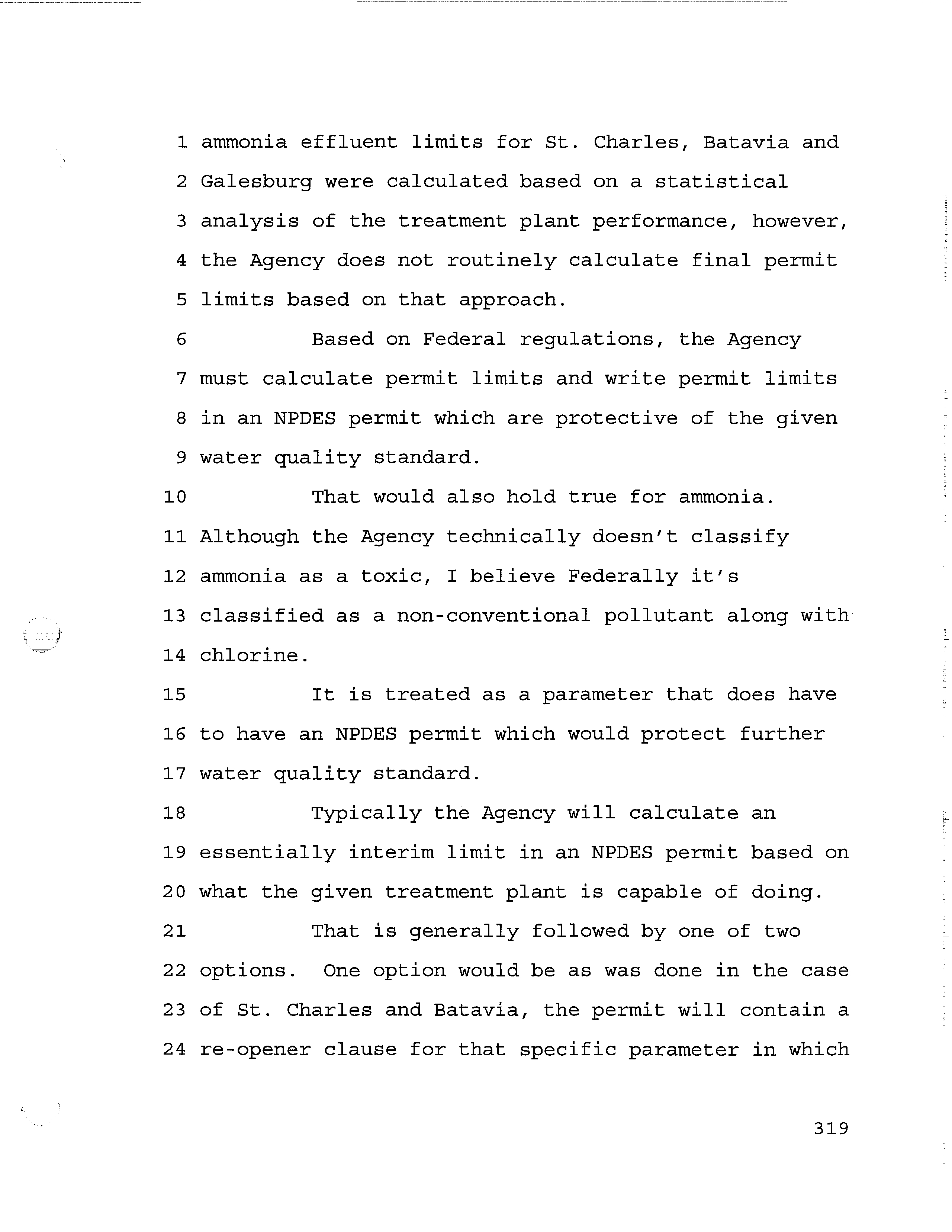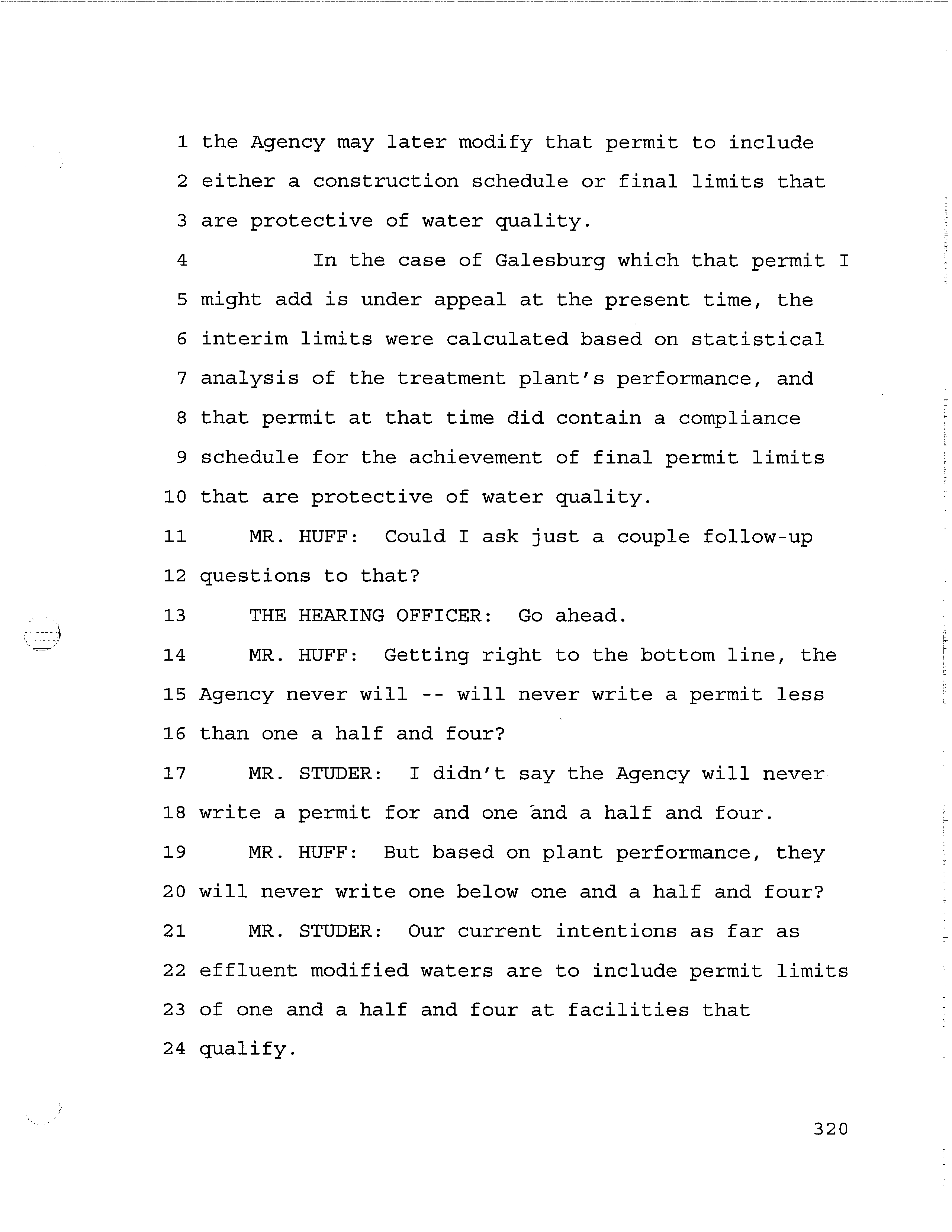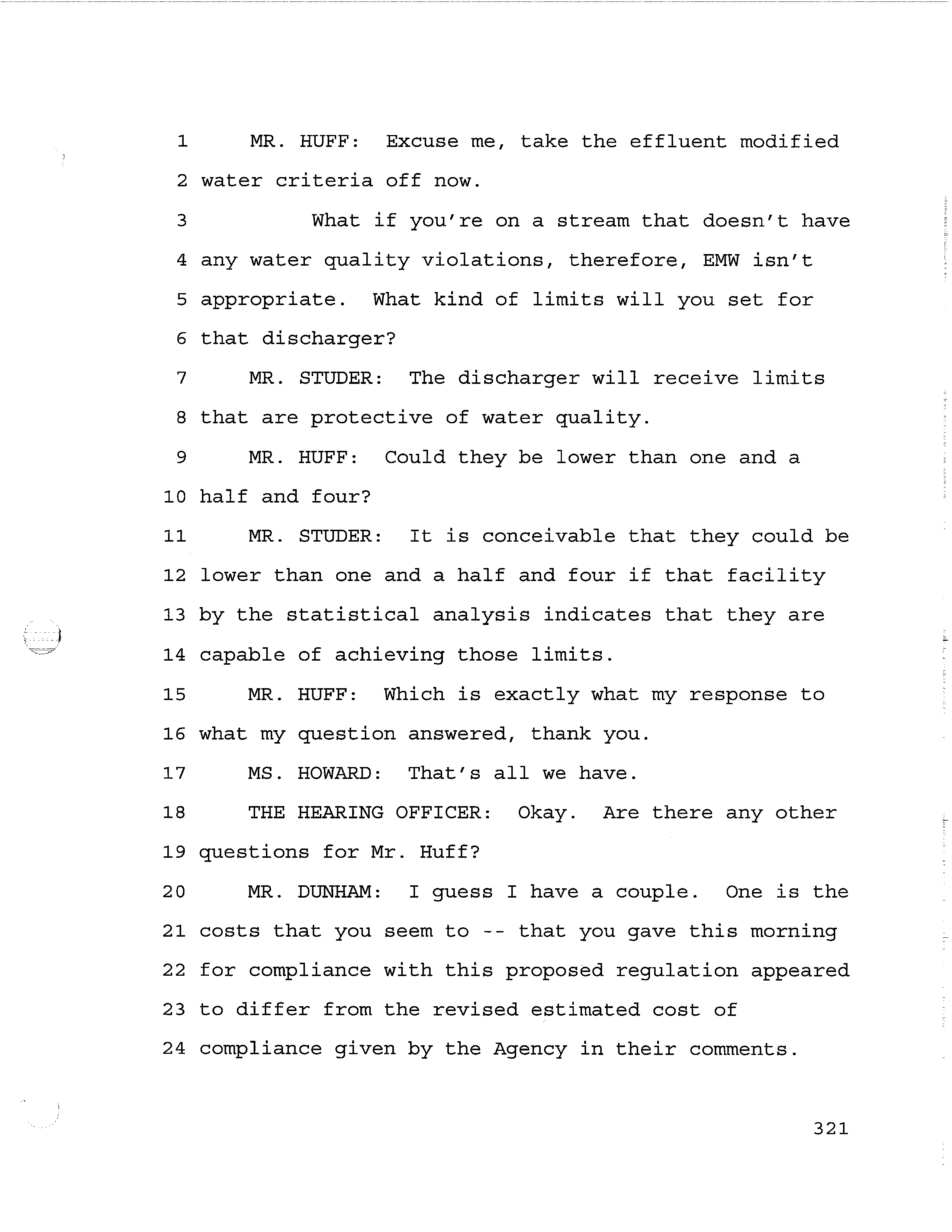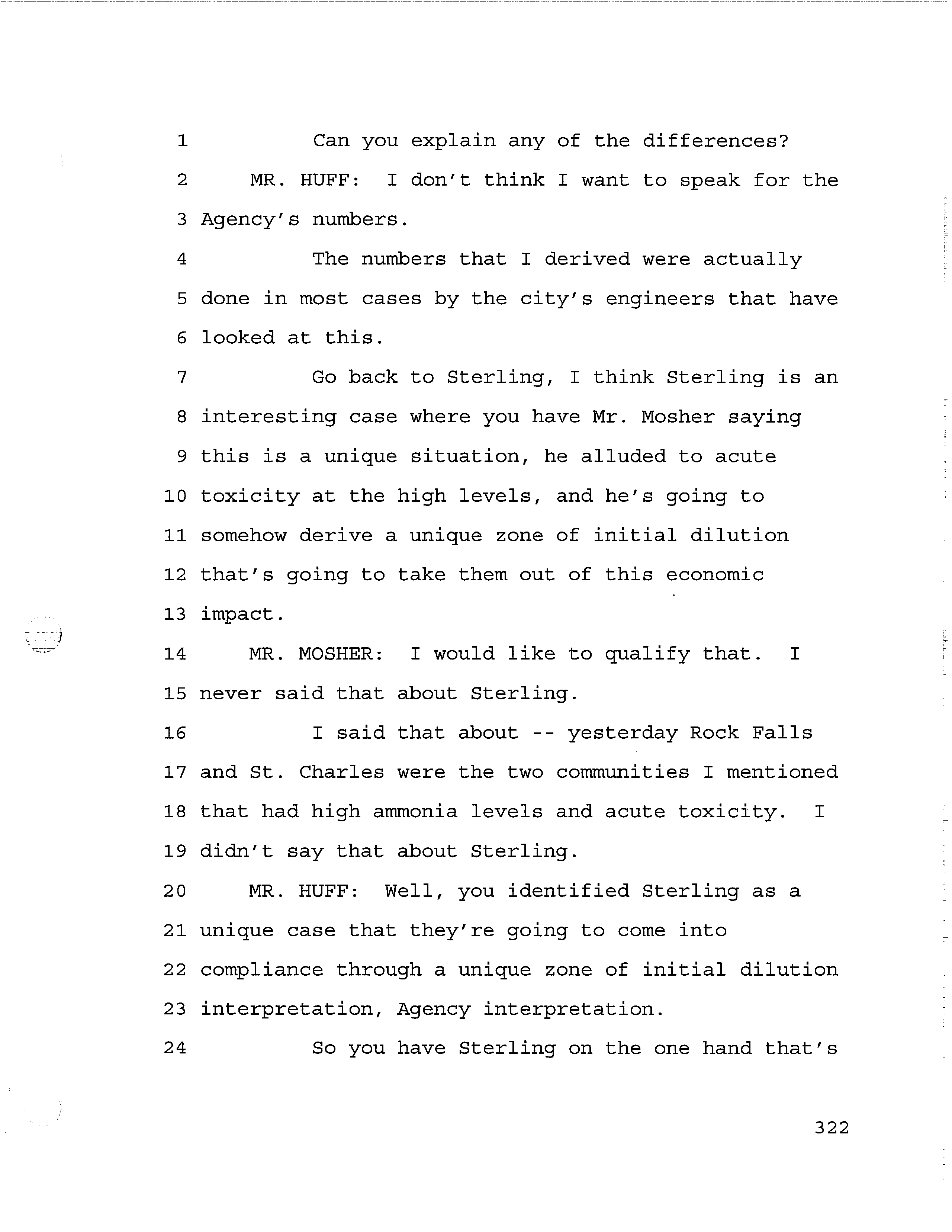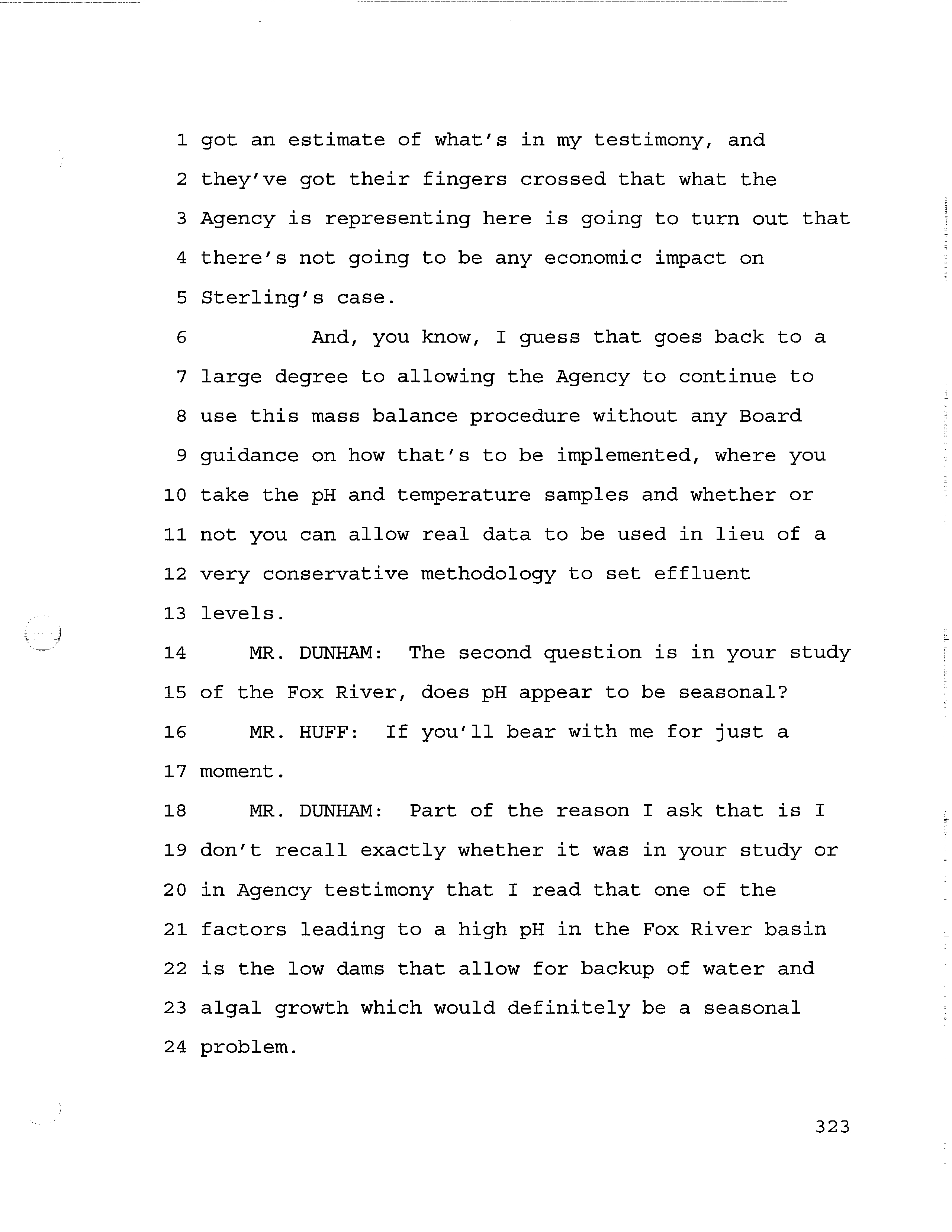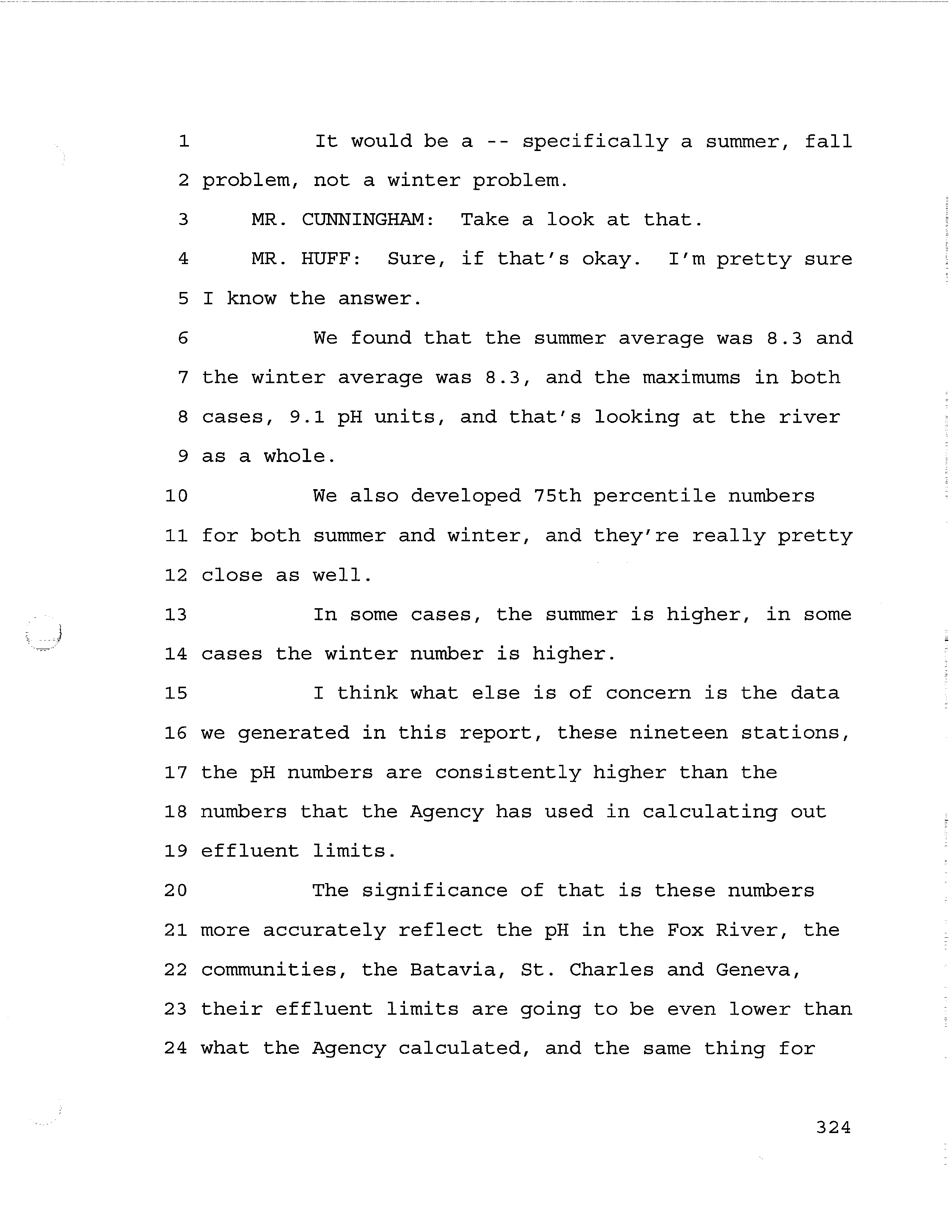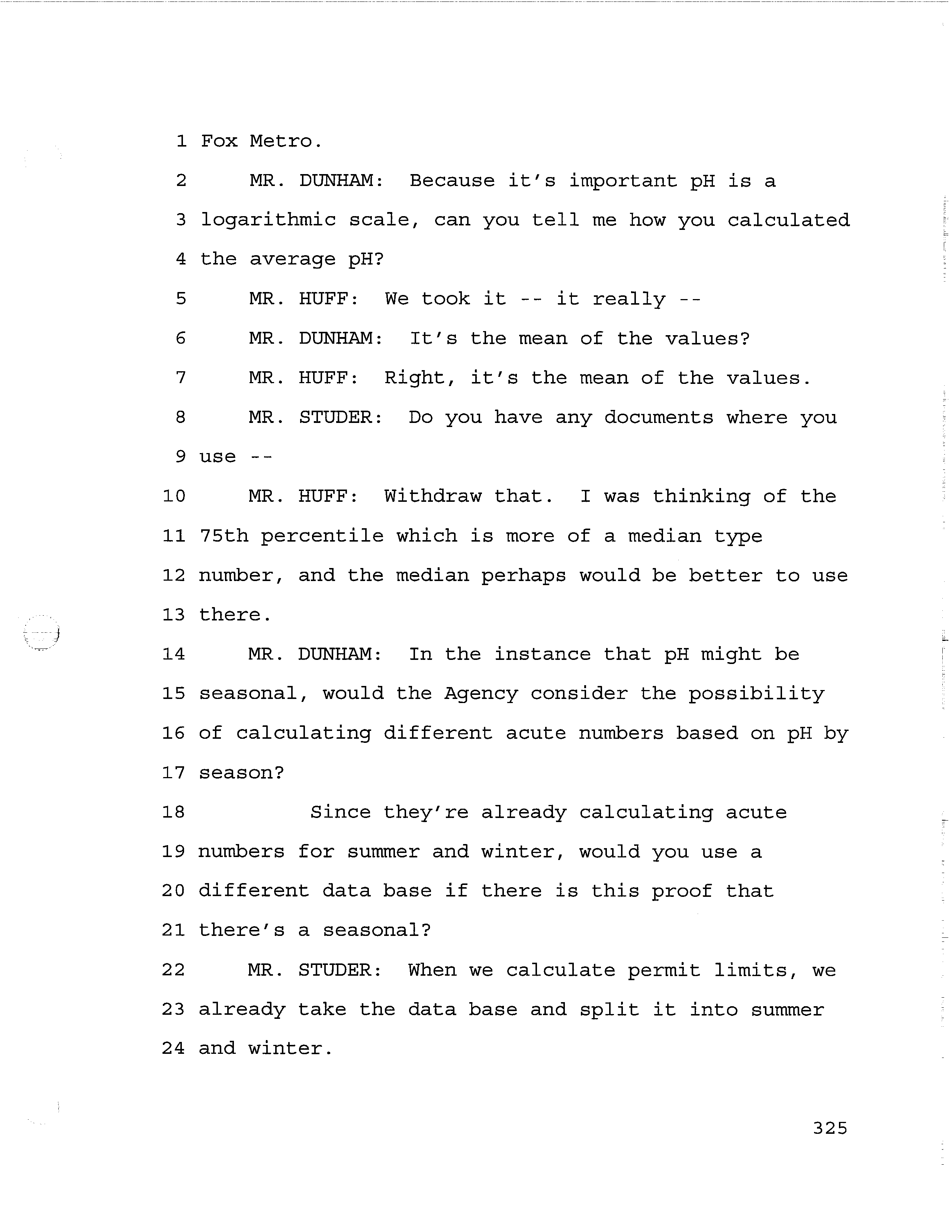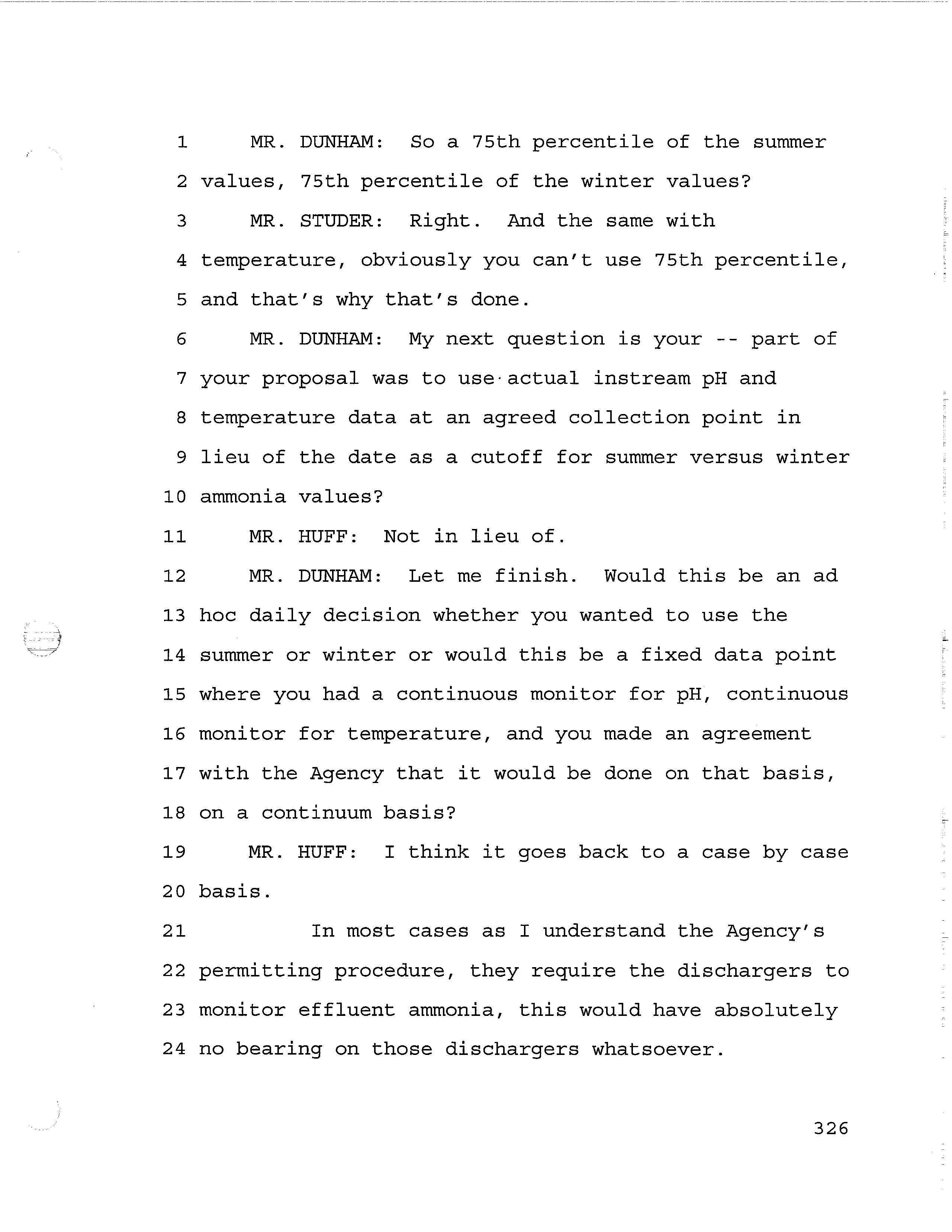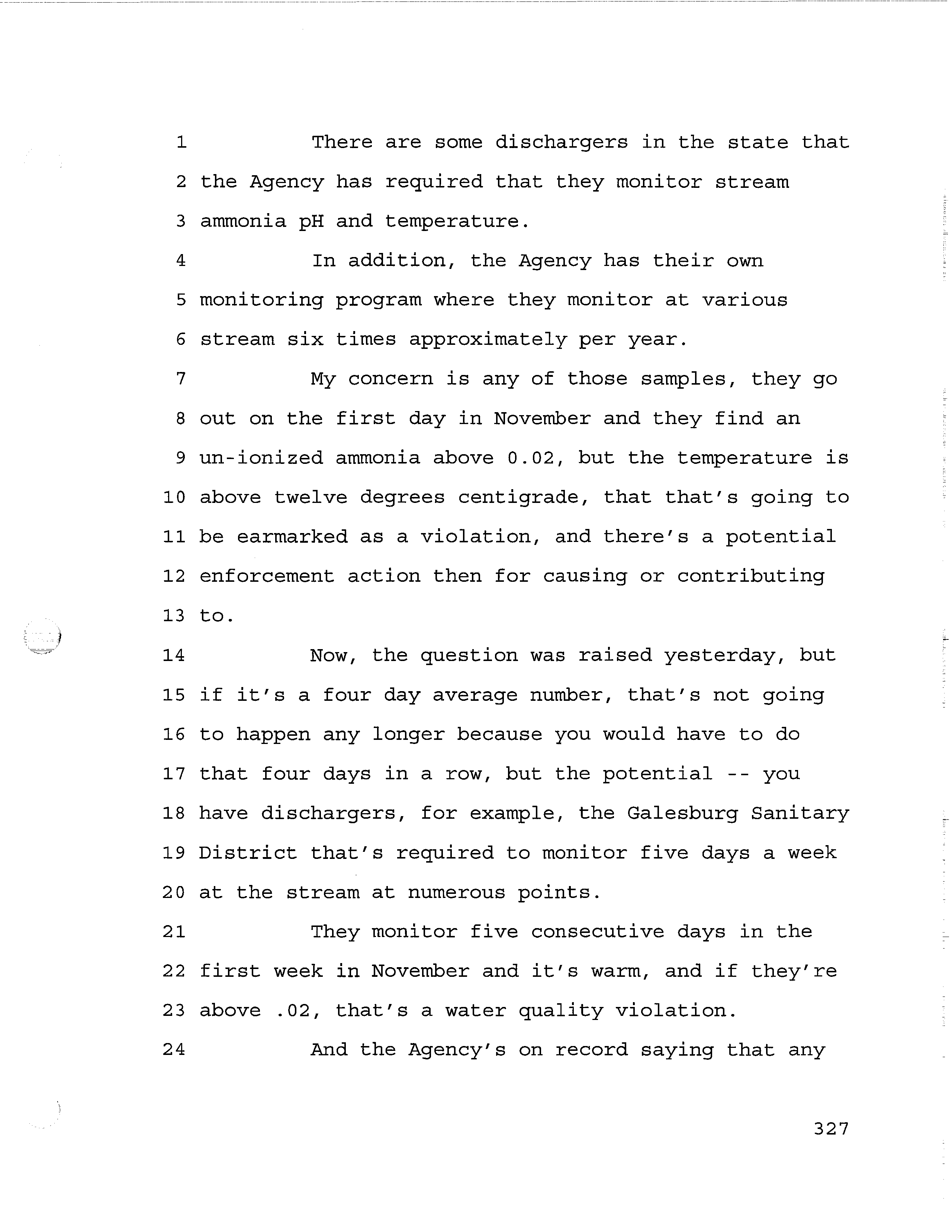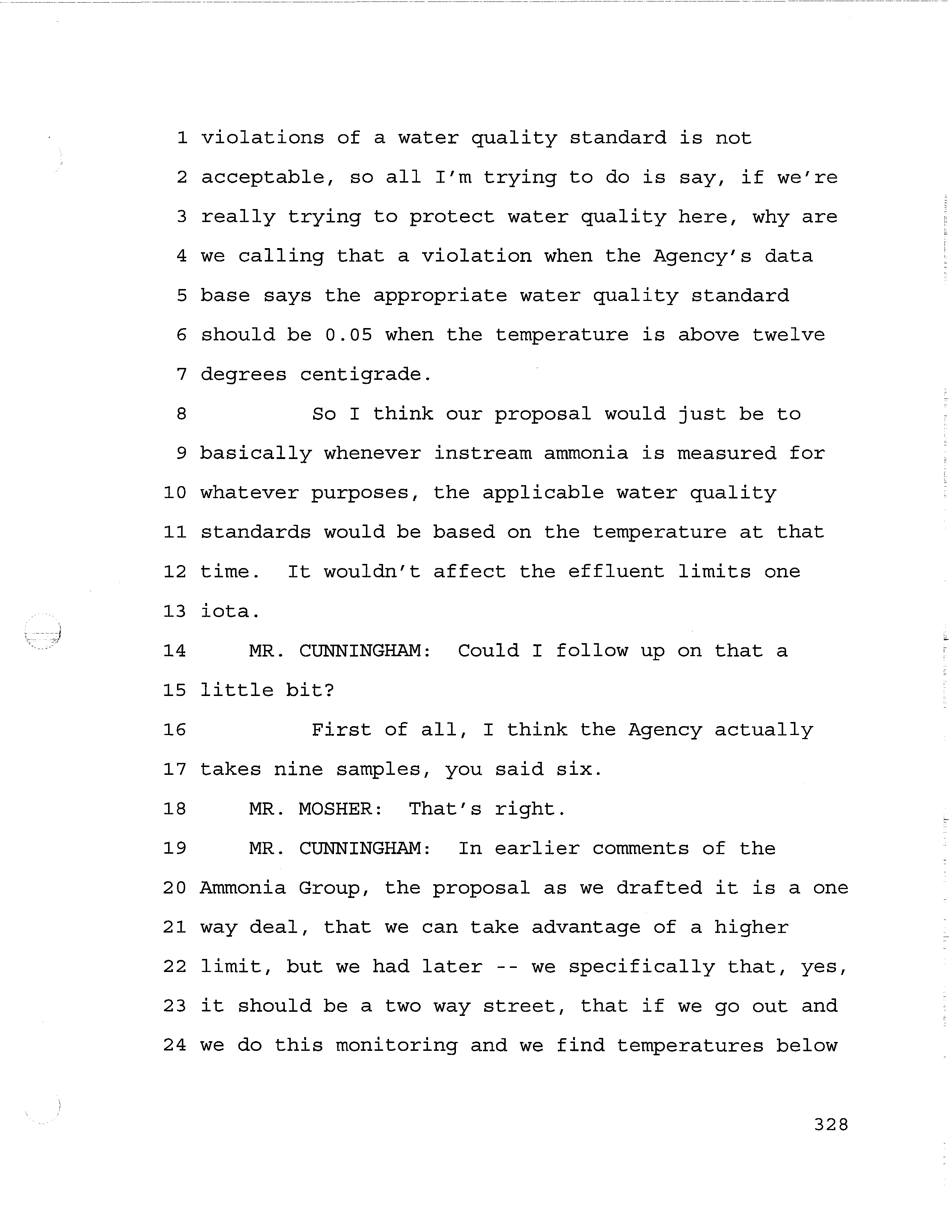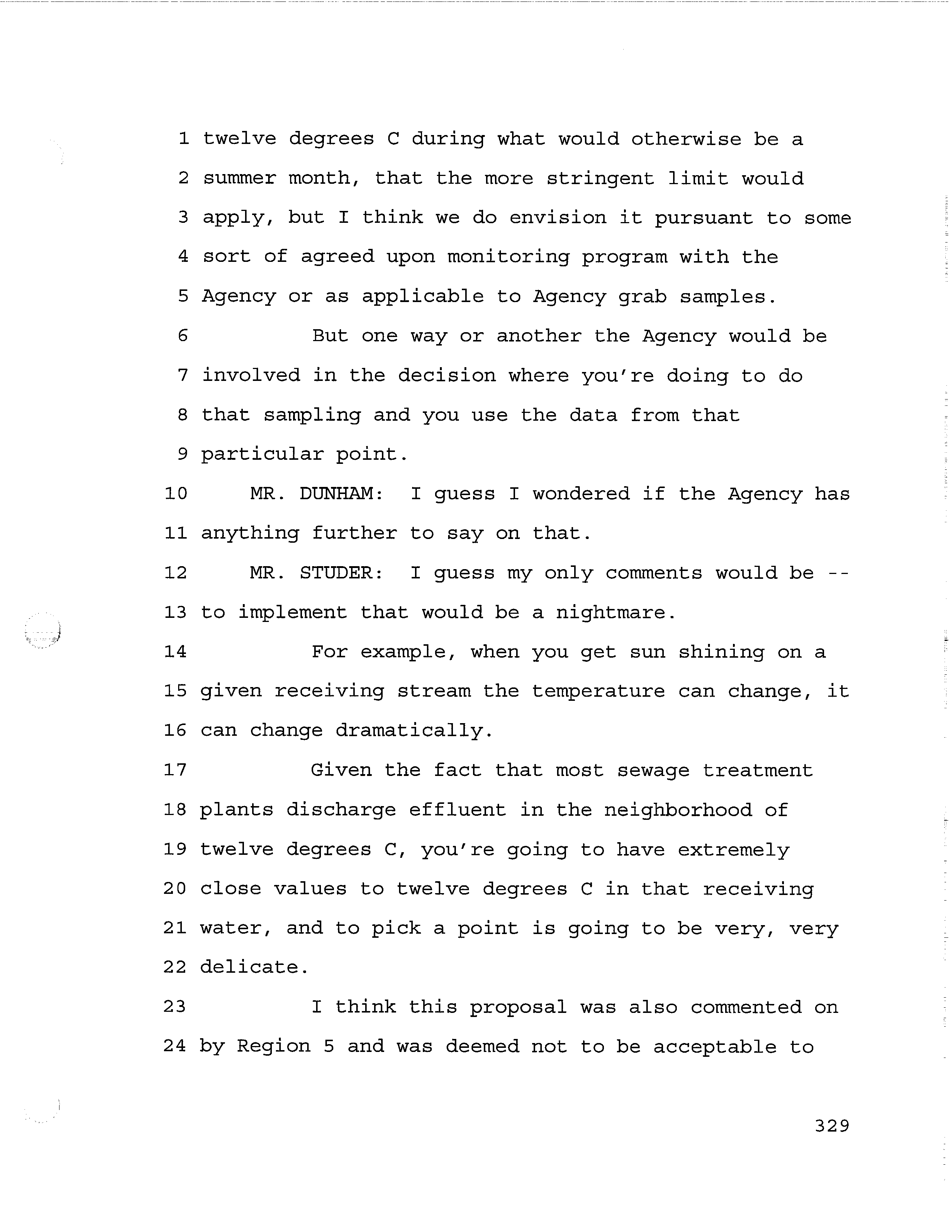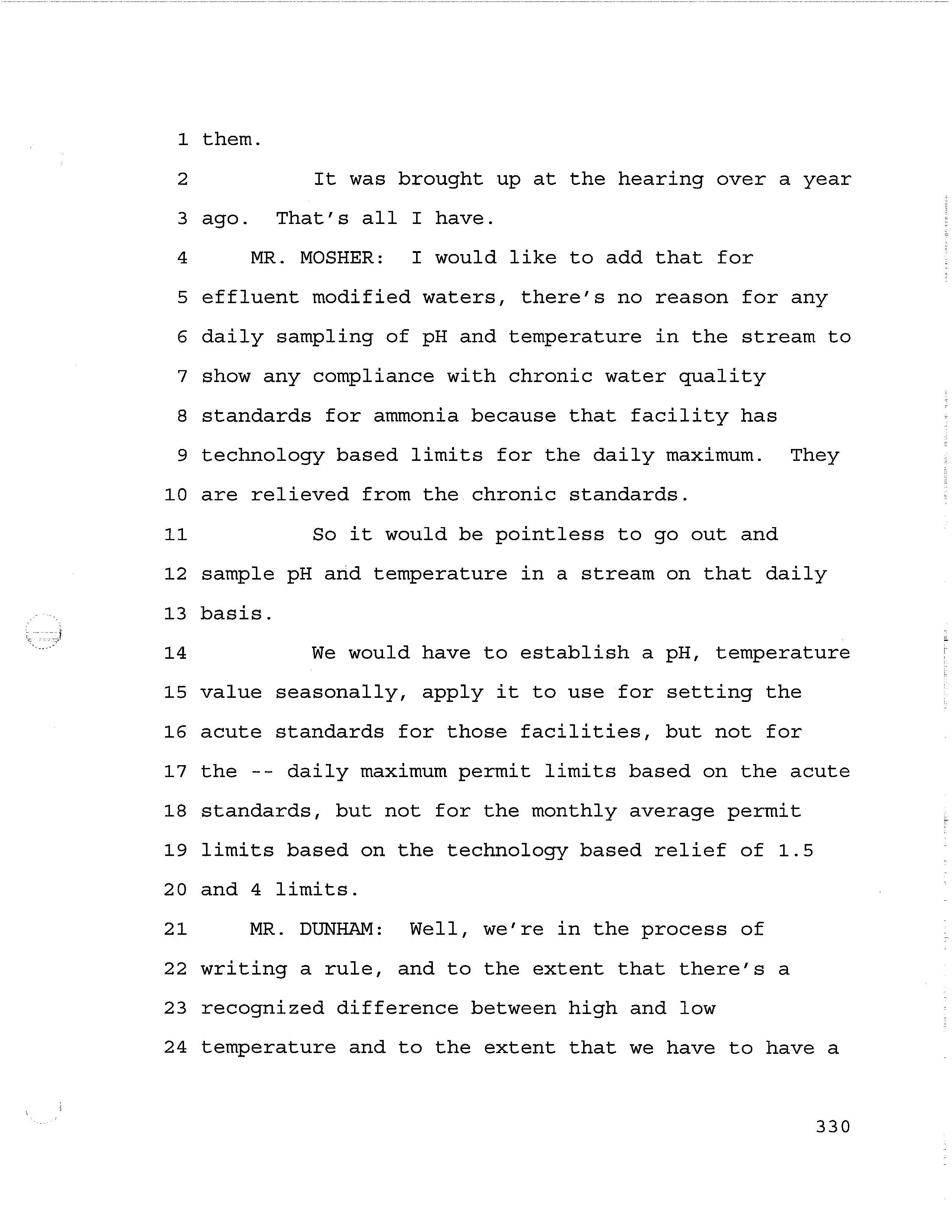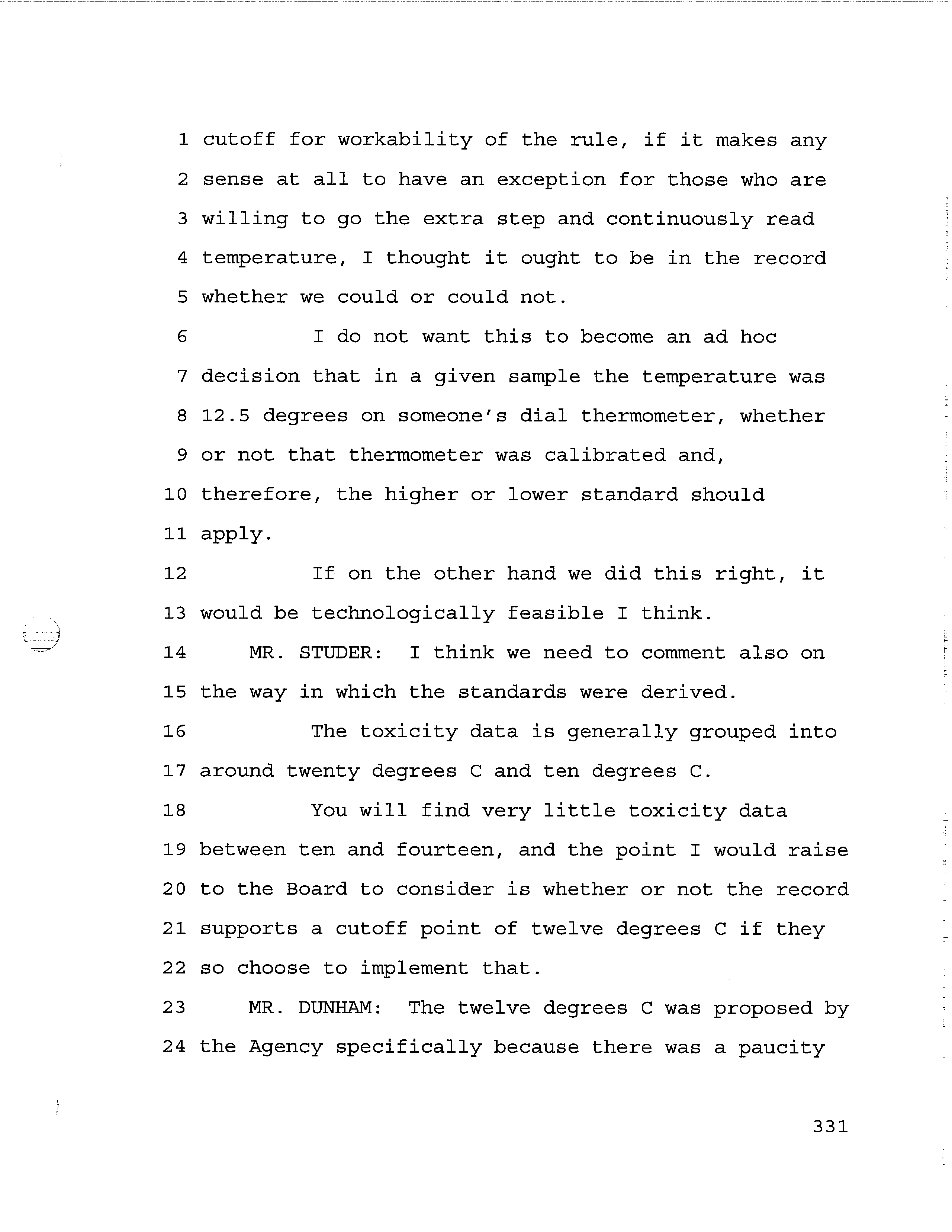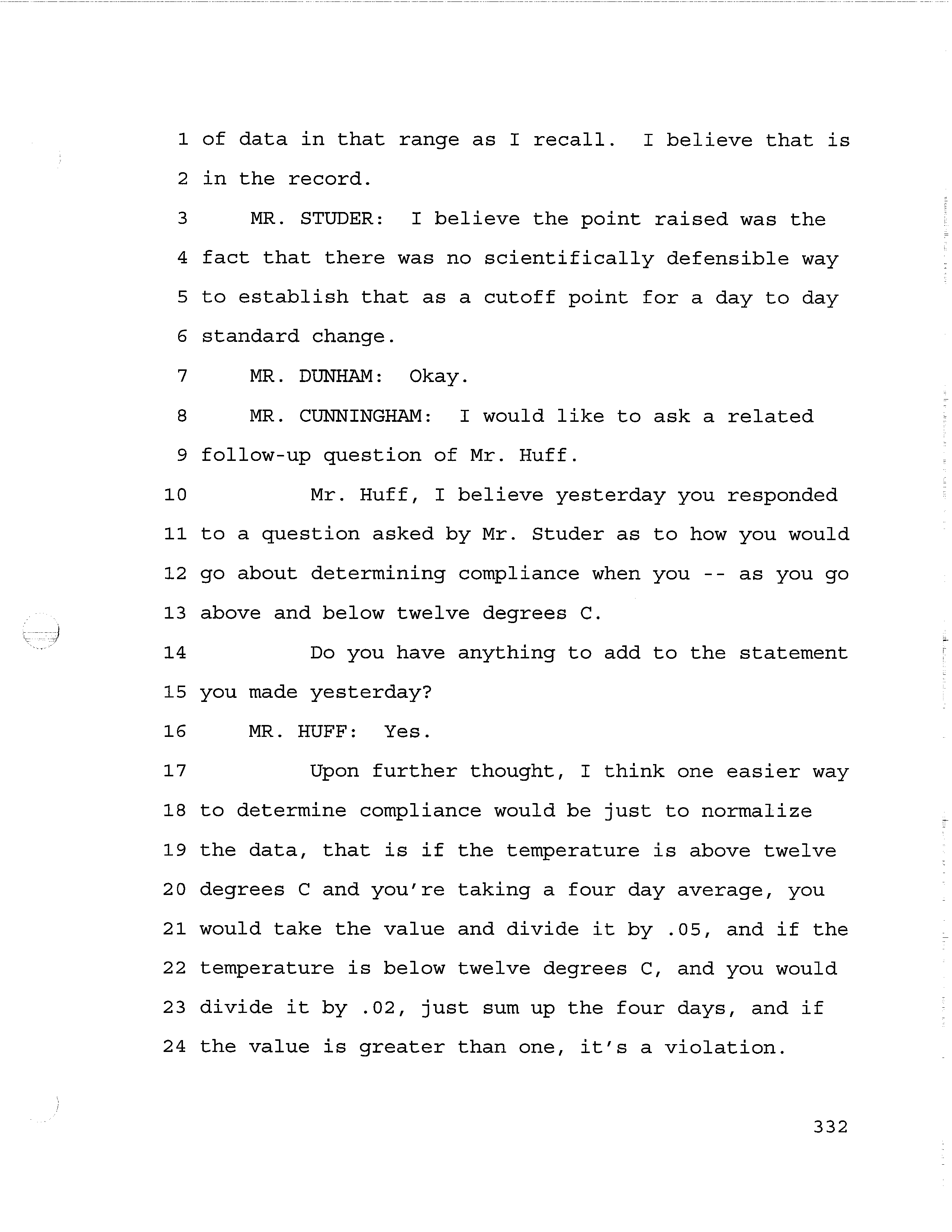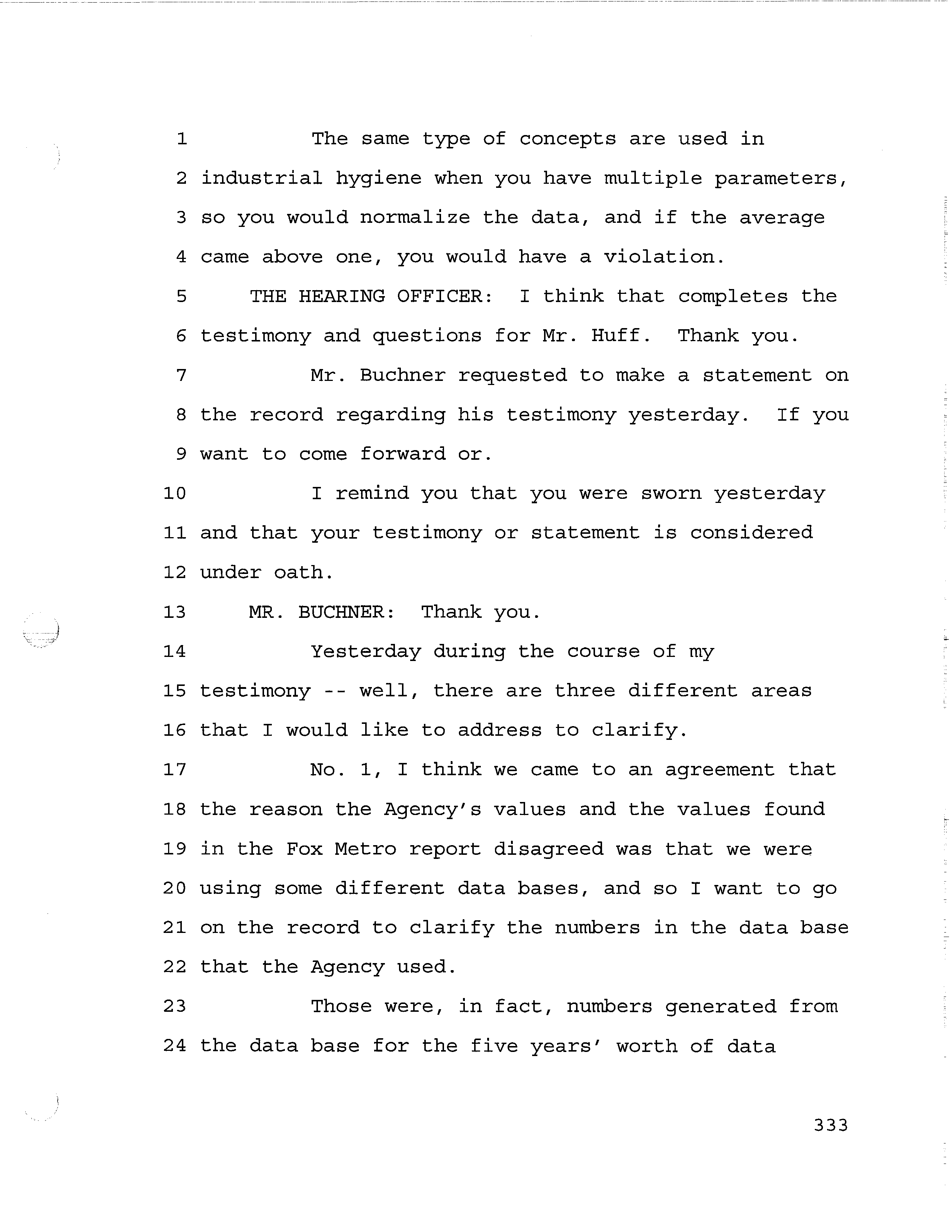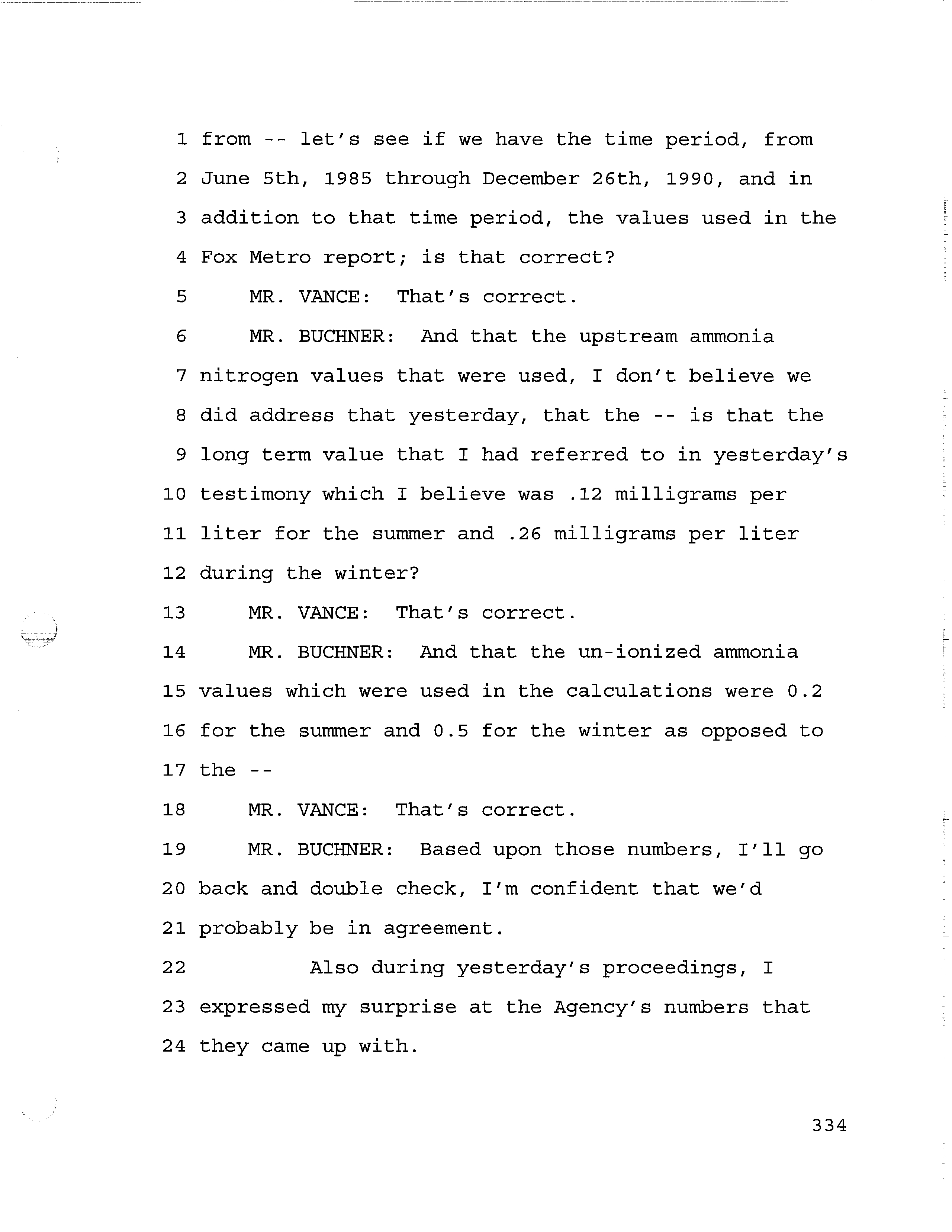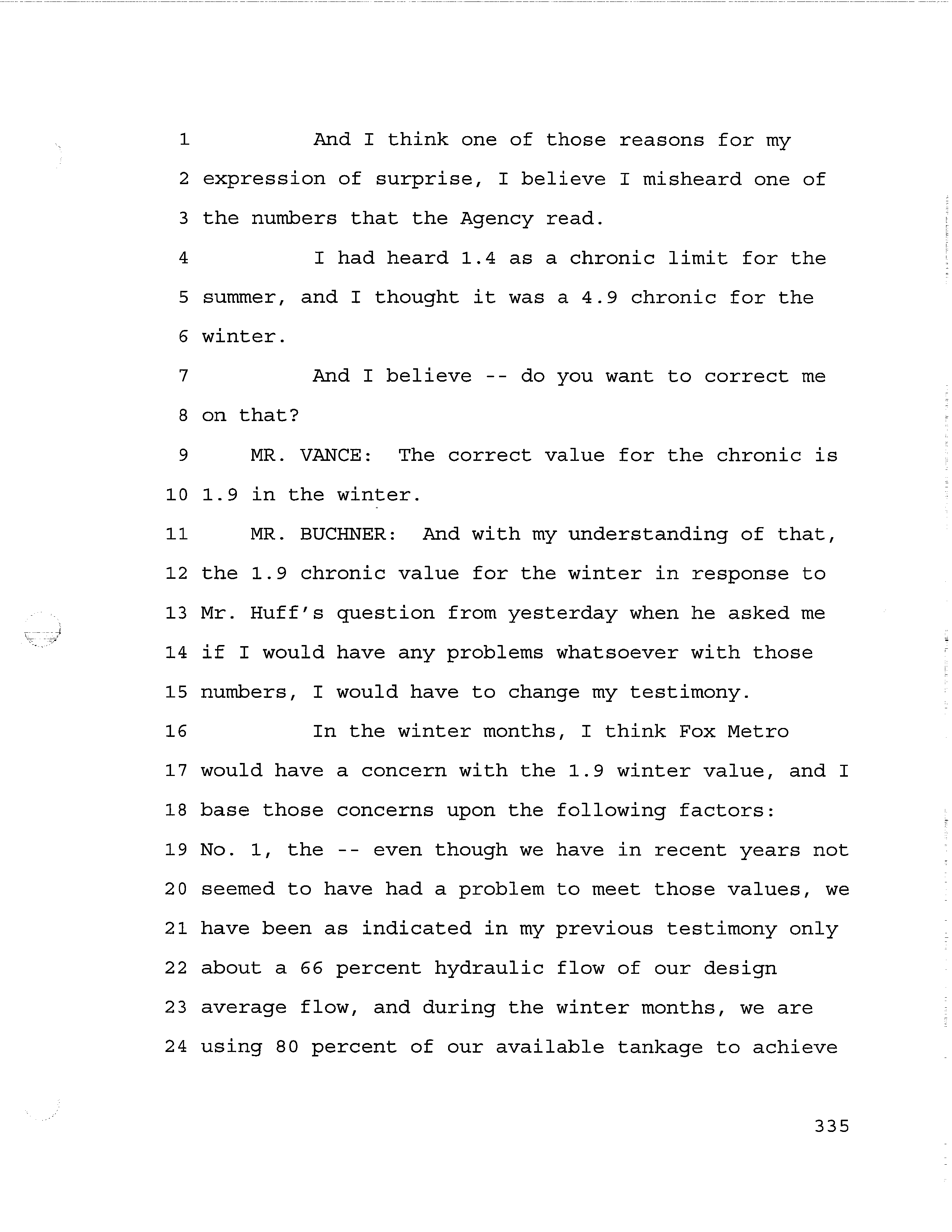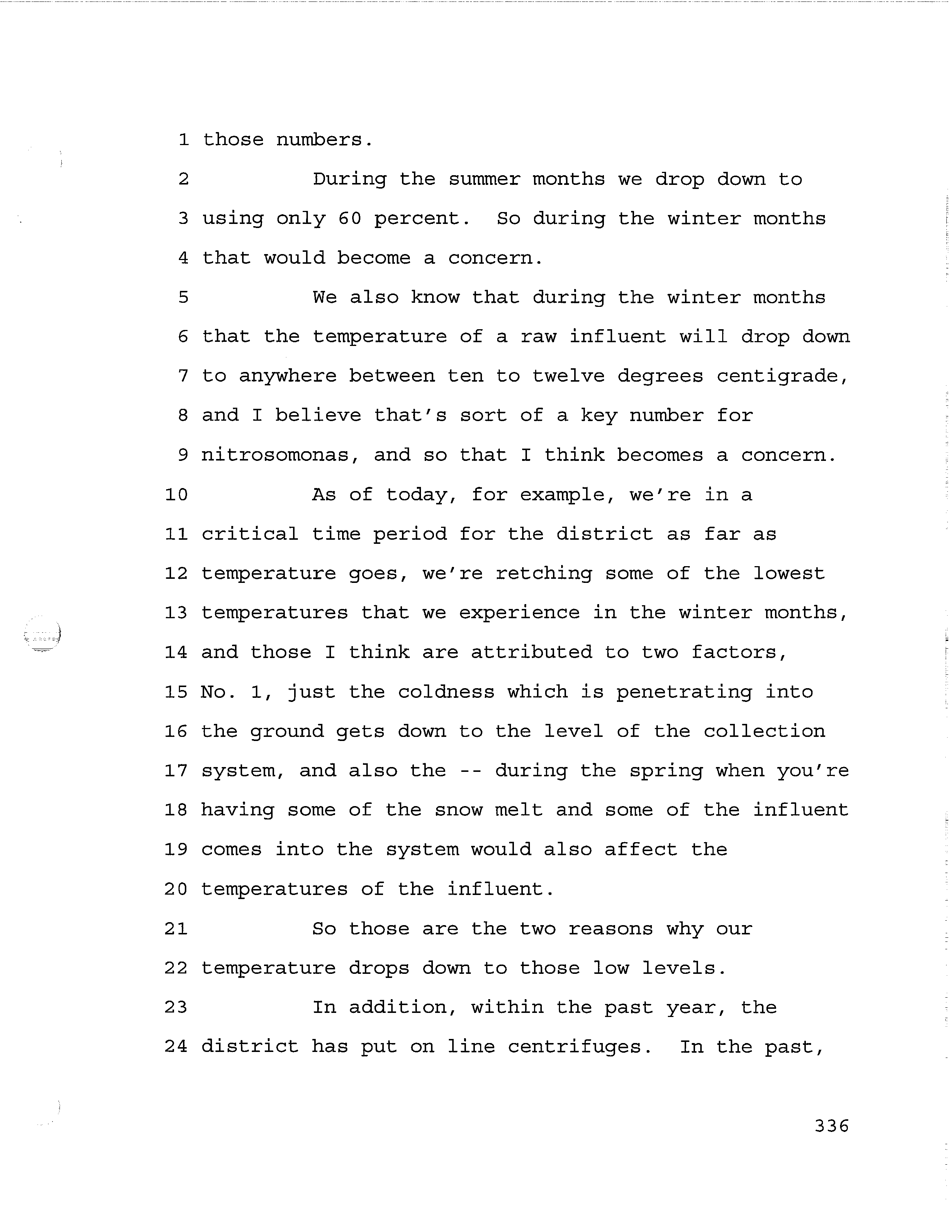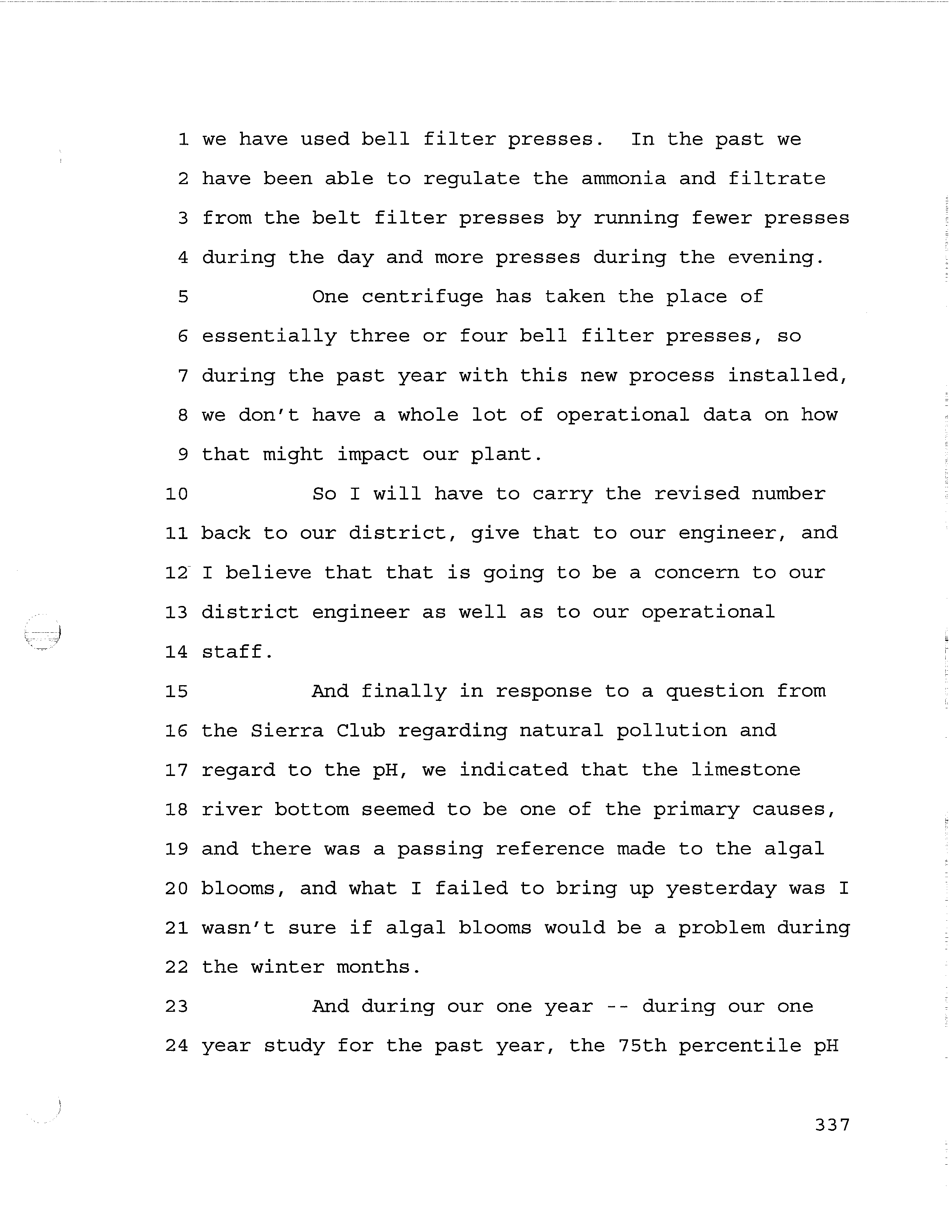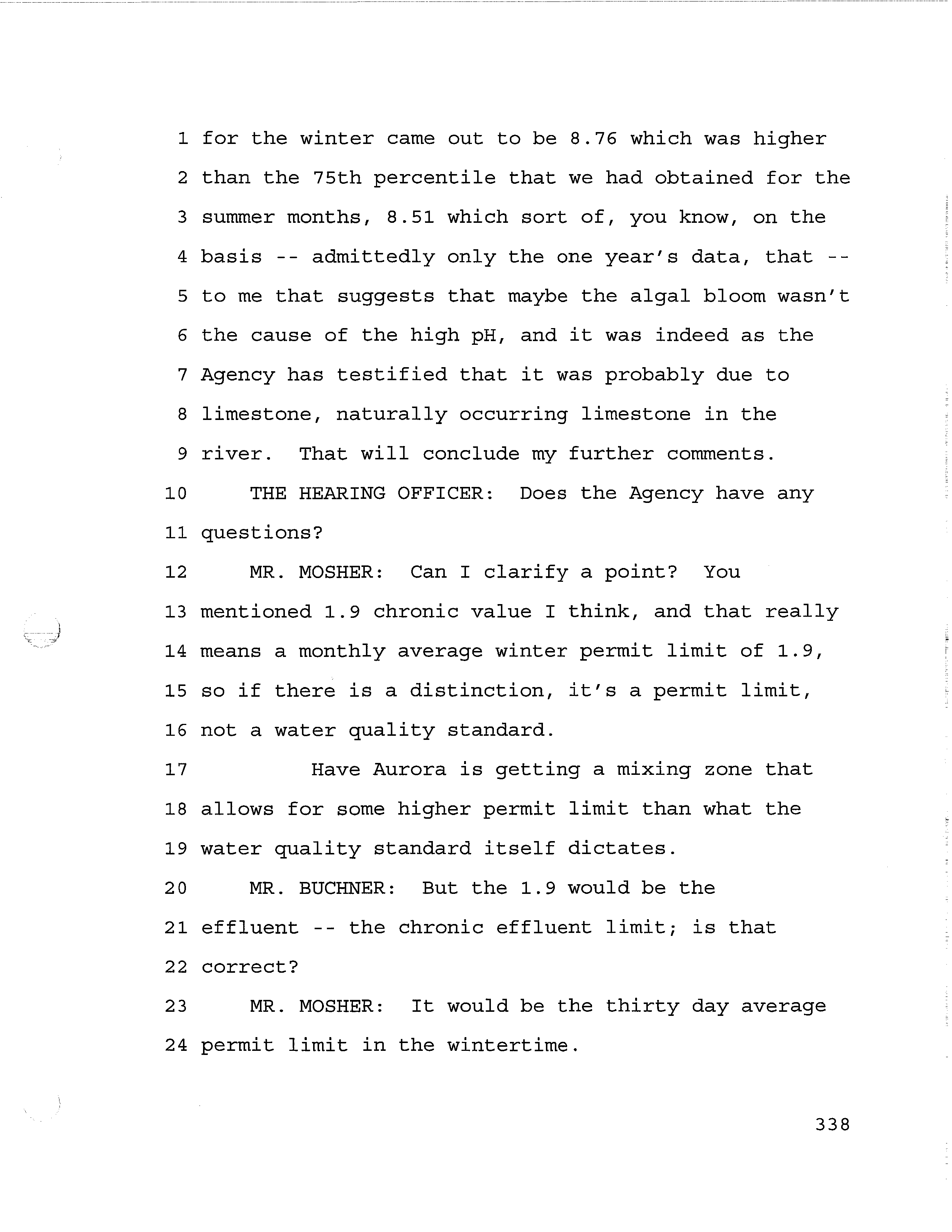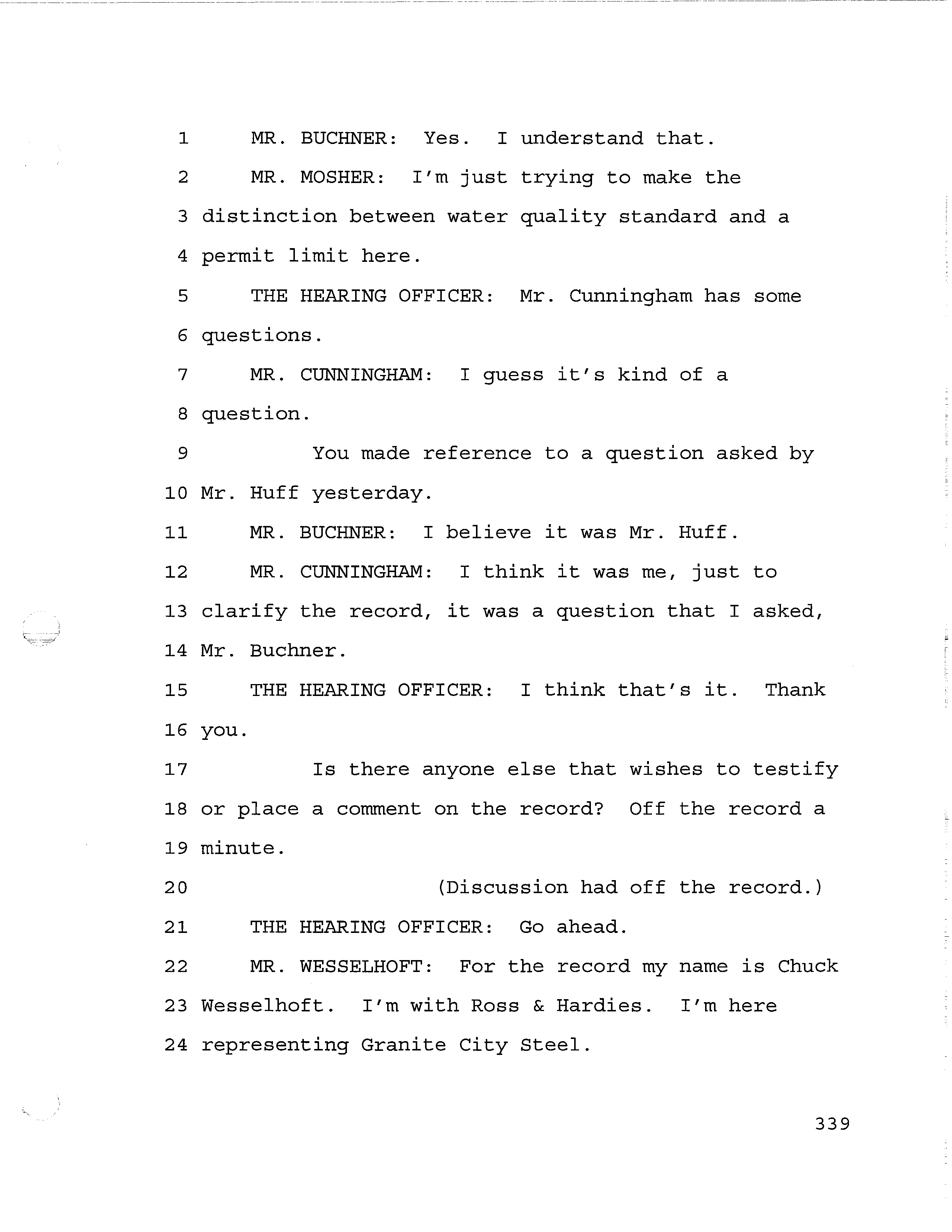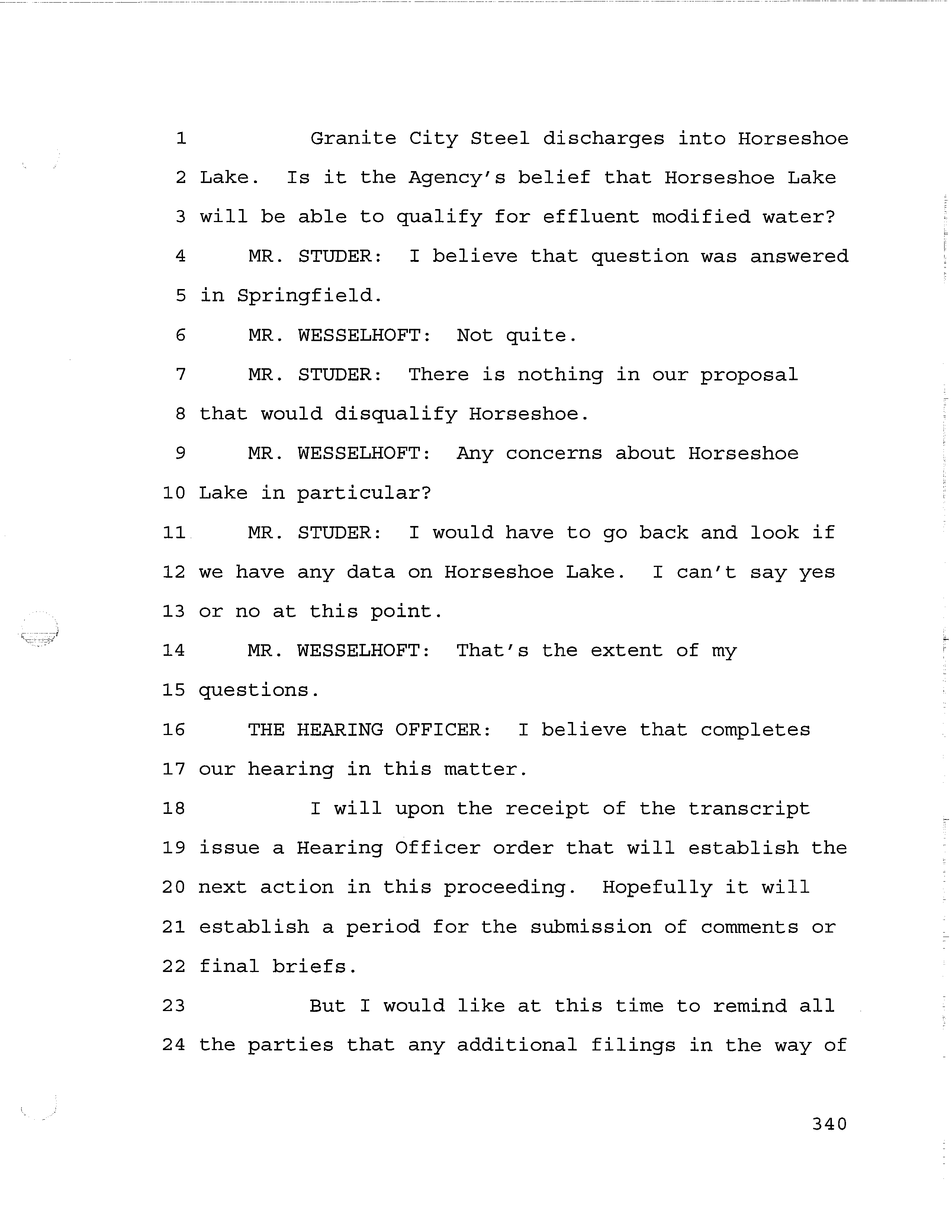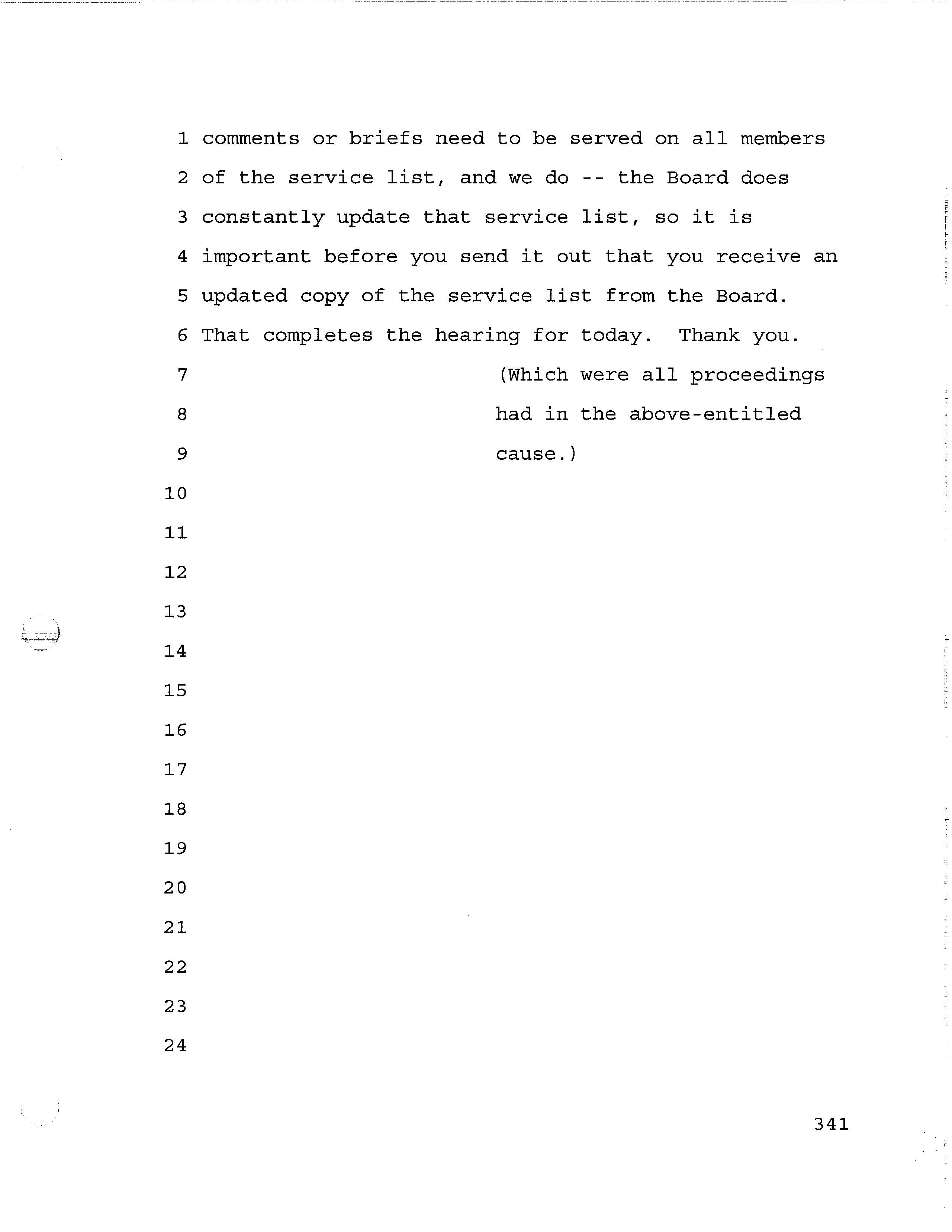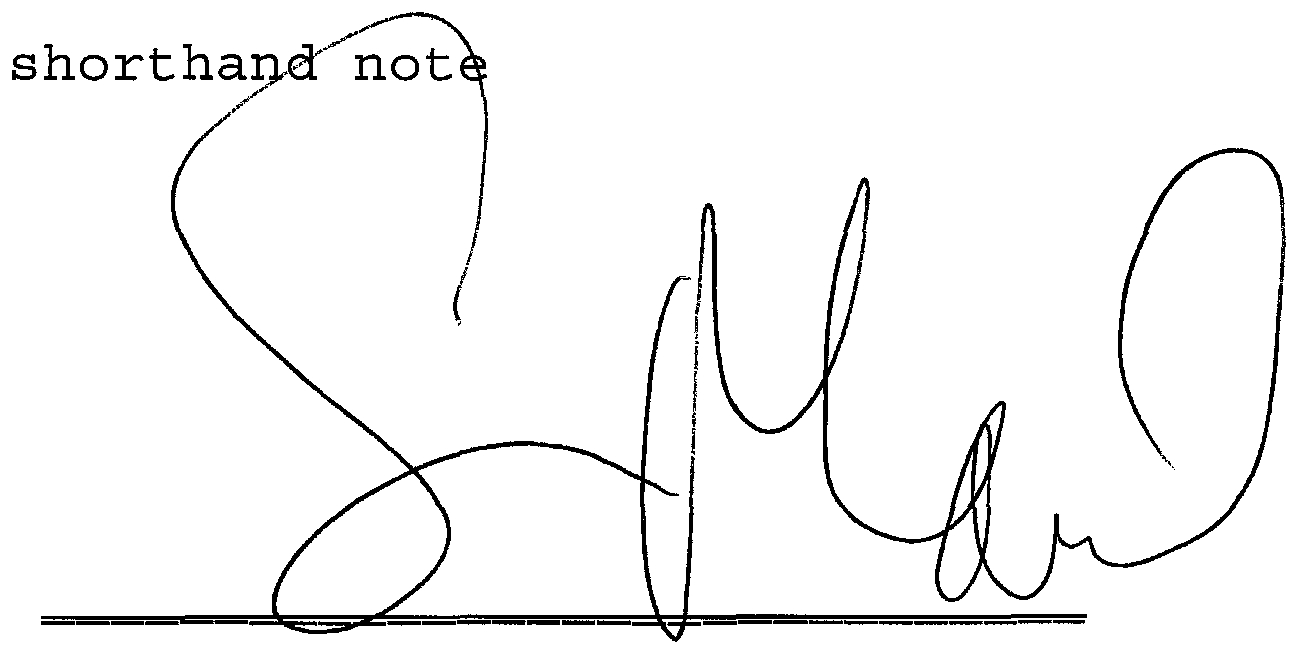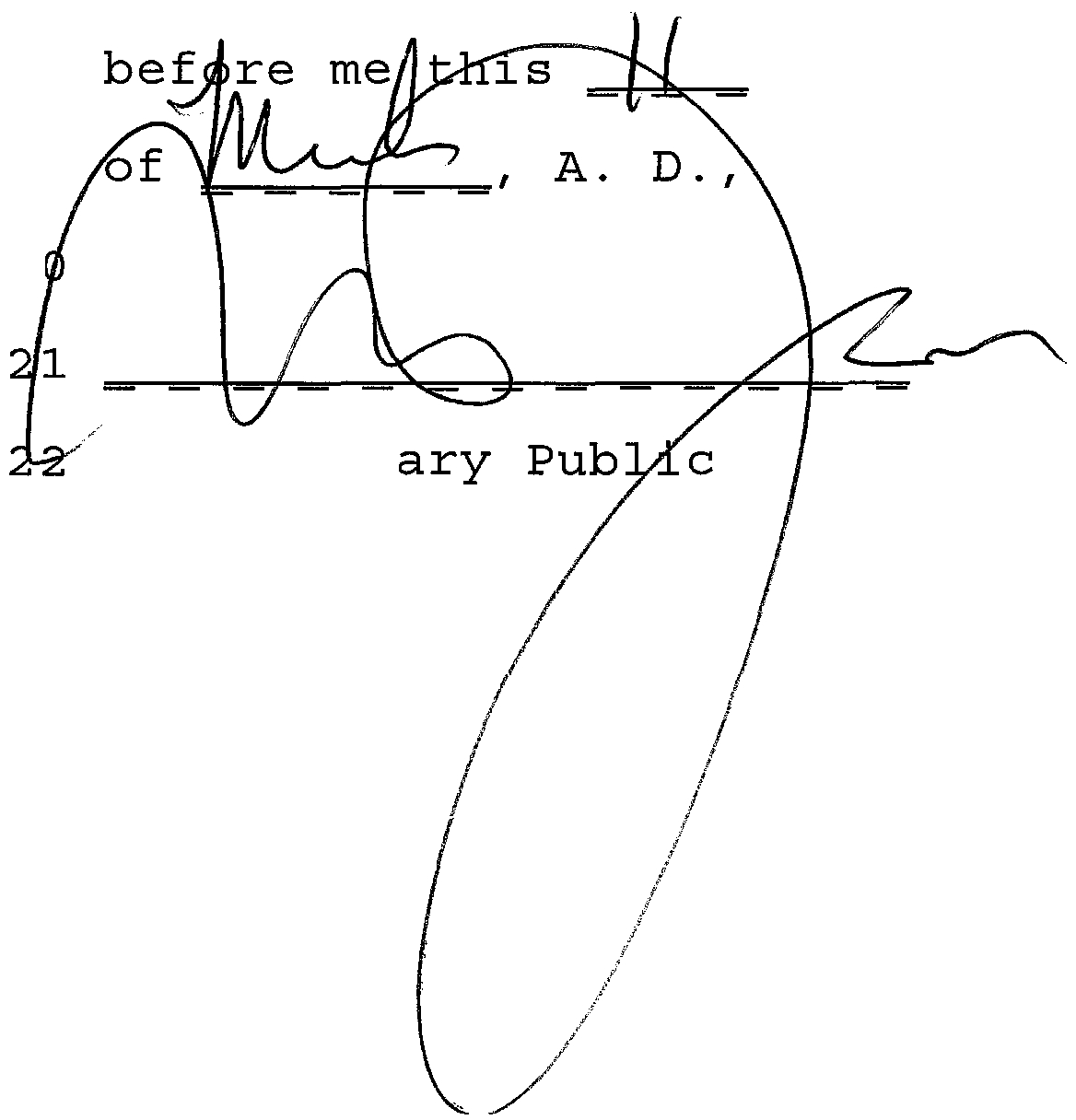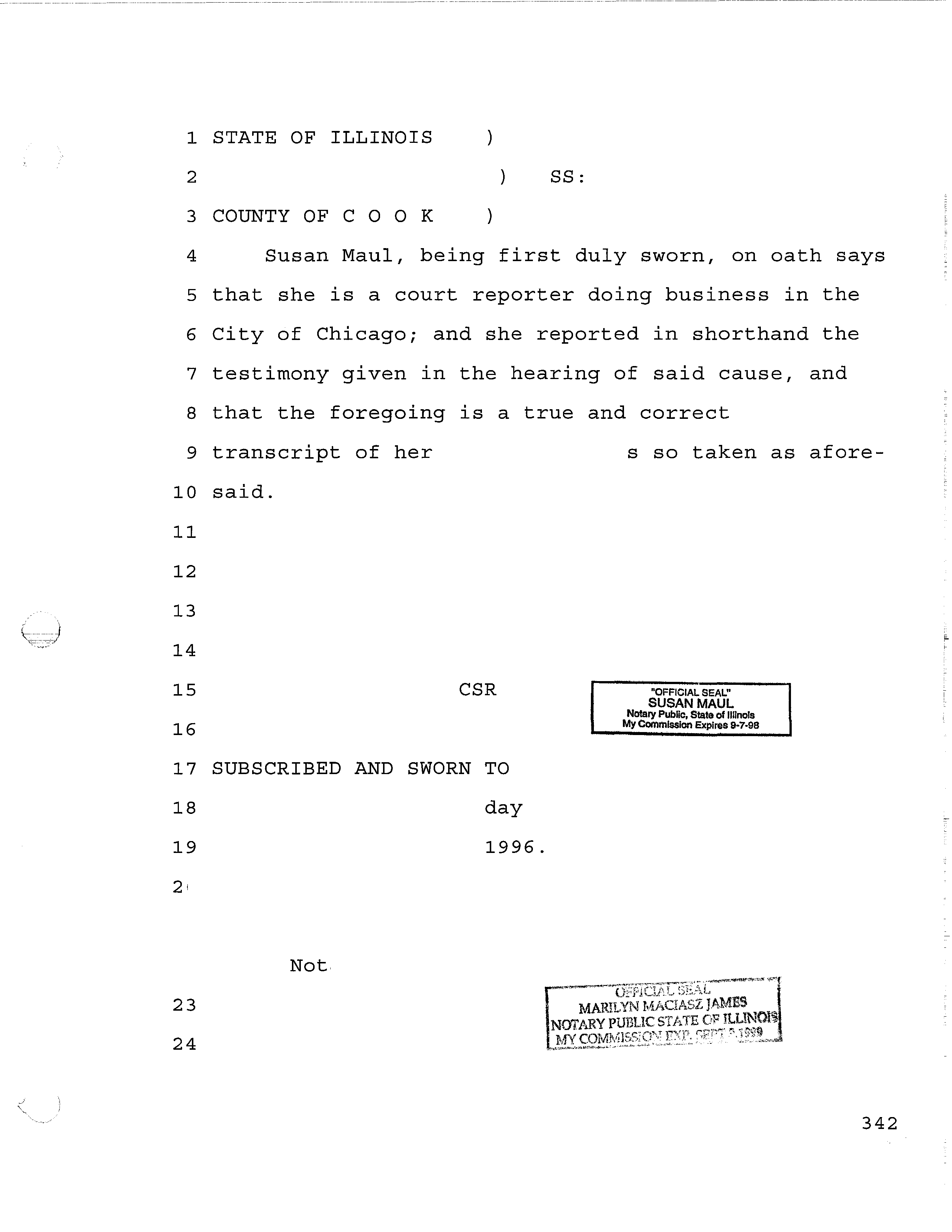1
2
3
4
5
6
7
8
9
10
11
12
13
14
15
16
17
18
19
20
21
22
23
24
BEFORE THE ILLINOIS POLLUTION CONTROL BOARD
CLERK~S
OFFICE
MAR 111996
STATE OF ILLINOIS
IN
THE
MATTER
OF:
POLWTION
CONTROL
BOARD
AMENDMENTS
TO 35
ILL.
ADM CODE 302.202,
302.212,
)
R94-I(B)
302.213,
304.122 AND 304.301)
(Rulemaking)
(Ammonia Nitrogen)
Report
of proceedings
had in the above-entitled
cause, before Ms. Diane O’Neill,
The Hearing Officer,
on February
23,
1996
at the hour of 9:00 o’clock a.m.
At the State of
Illinois Building,
100 West Randolph,
Chicago,
IL,
60601.
APPEARANCES:
MS. DIANE O’NEILL, The Hearing Officer
MR. EMMETT
E.
DUNHAM,
Board Member
MS. AMY HOOGASIAN,
Board Staff
259
1
(Continued)
2
ENVIRONMENTAL PROTECTION AGENCY
3
Bruce
L. Carlson
4
Margaret
P.
Howard
5
Mr. Joel Cross
6
Mr. Dean
J.
Studer
7
Mr. Robert
G. Mosher
8
Mr.
Steve Vance
9
10
11
12
13
14
15
16
17
18
19
20
21
22
23
24
APPEARANCES:
ILLINOIS
Mr.
Ms.
260
1
THE HEARING OFFICER:
Good morning.
This
is a
2 public hearing held by the Pollution Control Board in
3 Docket No. R94-1
(B)
entitled
in the matter of
4 amendments
to 35 Illinois Administrative
Code
5
302.212,
302.213,
304.122 and 304.301 dealing with
6 amendments
to the ammonia nitrogen regulations.
7
My name is Diane O’Neill,
I’m the Hearing
8 Officer for today’s hearing.
With us from the Board
9 today are Board member Emmett Dunham and chairman
10 Clare Manning’s assistant, Amy Hoogasian.
11
And we also have with us from the board’s
12 technical
staff Hiten Soni.
13
Today’s hearing is a continuation
of
the
14 hearing held yesterday on February 22nd,
1996 in this
15 matter.
16
We will begin the testimony today with the
17 prefiled testimony.
At the completion
of the
18 prefiled testimony,
if time allows,
the Board will
19 accept testimony from other parties who have not
20 presubmitted testimony.
21
Before we get into today’s
testimony,
we
22 have some questions from the Board.
23
MR. DUNHAM:
I have basically one question.
24
The definition
of best available technology
261
1
or BAT has
--
BAT has been discussed several times
2 yesterday and in the past in this hearing,
and the
3 fundamental
definition can omit at least two basic
4 possibilities,
one
is by design criterion,
the other
5
is by function.
6
The effluent modified waters definition that
7 has been proposed and the modifications proposed by
8 IAWA and approved by the Agency appear to speak about
9
a definition based on function,
a plant capable of
10 nitrifying.
11
But yesterday when we were talking about the
12 costs to upgrade plants,
the definitions
--
the
13 assumptions
used were design criteria.
14
Does the Agency mean to apply
a functional
15 definition,
those plants nitrifying or capable of
16 nitrifying
or are they talking about
a design
17 criteria?
18
MR.
STtJDER:
I think the answer to your question
19
is probably two fold.
20
First, when
a facility comes in and effluent
21 limits are determined for that facility, the first
22 thing that we do in a construction permit process
is
23 evaluate the hardware that’s available for that
24 sewage treatment plant.
262
1
If there
is a whole section in the
2 recommended standards for sewage works
in Illinois
3
that deals with ammonia nitrogen removal.
4
We do have some facilities
in Illinois on
5 the other hand that don’t necessarily meet the
6 criteria of the design standards for nitrification
7 but do,
indeed,
comply with limits of one and
a half
8 and four.
9
So the answer is the hardware
is what’s
10 looked at during plant design,
and definitely
a
11 facility that complies with those criteria on
12 municipal or domestic sewage treatment basis will
13 meet the functional definition
of complying with one
J
14 and a half and four.
15
However,
if we go strictly by design
16 criteria,
we may very well exclude
a number of
17 facilities
that don’t necessarily meet that criteria
18 but functionally have effluent and approximates
that
19 as a facility that was designed
--
20
MR. DUNHAM:
That was precisely what
I wanted on
21 the record.
Thank you.
22
THE HEARING OFFICER:
We can begin with the
23 presentation
of testimony.
24
We’ll start with the prefiled testimony from
263
1 the Illinois Association
of Wastewater Agencies,
2 Mr. James Daugherty.
3
MR. DAUGHERTY:
I
don’t plan to read the
4 testimony as prefiled, but
I would like to highlight
5
a couple points.
6
THE HEARING OFFICER:
Okay.
We’ll need to swear
7 you
in,
have you identify yourself.
8
(James Daugherty sworn
in.)
9
MR. DAUGHERTY:
My names
is James Daugherty,
I’m
10 employed by the Thorn Creek Basin Sanitary District
11 in Chicago Heights,
Illinois.
12
I’m here representing today the Illinois
13 Association
of Wastewater Agency.
14
Representation
of that group
is described in
15 the original testimony that was presented.
16
The Illinois association
of wastewater
17 Agency supports the adoption of general use of water
18 quality standards
as required to protect aquatic life
19 expected to be present
in Illinois streams.
20
Ammonia nitrogen is known to be toxic to
21 aquatic life and has been regulated by the Board for
22 many years.
23
A large number of wastewater agencies
in the
24 state have already invested an expensive
264
1 nitrification facilities
as result of existing
2 regulations.
3
Because of this construction, much has been
4 accomplished
in controlling
ammonia toxicity in the
5 State of Illinois.
6
The proposed regulations build well upon the
7 past controlled program.
8
The Illinois Association of Wastewater
9 Agencies has previously expressed concern over the
10 limited amount of toxicity data that was available to
11 derive the standards,
that applies particularly to
12 chronic toxicity data.
13
Because of this lack of data,
the Agency was
14 forced to use an acute/chronic toxicity ratio in
15 deriving the chronic standards.
16
This put some question on the accuracy of
17 the proposed chronic standards.
18
In its previous testimony,
the Illinois
19 Association
of Wastewater Agencies has stressed the
20 need for additional
chronic toxicity data and the
21 probable cost effectiveness
of funding such work.
22
Until that work is completed,
the proposed
23 standards must be assumed to be correct based on
24 current derivation procedures
for toxicity limits.
265
1
Secondly,
I would like to highlight what our
2 association sees as the most important concept,
3 affirmed by the Agency’s proposal,
and that
is the
4 treatability levels defined at
1.5 milligrams per
5
liter ammonia nitrogen summer,
4.0 milligrams per
6 liter winter.
7
Treatability
levels are instituted
in the
8 Agency’s proposal through an effluent modified water
9 designation.
10
The Association believes that 1.5/4.0 are
11 the lowest effluent limits that should be written.
12
To respond to the question that was raised
13 this morning,
the Agency’s proposal in trying
to
14 evaluate the impact of these regulations not being
15 adopted,
they present a cost data for plants having
16 to meet winter limits as low as two milligrams per
17
liter.
18
The Agency’s cost analysis was based on a
19 design criteria for treatment facilities
that would
20 basically double the size of aeration tanks from the
21 current requirements.
22
The Association did extensive analysis
of
23 current plant performance
as far as predicted
24 effluent qualities.
266
1
We have not looked at our data,
and I’m not
2
sure our data
--
we have not looked at our data to
3 determine whether that assumption that the Agency
4 made
is correct,
whether simply doubling the size of
5 the aeration tanks would actually allow a plant to
6 produce an effluent of two milligrams per liter in
7 the winter.
8
I think that’s engineering judgment that the
9 Agency
is making that has not been proven,
in fact.
10
The third point
I would like to highlight
is
11 the fact that it’s important that the Board move
12 ahead and adopt
the proposal given the expiration
of
13 Section 304.301.
-7
14
That leaves the state
in a situation where
15 permits are being written that cannot be met by
16 facilities
as the Agency has testified in their
17 additional
comments.
18
When that section did expire,
our
19 Association did not pursue an extension of those
20 regulations
since the current regulations were
21 nearing completion
of their development phase and
22 ready for proposal.
23
We felt it was not necessary to extend that
24 limit
at that time because
of the pending case.
267
1
We do want to emphasize that it’s imperative
2
that the treatability levels of 1.5 and 4.0 be
3 established in the Board’s regulations as soon as
4 possible.
5
The last point
I want to try to make
is
6 addressing actually what the definition
of effluent
7 modified water means.
That’s the key part of this
8 proposal,
it’s been discussed by the Agency.
9
There’s been conflicting comments that I’ve
10 heard
in the hearings that I’ve attended about
11 exactly what that means.
12
Comments by the Agency seem to support that
13 these waters will support all forms of aquatic life
14 expected to be present in those types of streams.
15 Other people have commented that these are areas
16 where water quality standards are going to be
17 ignored.
18
So
I think it’s a valid question and
I would
19 like to try to shed some light on that for the
20 Board.
21
Exactly what type of water quality will be
22 present
in effluent modified water?
23
What
is the expected frequency and spacial
24 distribution
of exceedances
of water quality limits
268
1
in an effluent modified water?
2
The Agency in much of their testimony goes
3 back to their mass balance calculation procedure
4 which
is procedure that’s used to develop an effluent
5 number.
6
The goal of that procedure
is to determine a
7
single number to put
in a permit on a seasonable
8 basis for effluent limits.
9
Unfortunately that procedure really didn’t
10 shed much light on the actual water quality expected
11 on a real basis
in a receiving stream.
-
12
The Agency has made some general comments,
I
13 might quote just a couple from the original testimony
14 submitted by the Agency on page fifteen of
15 Mr. Mosher’s comments,
stated that these facilities
16 discharge receiving streams with little or no
17 permanent upstream flow to provide dilution for the
18 ammonia bearing effluents.
19
These streams
at least periodically cannot
20 be expected to meet water quality standards
as herein
21 proposed.
22
For Mr. Studer’s comments on page fifteen
--
23 I’m sorry, page thirteen,
as
I just discussed,
24 facilities that were designed and constructed
to
269
1
2
3
4
5
16
17
18
19
20
21
22
23
24
nitrify can expect monthly average concentrations
of
1.5 milligrams per liter total ammonia during the
favorable warm weather.
These facilities generally cannot comply
with chronic ammonia water quality standards
in cases
6 where the pH in the receiving stream is above
7.8 and
7 where the receiving water offers
little or no
8 dilution effects.
9
I believe that the actual compliance
rate
10 with water quality standards in an effluent modified
11 water will be quite high,
and
I hope that my comments
12 this morning will shed some light on that.
13
It’s a little complicated analysis,
and the
14 reasoning that goes from step to step,
so please bear
15 with me.
I
think if you stay with me and come out at
the end, you’ll have a clearer picture of what
actually happens
in effluent modified water.
I’ll go
slowly not to try to confuse myself.
Let’s start with the effluents.
Our
Association did a survey of a large number
of
treatment plants,
we collected data actually from
thirty-seven plants and did editing on that data for
the ones that were not nitrifying,
it was two years
270
1 worth of daily data.
7
8
9
10
11
12
13
14
15
16
17
18
19
20
21
22
23
24
2
From analysis of that data,
it’s clear that
3
a facility with an effluent permit
of one and a half
4 will discharge an effluent during the summer at
or
5 below 0.5 milligrams
per liter fifty percent of the
6
time.
They will discharge an effluent at
or below
one milligram per liter
75 percent of the time.
And they will discharge an effluent below
1.9
90 percent of the time.
These are daily
discharge analysis.
This is from our survey.
It’s also
--
these
values can be found in the Agency table
12 in the
original testimony.
So this is actual plant effluent
from a permit with one and a half.
We also need to look at the pH and
temperature
of the effluents.
The pH and temperature
of the effluents are generally lower,
and they vary
less than stream pH and temperatures
do.
The summer stream pH is above
7.8 as
in Mr.
Studer’s comments are common.
The ratio of
un-ionized ammonia to total ammonia
is quite small
at
a pH of let’s
say seven and a half.
As the pH increases above that and gets up
271
1
to the 7.8 or higher point,
the fraction of total
2 ammonia present
at un-ionized begins to increase
3 rather quickly.
So that 7.8 is kind of an important
4 figure.
5
The analysis
of effluent data shows that
6 summer effluent pH’s are almost never above
7.8.
7 From our survey data,
it showed that
90 percent of
8
the summer pH’s were below
--
at or below 7.8,
so
9 only ten percent
of the time are the actual pH’s
--
10 the effluents above that limit to where
a larger
11 fraction of the ammonia present
is un-ionized.
12
MR. DUNHAM:
Is that effluent data or is that
13 instream data?
14
MR. DAUGHERTY:
This
is all effluent
data.
15
MR. DUNHAM:
Thank you.
16
MR. DAUGHERTY:
The third factor
is temperature.
17 The same statement
is true for temperature.
18
The temperature
of effluents tend to be
19 lower during the summer of the streams and they tend
20
to vary less.
21
To try to get a picture
of how this relates
22
to actual allowable ammonias,
if you select
a
23 temperature
of twenty-four degrees centigrade
and a
24 pH of 7.75 which is one of the columns
in the
272
1 Agency’s table, that temperature and pH,
the
2 allowable ammonia based on the chronic
summer
3 standard as proposed by the Agency would be 1.65.
4
Using the recalculated
chronic limit of
5
0.57,
this would actually be 1.88,
so 1.88 or 1.9
6 would be allowable any time the pH and temperature
7
are below twenty-four degrees centigrade and a pH of
8
7.75.
9
In looking at actual pH and temperature
data
10 of treatment plants,
I
found that only two percent
of
11 the time does the pH and temperature
of
an effluent
12 exceed twenty-four degrees centigrade and 7.75.
13
So
I
think it’s clear from all these
14 comments that effluents almost never contain
15 un-ionized ammonia above the chronic water quality
16 standards
as they leave the plant.
17
We’re talking about one or two percent
of
18 the time that might occur.
19
I’m saying that only two percent
of the time
20 are the dischargers
--
only two percent
of the time
21 are the pH and temperature
of the discharge above
22 that twenty-four degrees centigrade and 7.75.
23
And only ten percent of the time as
I
24 mentioned earlier does the ammonia in the effluent
273
1 exceed 1.9 which
is the allowable at that level.
2
So when you combine the two,
it’s even
--
3
the probability is even less than the combination
of
4 those two that this would actually occur.
5
So I’m saying basically that one percent of
6
the time or less would an effluent from a plant with
7
a permit
of one and a half actually have un-ionized
8 ammonia present that would exceed the chronic
limit.
9
I told you this was going to be
10 complicated.
11
I think this
--
some of this needs
to be
12 understood to have a true understanding
of what
13 effluent modified water really means.
14
All of this discussion has simply been about
15 effluents.
Now what’s more important
is what happens
16 when it enters the receiving stream.
17
A number of things happen when the effluent
18 mixes
--
enters the receiving stream.
19
No.
1, mixing occurs.
Mixing actually does
20 three different things.
21
Typically the upstream ammonia is much lower
22 than a plant effluent ammonia,
so the total ammonia
23
as they mix decreases.
24
As
I stated earlier,
typically the pH is
274
7
8
9
10
11
12
13
14
15
16
17
18
19
20
21
22
23
24
1 higher in the stream,
so the pH goes up,
that’s not
2 good because that creates more un-ionized ammonia.
3
The temperature also goes up,
that creates
4 more un-ionized ammonia from the same amount of total
5 ammonia,
but as
I stated,
dilution is diluting the
6 total amount
of ammonia.
So what is the net effect
of all this?
It’s
very hard to predict.
It depends on many things.
It depends on the mixing ratios.
It depends
on the difference
in the pH and temperatures.
It depends on the alkalinities
of the two
waters which is often not measured.
It depends on
the upstream ammonia.
Something also that happens
is even if
there’s no dilution,
we find that as an effluent
enters
a stream and travels downstream,
the pH and
temperature tend to increase gradually just due to
natural causes.
So even without any mixing,
that’s
going to occur.
The third thing that occurs
is
nitrification.
Nitrification
is a natural
phenomenon,
it occurs
in the stream.
The operation in the plant actually is using
the same microorganisms that occur naturally
in the
275
1 stream.
2
Typically nitrifying organisms are attached
3
to the substream on the bottom and sides
of the
4 stream,
so if they’re present even in a small
stream
5 the rate of nitrification
can be very large.
6
Obviously that’s affected by temperature,
7 and in summer conditions
that would tend to increase
8
the rate of nitrification.
9
In a large
stream,
the pH and temperature
of
10 the mixed stream and effluent would approach the
11 ambient levels of the stream as far as pH and
12 temperature and would tend to be higher than the
13 effluent.
14
In a large stream there’s also significant
15 amount
of mixing available.
16
The data presented on the Fox River by the
17 Fox Metro facility and the Ammonia Group was a good
18 demonstration
of the effects
of dilution and mixing
19 on a large river.
20
In
a small stream,
the mixture would tend to
21 equal the lower pH and temperature
of the effluent
22 which would be favorable
in producing less un-ionized
23 ammonia out of the total
ammonia.
24
Gradually the pH and temperature would
276
1 increase as it goes downstream,
but also that would
2
be offset by nitrification that occurs
in the
3
stream.
4
Now,
the events
I’ve described occur in
5 three dimension,
the effluent mixes across the depth
6 and width of the stream,
together they travel
7 downstream.
8
The three phenomenon mixing,
nitrification
9 and pH and temperature
increase are all occurring in
10 a complex spacial pattern.
11
Two of these work to decrease the total
12 amount of ammonia.
13
The third tends to increase the fraction
of
14 un-ionized ammonia present for a given concentration
15 of total ammonia.
16
The combined effect of the three
is that the
17 un-ionized ammonia in effluent which as
I stated at
18 the beginning is almost never above the chronic
19
limits,
and typically is only half of the chronic
20 limit would be
--
would generally stay below the
21 proposed water quality standards.
22
Stream segment classified
as an effluent
23 modified water would have a very high rate of
24 compliance with the proposed water quality
277
1
standards.
2
This analysis looked at summer conditions.
3 Most of these same phenomenon occur in the winter,
4 and I’m not going to go through that.
5
What
I presented is some very hard data,
6
real data on plant effluents that we have available
7 and then
a descriptive account of what takes place
in
8
the stream.
9
I believe this supports two conclusion,
one,
10 an effluent modified water would have a high rate of
11 compliance with the proposed chronic water quality
12 standards.
Some exceptions should be expected.
That
13
is why the classification
is needed.
14
However,
the excursions are not expected to
15 be common, probably are quite small
in magnitude and
16 may even be rare.
17
The second point
is that it’s not practical
18
to know the frequency or the location of excursions
19 of the proposed water quality standards
in an
20 effluent modified water.
21
Physical sampling would require hundreds
of
22 samples across the width and length
of a stream.
23 Such a major effort would only define the conditions
24 on one day.
The next day could be a different
case.
278
1
Modeling could be used to try to predict
2 these conditions.
The above mosaic
of events
3 requires
a very complex model.
4
Any modeling effort would require extensive
5
calibration,
and this has not been done by anyone
to
6 my knowledge.
7
I hope this picture
is somewhat useful to
8
the Board in understanding exactly what an effluent
9 modified water means.
10
I think the most important point
is that the
11 best tool for evaluating effluent modified water
12 impacts
is a tool that the Agency presented,
and that
13
is biological
sampling.
14
Biological
sampling looks at all these
15 events mixed together.
It reflects not just present
16 water quality on the day that the sampling is done,
17 water quality over the previous months or year.
18
The Agency has testified that they have not
19 seen biological
impacts in stream segments typical
of
20 those that would be designated effluent modified
21 waters.
22
I think this
is consistent with the picture
23 that
I presented.
I hope this is useful to the
24 Board.
279
1
THE HEARING OFFICER:
Thank you.
Off the record
2 for a minute.
3
(Discussion had off the record.)
4
THE HEARING OFFICER:
I would like to enter the
5 testimony presubmitted by the Illinois Association
of
6 Wastewater Agencies and admit
it into the record as
7 an exhibit and enter
as if read.
This would be
8 Exhibit No.
51.
It’s the testimony from James
9 Daugherty on behalf
of the Illinois Association
of
10 Wastewater Agencies as filed with the Board
on
11 January
26,
1996,
and that’s Exhibit
51.
12
The Board also did receive some prefiled
13 questions
from the Sierra
Club,
however,
there
is no
14 representative
from the Sierra Club with us today,
so
15
I will just read the questions into the record,
and
16 allow Mr. Daugherty to answer
them.
17
THE HEARING OFFICER:
Question No.
1, why is it
18 self-contradictory for the Agency to deny effluent
19 modify water status and establish more stringent
20 effluent standards?
21
MR. DAUGHERTY:
By that statement
I was meaning
22 that the Agency has defined
--
has present testimony
23 that the best available treatment technology will
24 produce
--
only produce effluents of 1.5 and 4.0.
280
1
When the Agency issues
a permit,
they’re
2 issuing a permit that they’re requiring to be met,
3 and they plan to take enforcement action
if it
is not
4 met, but they’re issuing a permit that they have
5 stated is not
--
cannot be met with best available
6 technology.
7
In this proceeding they presented cost data,
8
cost impact of this proceedings and they have not
9 included cost for those cases,
so that’s what
I was
10 intending to convey.
11
THE HEARING OFFICER:
Question No.
2,
we do not
12 understand why the proposed revisions to Section
13 302.213 would improve the proposed regulations.
14 Please explain.
15
MR. DAUGHERTY:
We felt item one under that
16 section which says that the Agency shall not identify
17 water body as effluent modified if
it received
18 effluent discharges
that do not meet requirements
of
19 administrative Code 304.122 prior to the dilution
20 with the receiving water,
we felt that was unclear as
21 to exactly what was intended by that section.
22
It was our understanding that all
23 dischargers
to an effluent modified water would be
24 required to meet one a a half for
--
that would be
281
permit conditions.
If those conditions were not met,
there
would be standard NPDES enforcement
proceedings.
It was not clear to us what additional
intent was intended with that language.
We felt our
language was clearer.
THE HEARING OFFICER:
Question No.
3,
why would
it improve proposed ammonia standard to fix effluent
standards
for the effluent modified water d±schargers
as
in your recommended changes to Section
304.122 (d)?
MR. DAUGHERTY:
I’m not sure
--
I don’t
understand the question unfortunately.
The effluent
standards that we’re proposing
to fix with our language
I
think is the same as the
Agency’ s proposal.
Part of the proposal that we were unclear
about was the statement that says must demonstrate to
the Agency that their effluent shall not exceed
averages
of
1.5 total ammonia during the summer and
four in the winter.
We were not sure what was intended by must
demonstrate,
and we felt our language was clearer,
more straight forward application
of that
1
2
3
4
5
6
7
8
9
10
11
12
13
14
15
16
17
18
19
20
21
22
23
24
282
1 requirement.
2
THE HEARING OFFICER:
That completes the Sierra
3
Club’s questions that it had prefiled.
Are there any
4 questions
from the Board?
5
MR. DUNHAM:
I actually have one.
You stated
6 that exceedances would be rare in a well run
7 nitrifying plant.
8
Section 302.213 (a) (2)
as proposed says the
9 Agency shall not identify a water body as an effluent
10 modified water if it exceeds the acute standard.
11
Occasionally,
by calculation the acute
12 standard will be less than the effluent standard of
13 1.5.
14
Is there
a possibility that
--
have you
15 discussed the possibility
of occasional rare
16 exceedances
in the context
of obtaining an effluent
17 modified water body classification?
18
MR. DAUGHERTY:
I guess I’m a little unclear.
19 I’m not really aware
of actual conditions
that would
20 produce limits below 1.5 based on acute standards
--
21 well, very high pH’s.
22
MR. DUNHAM:
Yes.
Instream pH,
though.
23
MR. DAUGHERTY:
These are instream pH,
typically
24 measured miles downstream of the effluent.
283
1
They’re not pH’s that would be expected in
2 the ZID,
certainly because the ZID is dominated by
3
the effluent, probably not expected in the majority
4
of the mixing zone,
and by the edge of the mixing
5
zone the total ammonia
is probably significantly less
6 than at the effluent,
so
I would not expect
those
7 conditions
to occur,
so I’m not sure how to answer
8 the question.
9
MR.
STUDER:
Can
I elaborate on that for
a
10 moment?
11
MR.
DUNHAM:
Please do.
12
MR.
STtJDER:
You use the concept of a ZID, but
13 the agencies indicated thtese effluent modified
14 waters would be in very small streams,
consequently
15 there really would be no ZID and there really would
16 not be a mixing zone allowed.
17
However,
as you testified earlier regarding
18 the pH and temperature
of the effluent in combination
19 with the ammonia,
the Agency would expect that the
20 acute standard would very rarely be exceeded simply
21 because the pH in the actual effluent itself which is
22 primarily what’s being discharged to this low flow or
23 no flow stream would be extremely low,
therefore,
I
24 would not expect the pH in that stream to reach the
284
1 high numbers that would cause the acute standard to
2 be lower than 1.5,
for example.
3
MR. DUNHAM:
My problem
I guess
is that the
4 language
“shall not”
is a directive,
and it does not
5
admit of any exceedances of the acute standard,
so
if
6 you have rare occasional exceedances
in your data
7
set, will you be able to grant or not be able to
8 grant an effluent moditifed waters designation?
9
Should the definition be reworked to say
10 exceed the acute standard
95 percent
of the time
11 or
--
or not exceed the standard 95 percent
of the
12 time,
to admit of the occasional possibility that
13 a
--
an even well run plant might have an upset day
14 or an upset month?
15
MR.
STtJDER:
I can never
I guess rule out the
16 possibility
of ammonia upset
in biological
treatment
17 for ammonia.
18
MR.
DUNHAM:
Nitrosomonas
is a rather delicate
19 organism,
the process
is easily upset.
20
It’s easily washed through,
it has all kinds
21
of potentials
for mischief.
22
MR. MOSHER:
I think
the Agency intends
--
well,
23
I know we intend to place the acute standard in these
24 permits as the daily maximum concentration,
so when
285
1
that rare event happens,
it will go down as
a permit
2 violation.
3
Appropriate measures then occur.
If there
4 are too many of those violations
to get that plant
5 back in working order to avoid those types of things,
6
so we would look at that as the safeguard for having
7 acute standards violated
in the water body itself.
8
MR.
DUNHAM:
That notwithstanding,
if the
9 effluent modified waters designation
is removed
10 because there
is an occasional upset,
the effect of
11 that will be the chronic standards will take effect
12 and you’ll have quite likely a very large series of
13 violations
occurring,
you could envision several more
14 violations
as
a result
of that.
15
What is the Agency’s position or what is
--
16 what is the use of multiplying or magnifying
the
17 number
of violations when you have a very well
18 operated plant and
--
that has an occasional upset?
19
MR.
MOSHER:
It’s not our intent to revoke the
20 effluent modified water designation unless some
21 extreme circumstances
occur.
22
We feel the existing NPDES permit
system is
23 the best thing to keep plants within that
--
those
24 guidelines
of best degree
of treatment.
286
1
MR. DUNHAM:
I guess
I was looking for that
2 statement
in your intent.
3
MR. MOSHER:
That’s our intent.
4
MR. DAUGHERTY:
Can
I comment on that as well?
5
MR. DUNHAM:
Please.
6
MR. DAUGHERTY:
I think what
--
what
I understand
7 you’re getting at
is the wording change that we
8 proposed may also be applied to the acute standards,
9 simply say in effluent modified water,
the acute
10 standards shall be met.
11
To clarify that what the Agency has stated
12 would not be the case,
in that one violation of an
13 acute
standard in ten years will not result
in loss
14 of effluent modified water status.
15
MR. STUDER:
The only comment
I can make
is any
16 changes
in the language dealing with that,
I can
17 agree
in concept, however,
this proceeding
is a
18 federally mandated change, and
I
can’t guarantee we
19 won’t get federal approval on that.
20
I can reiterate what the intent of the
21 Agency
is,
and the intent
of the Agency when we issue
22 the permit for an effluent modified waters
is to
23 write a daily maximum
in that permit
that would be
24 protective
on the acute standard.
287
1
That’s typically how the daily max and NPDES
2 permits are arrived when there
is an acute and
3 chronic standard,
and the permit would be written
4 with a daily maximum that the Agency believes to be
5 protective
of the acute water quality standards.
6
Obviously if there’s violations
of that
7 permit,
then they are to try to bring the discharger
8 back into compliance.
9
MR. DAUGHERTY:
Do you think the USEPA thinking
10 is an effluent modified water designation should be
11 lost based on a single exceedance
of an acute
12 standard?
13
Is there any reason to believe that’s their
14 thinking,
if that’s the gist of the change?
15
MR.
STUDER:
I
can’t say with any definitive
16 answer that that’s positively their thinking.
17
I would guess that specifically in a case of
18 a plant upset,
that the designation probably would
19 not be lost.
20
It’s not the Agency’s intent to do that,
and
21
I
don’t really believe it’s USEPA’s intent to do
22
that.
23
Like
I
said,
I
can’t say with any great
24 degree of certainty.
288
1
MR.
CUNNINGHAM:
Can
I ask
a question
of Dean?
2
It actually goes back to a statement he said.
3
Dean,
I believe that you had indicated that
4
in the smaller streams where you anticipate
that
5 effluent waters
--
modified waters will generally be
6 granted,
that in looking at the acute standard,
7 you’re really looking at an effluent dominated stream
8 and you wouldn’t expect the acute values
to be
9 exceeded because of that lower pH of the effluent.
10
Yet what
--
doesn’t the Agency intend to
11 establish those acute standards based upon istream pH
12 rather than effluent pH?
13
MR.
STtJDER:
That’s correct.
14
MR. CUNNINGHAM:
Isn’t there some contradiction
15 there?
16
MR. STUDER:
When you’re discharging to a stream
17 that has no flow in it,
the stream is actually the
18 effluent
itself.
19
What I’m saying,
as that effluent proceeds
20 downstream,
the normal process would occur and those
21 were elaborated on by Mr.
Daugherty.
22
MR.
CUNNINGHAM:
Wouldn’t
it also then be true
23 that even though you wouldn’t expect the actual
24 standard to be violated that the permit limit you
289
1 would come up with,
you would anticipate might be
2 violated?
3
MR.
STtJDER:
You have to remember that
if you’re
4 discharging to an effluent modified water,
the
5 predominant permit
limit
is not going to be driven
--
6
that permit
limit
is going to be driven by the
7 chronic number.
8
Typically the only time the daily max in
a
9 permit
is the extreme dominating or driving force
is
10 on a large body of water.
11
We do not expect dischargers
to large bodies
12 of water to need or to obtain effluent modified water
13
status.
14
MR.
CUNNINGHAM:
Are there Agency questions
of
15 Mr. Daugherty?
16
THE HEARING OFFICER:
Does the Agency have any
17 questions for Mr. Daugherty?
18
MS.
HOWARD:
No.
19
MR.
CUNNINGHAM:
I have a couple.
20
THE HEARING OFFICER:
Are your questions
for
21 Mr. Daugherty?
22
MR.
CUNNINGHAM:
Yes.
23
THE HEARING OFFICER:
Okay.
Go ahead.
24
MR.
CUNNINGHAM:
Jim,
I believe
a couple points
290
1
in your testimony you made reference to best
2 available control technology
in reference to the
1.5
3 and
4 limit.
4
I believe generally in this proceeding
5 you’ve been talking about the best degree of
6
treatment.
Were you using those terms
7 interchangeably?
8
MR. DAUGHERTY:
Yes,
I was.
9
MR. CUNNINGHAM:
You also mate made a statement,
10
I believe,
that the
--
that IAWA concluded that the
11 Agency used appropriate procedures
for the
12 calculation of their chronic limits.
13
Are you aware that there are other Federally
14 approvable procedures
that would come up with
15 somewhat different numbers than the procedures
that
16 the Agency used?
17
MR. DAUGHERTY:
Yes.
18
MR. CUNNINGHAM:
Okay.
That’s
it.
19
MR.
STUDER:
I have a question.
You indicated in
20 Mr. Cunningham’s
last question,
Federally approvable,
21 you don’t know if those mechanisms
have been approved
22
or have been examined?
23
MR. DAUGHERTY:
I know they’re present in the
24 Federal document.
291
1
MR.
STUDER:
Has the methodology or the exact way
2 that those have been derived been presented?
3
MR. DAUGHERTY:
No, not to my knowledge.
4
THE HEARING OFFICER:
Okay.
Then
I
think that
5 completes the questions
for Mr. Daugherty.
Thank you
6
for your testimony.
7
The next prefiled testimony we have is from
8 James Huff on behalf of the Ammonia Group.
9
Mr. Huff,
you were sworn in yesterday
in
10 this proceeding when you answered the questions from
11 the Sierra
Club,
I would remind you that you’re still
12 under oath.
13
MR.
HUFF:
Yes,
ma’am.
14
JAMES HUFF,
15 called as a witness herein,
having been previously
16 sworn, was examined and testified as follows:
17
EXAMINATION
18 BY MR.
CUNNINGHAM:
19
Q.
Actually I’m not sure that we really went
20 through this before,
so we’ll do a little
21 introduction.
22
Would you state your name for the record?
23
A.
James
E.
Huff,
H-u-f-f.
24
Q.
And where are you employed?
292
1
A.
I’m employed by Huff
& Huff Incorporated.
2
Q.
And what
is your position with Huff
& Huff
3 Incorporated?
4
A.
Vice president.
5
Q.
And have you been retained in your capacity
6 with Huff and Huff to do some work for them for the
7 Ammonia Group with respect to the ammonia nitrogen
8 standard that are at issue today?
9
A.
Yes,
I have.
10
Q.
Could you briefly outline what sort of
11 efforts you’ve been involved in?
12
A.
I’ve been involved in basically reviewing
13 the Agency proposal,
R94-1.
14
And in addition,
I was project manager on
a
15 study of the Fox River that included a lot of the
16 same lines that’s relevant to these proceedings.
17
Q.
In the course of your work for the Ammonia
18 Group,
did you prepare some presubmitted testimony
19 for this hearing?
20
A.
Yes,
I did.
21
Q.
Does that presubmitted testimony remain true
22 and accurate to the best of your knowledge and
23 belief?
24
A.
Yes,
it does.
293
1
MR.
CUNNINGHAM:
I would like to have that
2 presubmitted testimony entered as an exhibit.
3
THE HEARING OFFICER:
Do you have an extra copy
4
of that?
5
MR. CUNNINGHAM:
We must.
Actually
I left out
6 all my extra copies yesterday and people took them.
7
THE HEARING OFFICER:
The Board does have a
8
copy.
I’ll enter it into the record.
This
is the
9 revised
--
10
MR. CUNNINGHAM:
Right.
11
MR. DUNHAM:
We have two sets,
which are are you
12 entering, both or only one?
13
MR. CUNNINGHAM:
Both of them.
They need to be
14 really put together.
15
The second one kind of give directions
on
16 how it modifies the first.
17
Actually if you think it would be useful
for
18 purposes of this hearing,
I do have a copy of the
19 combined one that
is really what is final document
20 should look like.
21
THE HEARING OFFICER:
I think that would be
22 better to enter it into the record,
the more
23 complete.
24
MR. CUNNINGHAM:
I would like to keep the pink
294
1
one because
I know it’s the original.
Could
I have
2
those brought over to the Board this afternoon?
3
THE HEARING OFFICER:
Okay.
4
MR. DUNHAM:
I guess
I need to say we have an old
5
set of testimony,
a new set of testimony,
several
6 exhibits and an ammonia water quality study,
are you
7 entering all of that?
8
MR.
CUNNINGHAM:
They’re all intended to be part
9
of that submission.
10
MS. HOWARD:
Could the Agency at this time
11 request
a copy of that also?
12
MR. CUNNINGHAM:
Sure.
I missed something of
13 yours yesterday,
too.
I will have to figure out what
14 that was and get a copy of
it
15 BY MR.
CUNNINGHAM:
16
Q.
Also,
Mr. Huff
--
17
THE HEARING OFFICER:
Let’s put that
in,
it’s the
18 testimony of James Huff,
and it’s Exhibit
52.
19
MR. STUDER:
Can we ask the study be entered as a
20 separate exhibit number?
21
MR. CUNNINGHAM:
It was referenced in the
22 testimony and cited as being separately attached or
23 separately enclosed.
24
I don’t care if you give
it
a separate
295
1
2
3
4
5
6
7
8
9
10
11
12
13
14
15
16
17
18
19
20
quality
MR.
the
MR.
I
number or
--
MS. HOWARD:
It would make it easy for us to
refer to.
MR.
DUNHAM:
Okay.
THE HEARING OFFICER:
So the testimony of James
Huff then is
52, and 53 would be the ammonia water
study on the Fox River.
DUNHAM:
The testimony itself has attachments
for
record.
CUNNINGHAM:
Right.
Thank you.
In terms of copies, would the Board like
multiple copies of the whole final
--
THE HEARING OFFICER:
Yes.
MR. CUNNINGHAM:
Okay.
Five?
THE HEARING OFFICER:
Five would be good.
BY MR. CUNNINGHAM:
Q.
All right.
In the course of your work on
this matter,
Mr.
Huff,
have you also prepared
responses to questions that were prepared by the
Agency?
21
A.
Yes,
I
have.
22
Q.
And
have you brought those with you here
23 today?
24
A.
Yes,
I have.
296
1
Q.
Are these them?
2
A.
Yes.
3
Q.
I have several copies of what is entitled a
4 response to questions for James
E. Huff by the
5 Environmental Agency pertaining to the proposed
6 amendments,
is that what you were just referring to?
7
A.
Yes,
it was.
8
MR.
CUNNINGHAM:
Now,
I presume that Mr. Huff’s
9 testimony is entered as of read?
10
THE HEARING OFFICER:
Right.
11
MR.
CUNNINGHAM:
Mr.
Huff,
would you like to
12 summarize what was in your written presubmitted
13 testimony?
14
MR. HUFF:
Yes.
My presubmitted testimony was
15 intended to address the questions raised by the Board
16 at the prehearing conference of November 8th.
17
The six communities that
I represent,
I’ll
18 just briefly go through those and bring the Board up
19 to date on what steps have been taken.
20
In the case of Batavia,
this is a plant that
21 currently is averaging
3 million gallons a day.
The
22 plant is designed for approximately 3.6 million
23 gallons per day.
24
Over the first eleven months of 1995,
it’s
297
1 effluent average
is 0.20 milligrams per liter total
2 ammonia nitrogen,
so Batavia has made excellent
3 progress toward reducing it’s ammonia discharge.
4
This has been done through taking advantage
5 of a storm water first flush basin for equalization,
6 providing aeration of the digested sludge prior to
7 dewatering.
8
They reconditioned their fine bubble
9 diffusers,
and they installed an additional
--
or
10 operating their backup blowers to increase dissolved
11 oxygen levels in the aeration basins.
12
The plant right now currently is loaded at
13 about twice the design level for a single stage
14 nitrification facility.
15
In order to meet a one and a half and four
16 at a design capacity,
Batavia’s engineers have
17 estimated $5.3 million in capital will be required.
18
There was four acute toxicity bioassays that
19 were completed in 1995 on Batavia’s effluent and
20 there was no observed toxicity.
21
The second community is the Galesburg
22 Sanitary District.
They had a major industry in town
23 that ceased operations July 1st,
1995 that was
--
24 approximately 30 percent of their organic load was
298
1 contributed by this industry.
2
Over the five months since that industry has
3
shut down, the district effluent ammonia has averaged
4 1.01 milligrams per liter.
5
And
that can be compared to the same five
6 months from ‘92 to
‘94 when the average was 1.64
7 milligrams per liter,
so they’ve seen an overall
38
8 percent reduction in the first five months directly
9 attributable to the shut down of this industry.
10
The district started up this past winter a
11 several thousand gallon batch biological reactor to
12 look at treatment of digester supernatant.
13
We are currently running the system right
14 now,
and we’re consistently getting ammonia
15 reductions from greater than 240 milligrams per liter
16 of ammonia nitrogen down to less than one milligram
17 per liter nitrogen,
so the district is making
18 excellent progress toward reducing its ammonia
19 effluent.
20
In order to meet a one and a half and four
21 effluent limits,
the district would have to spend
22 somewhere between 2.2 and $4.4 million.
23
The Agency is determined that Cedar Creek is
24 ammonia impaired, and the appropriate winter limit is
299
1
1.4 milligram per liter.
2
We’ve estimated
it
will cost in excess of
3
$10 million to bring that facility into compliance
4 with a 1.4 effluent limit for the winter.
5
The Geneva treatment plant
is designed for
6 four million gallons a day treatment capacity.
7
Over the last year,
they’ve increased the
8 operating depth in the aeration basins in an attempt
9 to incrase retention times.
10
They also placed their standby blowers
in
11 operation to increase the dissolved oxygen in the
12
aeration basins.
13
1994
they
averaged
12.4 milligrams per liter
I
14 ammonia.
During 1995,
they averaged 5.1 milligrams
15
per liter,
so they also have made significant strides
16 in the last year.
17
Geneva right now is currently evaluating the
18 feasibility of pretreatment of its digester
19 supernatant,
similar to what Galesburg is doing.
20
On November 15,
1994,
the USEPA performed
21 biomonitoring inspections on the City of Geneva’s
22 wastewater treatment plant effluent and no toxicity
23 was observed.
24
In order to bring this facility in
300
1 compliance with the R94-1 proposal, Geneva has
2 estimated it’s going to cost $2.1 million to bring
3 that facility into compliance.
4
The City of Rock Falls is designed to handle
5 2.65 million gallons per day.
6
They have submitted to the Agency a plan to
7 upgrade the aeration of its aerobic sludge digester
8 with the hopes that that will reduce
its ammonia
9 level
in its effluent.
10
If they’re required to put in nitrification
11 facilities, Rock Fall’s engineers have estimated it
12 will cost $2.5 million.
13
The City of St. Charles also located on the
14 Fox River has a plant designed for nine million
15 gallons a day, and it’s currently running at about
16 half the capacity.
17
Over the first eleven months in 1995,
the
18 treatment plant discharged an average of 2.3
19 milligrams per liter ammonia, significantly down from
20 where they were several years ago.
21
The steps they’ve taken,
one, they’ve been
22 able to increase the sludge age and the activated
23
sludge process.
They upgraded their fine bubble
24 diffusers in 1994.
301
They are just bringing on line this month a
aeration system to take the digested sludge filtrate
from the belt filter presses and basically put that
through an activated sludge type process and trying
to get nitrification.
They had done some pilot plant work.
Their
digester filtrate averages about 900 milligrams per
liter ammonia nitrogen, very high.
And based on the pilot plant,
they expect to
be able to reduce that to 20 milligrams per liter in
stream alone.
Recently they’ve had two series of aquatic
tests conducted on their effluent by USEPA,
concluded that there was no significant
observed.
My firm completed a mixing zone study for
the City of St. Charles during 1995,
and we attempted
to track ammonia in the mixing zone,
and within fifty
feet downstream and fifty feet offshore the ammonia
levels have reached background levels.
By 5400 feet downstream, we were also
tracking chlorides,
we got a dilution ratio of 75 to
one at that point for conservative pollutant.
To upgrade the St. Charles facility to meet
1
2
3
4
5
6
7
8
9
10
11
12
13
14
15
16
17
18
19
20
21
22
23
24
that one
toxicity
and USEPA
toxicity
302
1 the anticipated limits under R94-1 will cost an
2 estimated $6.2 million.
3
And the last community is Sterling.
They’ve
4 got a plant designed to meet 3.6 million gallons a
5 day.
6
They currently discharge an effluent that’s
7
as high as twenty milligrams per liter.
8
And as Mr. Mosher indicated yesterday, he
9 believes they are somewhat of
a unique facility, and
10 the Agency is working with them on trying to come up
11 with some type of zone of initial dilution that may
12 preclude treatment costs.
13
If they have to put in nitrification
14 facilities,
they’re looking at in excess of $10
15 million.
16
We also as part of our Fox River study,
17 include a report on the overall Fox River fishing,
18 sport fishing prepared by the Department of
19 Conservation.
20
And the report indicates there are 61
21 species on Fox River,
and of the top ten sport fish
22 species since
1990,
two have shown a significant
23 decline
in trend, yellow bass and channel catfish,
24 four have shown a significantly increasing trend,
the
303
1 carp,
largemouth bass,
the white bass and the black
2 crappie.
3
The remaining four species,
the bluegill,
4 smallmouth bass,
yellow perch and walleye have shown
5 no increase or decreasing trend.
6
Overall the fish quality is excellent on the
7 Fox River.
8
We also included in the attachments
some
9 letters from some professional sport fishermen,
radio
10 sport hosts and bait shop owners on the Rock River
11 that indicate there as well that the fish quality has
12 never been better on the Rock.
13
The one year study that we completed on the
-j
14 Fox River Mr. Studer talked about yesterday that
I
15 substantially concur with his analysis of what our
16 attempt was.
17
We wanted to look to see if there was a
18 problem with un-ionized ammonia on the river as a
19 whole.
20
We looked at
--
nineteen stations were
21 sampled weekly along with eight tributaries over that
22 period of time.
23
What we found is that the overall summer
24 total ammonia levels in the Fox River was 0.2
304
1 milligrams per liter and the overall winter number
2 was 0.28 milligrams per liter.
3
The overall average summer un-ionized
4 ammonia was a very low 0.005 milligrams per liter and
5 the winter un-ionized ammonia average was a low 0.002
6 milligrams per liter.
7
We ran some statistical analysis trying to
8 compare the un-ionized ammonia concentration to
9 stream flow,
and what we found with the exception of
10 the furthest upstream station, Algonquin,
we found
11 un-ionized ammonia levels are independent of the
12
flow,
and from that basically you can say that in
13 order to predict worse case conditions you don’t need
14 to actually monitor the 7Q10 because the worse case
15 condition will not necessarily occur at that low flow
16 conditions.
17
At Algonquin where there was a slight
18 correlation between flow and un-ionized ammonia, you
19 can model back then to the 7Q10 un-ionized ammonia
20 and basically came out that even upstream at 0.019
21 milligrams per liter is the worse case summer
22 number.
23
We did a simplified mass balance approach
24 taking the POTW dischargers in the tributaries and
305
1 the upstream ammonia loads and compared those at what
2 we were seeing at our furthest down stream station,
3 and what we found was in the winter we’re getting
4 approximately a thirty-one percent reduction in
5 ammonia across the forty-one mile stretch.
6
During the summer months,
that increased to
7 forty-six percent, recognizing those are somewhat of
8 a crude method of doing that,
and also that we
9 weren’t taking into account all the loadings on the
10 Fox River.
11
There were other loadings that would
12 contribute to that,
so
I think you can take those
13 numbers and conclude that they’re very conservative
14 because there’s really more loading going in than
15 what we were able to account
for.
16
We found no recorded exceedances of the 1.5,
17 0.04 milligrams per liter of the current water
18 quality standards.
19
And for the proposed
.050 and
.020
20 milligrams per liter on a four sample basis, we found
21 no violations over the one year period as well.
22
One of the concerns that we have had and
I
23 think continues
is in the use of the conservative
24 mass balance approach is the 75th percentile
306
1 temperature and pH in the location at which those
2 samples are to be collected.
3
There
seems to be quite a variation in the
4 distances downstream that are being utilized in
5 deriving those numbers,
the amount
of data that’s
6 required,
Mr. Mosher addressed that yesterday,
in
7 some cases five years,
in other cases two years,
and
8 that’s probably one of our largest concerns is the
9 implementation of the effluent limits from whatever
10 water quality standard is adopted.
11
The water quality standards, we have some
12 concerns that based on the Agency data that they’ve
13 identified 120 facilities,
and 94 of those major
I
14 facilities will end up being designated as effluent
15 modified waters and nine others may need effluent
16 modified waters designation,
so you’re going to have
17
86 percent of all major nitrifying facilities
in
18 Illinois basically exempted from the
.020 and the
19
.050 un-ionized standards.
20
Going back to what the Ammonia Group
21 originally
--
one of the things we asked for, going
22 through my testimony,
I go through numerous things,
23 but
I think the biggest thing,
a concern we have
is
24 this mass balance procedure and being allowed to
307
1 recognize alternatives to that,
including stream
2 monitoring to establish whether,
indeed, there are
3 acute or chronic water quality violations outside the
4 zone of initial dilution or at the edge of the mixing
5
zone.
6
I think the final point that
I would like to
7 make is the Agency, when they did their economic
8 impact,
looked at the existing effluent levels
9 compared to what the
--
they have predicted based on
10 their mass balance procedures.
11
The problem with that is that they’re basing
12 that strictly on the existing loadings on these
13 plants, and all of these communities have expended
14 considerable sums of moneys to allow for future
15 growth, and by not factoring that into the economic
16 impact,
these communities are going to be hurt
17 because we know they’re designed much above the
18 acceptable design loadings for single stage
19 nitrification facilities.
20
At some point
in time,
they’re not going to
21 be able to meet those effluent limits without
22 expansion, and they had already basically designed
23 these facilities for this future growth,
so what
24 you’re going to find is a lot of facilities that
308
1 maybe they can meet the standards as proposed today,
2 but they’re effluent limits in the future are going
3 to require significant upgrading that they thought
4 they had already planned for as part of their
5 original design of these treatment plants.
Thank
6 you.
7
THE HEARING OFFICER:
That completes the
8 testimony.
9
You did have prefiled questions from the
10 Sierra Club, but they were addressed yesterday at
11 hearing.
12
And we do have the prefiled questions from
13 the Agency.
I think we’ll enter the prepared
14 responses that you’ve given me,
we’ll enter that as
15 an exhibit.
16
MS.
HOWARD:
Can we have a five minute break
17 before you do that because we would like to take a
18 look at the attachments to that response that we’ve
19 been handed this morning to consider the relevancy as
20 they apply to specific questions that we asked.
21
THE HEARING OFFICER:
We’ll take a five minute
22 break
--
let’s enter this as an exhibit.
23
MS. HOWARD:
Well,
we might want to object to it
24 totally being entered as an exhibit, and that’s why
309
1 we might need to take a look at it.
2
MR. CUNNINGHAM:
It might be useful for me to
3 state
I believe the only attachments to that exhibit
4 are documents that were provided to me pursuant to
5 the Freedom of Information Act requested to the IEPA
6 and consists of mass balance calculations for various
7 facilities since
I believe September of
1994.
8
MS.
HOWARD:
Correct.
It was a Freedom of
9 Information Act requestd,
however, when we received
10 Freedom of Information Act requests, we don’t
11 necessarily know when or where those documents will
12 show up,
and we just want to check to make sure that
13 they’re relevant to the specific questions we’ve
14 asked in this specific case.
15
THE HEARING OFFICER:
Let’s take a five minute
16 break.
17
MR. CUNNINGHAM:
Actually still I’ve been
18 corrected.
Mr. Huff tells me there are a couple of
19 other attachments that might be useful to have him
20 describe those.
21
MS. HOWARD:
That would be fine.
22
THE HEARING OFFICER:
Okay.
Go ahead.
Describe
23 the additional attachments.
24
MR. HUFF:
Attachment A consists of
a two
310
1 regression analysis in response to one of the
2 Agency’s questions about the correlation between flow
3 and pH.
4
And attachment B includes what
5 Mr. Cunningham represented plus the table that
I put
6 together from the rest of the mass balance
7 calculations that we received under the Freedom of
8 Information Act request.
9
MS.
HOWARD:
Okay.
10
THE HEARING OFFICER:
Let’s take a break so the
11 Agency can look at the prepared responses.
12
(Short break.)
13
THE HEARING OFFICER:
Does the Agency have a
--
14
MS. HOWARD:
No.
Actually after taking a look at
15 the document,
what the Agency has found,
that the
16 written answers were
--
except for three of the
17 answers were pretty complete, and what we would think
18 would be a good idea is to enter the answers as read
19 into the record, and then just allow us
--
we just
20 have follow ups on No.
4, No.
20, and No.
21.
21
MR.
DUNHAM:
Thank you for saving us some time.
22
MS. HOWARD:
No problem.
We just wanted to make
23 sure.
24
THE HEARING OFFICER:
So we can enter the
--
does
311
1 the Ammonia Group have any objection to doing that?
2
MR.
CUNNINGHAM:
I have basically no objection to
3 doing that.
4
There was one question
I believe that
5 Mr. Huff wanted to elaborate on,
but
I don’t think
6 it’s on that list
--
7
MR. HUFF:
Yes.
It’s on the list.
8
MR. CUNNINGHAM:
I have no objection to that
9 whatsoever.
10
I actually noticed
I have a few additional
11 copies of a faxed version of this,
there are three
12 more
if anybody wants those.
13
THE HEARING OFFICER:
Okay.
So we’ll enter the
14 response to the questions for James Huff by the
15 Environmental Protection agency with the attachments,
16 enter it as if read,
entered as Exhibit
54, and then
17 we allow the Agency to present some follow up on
18 those questions.
19
MS. HOWARD:
Actually before we go ahead with the
20 follow ups, why don’t
--
if Mr. Huff has to elaborate
21 on one of his answers, which one was it,
No.
21?
22
MR. HUFF:
Twenty-one.
23
MS.
HOWARD:
Why don’t you go ahead,
our follow
24 up may be even more direct or it may have been
312
1 answered.
2
MR. HUFF:
Let me read 21.
The question was:
On
3 what basis do you conclude that in cases of
4 dischargers to small streams where the chronic
5 standard is not exceeded, the dischargers total
6 ammonia limit will be based upon existing effluent
7 quality.
8
After
I prepared my response,
in reviewing
9 the files for today’s hearing,
I went through the
10 Agency’s original exhibits that they submitted, and
11 the original Exhibit L was entitled Illinois
12 Permitting Guidance for Mixing Zones,
and on page 9,
13 item 4 under that,
I would like to read the first
14 paragraph which states:
15
“Existing effluent
16
quality.
When mixing is
17
allowed,
the permit writer
18
must implement permit
19
limits corresponding to
20
existing effluent quality.
21
“This procedure goes
22
beyond the granting of
23
safe effluent standards or
24
other indicators of best
313
1
degree of treatment at
2
default permit limits.
3
“When the discharger
4
has demonstrated through
5
the years that the treatment
6
system is in place,
can
7
exceed the performance
8
dictated by the technology
9
based permit limit, permit
10
limits reflective of the
11
exiting abilities are in
12
order.
13
“The TSD provides
14
a procedure for determining
15
the maximum expected effluent
16
concentration expected
17
given past plant
18
performance.”
19
That’s all
I wanted to supplement.
20
MS. HOWARD:
We have a follow-up on question
21 No.
4.
22
MR.
STUDER:
You indicated in question four that
23 there were provisions for future growth included in
24 the Batavia sewage treatment plant.
314
1
Could you describe what those provisions
2 are?
3
MR. HUFF:
In general terms,
I
can.
It’s the
4 placement of the blower lines,
the way the aeration
5 tanks and the clarifiers
are set out, that plant
6 today could be physically expanded on the existing
7 piece of property.
8
If they expand and put in nitrification
9 facilities,
that basically land locks the plant,
10 takes the adequate piping and the list stations to
11 capacity so that if they were to expand in the
12 future, they would basically have to build a brand
13 new plant.
14
I have only one copy,
these were prepared by
15 Batavia’s engineers,
I don’t know if it’s appropriate
16 to put these in the record, but this
is what
17 Batavia’s design engineers proposed if they were to
18 expand the plant and basically go
--
forego any
19 ability for future growth at this plant.
20
Basically once it reached its design
21 capacity,
they would have to build a brand new plant,
22 and this was the alternative design that came up with
23 where they put in nitrification but would still have
24 the capabilities to expand this plant in the future
315
1 should growth occur.
2
And there was
a significant difference,
I
3 believe it was like 3.3 million to 5.3 million to do
4 that,
and these charts basically were the layouts
5 that went along with what the design engineer came up
6 with.
7
MR.
STUDER:
Do you know if Batavia
is currently
8 planning on expanding the plant?
9
MR. HUFF:
Batavia
is currently at
3 million
10 gallons a day, and the plant’s only designed for 3.58
11 million gallons per day,
so they’re running in excess
12 of 85 percent
of design capacity right now.
13
As the Agency has noted in several of its
14 submittals, the Fox River area is an area that still
15 enjoys some growth in this state,
so
I can only
16 speculate, but the answer is yes, that probably in
17 their twenty year plan calls for expansion of sewage
18 treatment capabilities.
19
MR.
STUDER:
But you haven’t seen any definite
20 plans for plant expansion?
21
MR.
HUFF:
That’s right.
That’s beyond anything
22 I’ve done for the City of Batavia.
23
MR. STUDER:
Have you seen any documents
--
24
MR. HUFF:
No,
I have not.
316
1
MS.
HOWARD:
We have a follow up for No.
20.
2
MR. MOSHER:
You identify
--
well,
the question
3
in 20(a)
asks for a list of major municipal
4 facilities which would not require effluent modified
5 water status
if the 0.030 milligrams per liter
6 chronic ammonia standard was adopted.
7
And you give Patoka School as
I read it as
8 the only facility that you have so identified.
Is
9 Patoka School a major municipal facility?
10
MR.
HUFF:
I would presume not.
I’m not sure
11 what the definition of
a major municipal facility
12 is.
13
Maybe you could give me that definition.
14 can answer that better.
15
MR. MOSHER:
It’s one million gallons per day,
16 design average flow or more,
and it receives
17 primarily domestic sewage waste.
18
MR. HUFF:
I would presume it’s not a major
--
19 it’s probably a minor.
20
MR. MOSHER:
So then is that to say that there
21 are no major municipal facilities you can identify?
22
MR. HUFF:
That’s correct.
You know,
I don’t
23 have the data base and the luxury of having all the
24 mass balance calculations that have been done by the
317
1 Agency on majors, but
I presume you do.
2
MS. HOWARD:
Isn’t it true,
though, that you do
3 have the major
--
the municipal data book that you
4 requested in another proceeding in which we gave you
5 all of the major facility data sheets in that
6 municipal data book?
7
MR. HUFF:
You gave me the effluent ammonia,
but
8 you need 75 percentile and temperature in the streams
9 which is not in there.
10
MS. HOWARD:
Right.
But that does identify the
11 major municipals that exist.
12
MR. HUFF:
Yes.
But
it doesn’t provide the data
13 to answer the Agency’s question.
14
MR. STUDER:
You so you have a list of the major
15 facilities?
16
MR. HUFF:
I presume
I
do.
But
I don’t have the
17 75th percentile.
18
MR. CUNNINGHAM:
Except for those that are
19 included in your attachments?
20
MR. HUFF:
Right.
21
MS. HOWARD:
No.
21.
22
MR. STUDER:
I would like to respond to
23 twenty-one.
24
Mr. Huff is correct when he says the interim
318
1 ammonia effluent limits for St. Charles,
Batavia and
2 Galesburg were calculated based on a statistical
3 analysis of the treatment plant performance,
however,
4 the Agency does not routinely calculate final permit
5 limits based on that approach.
6
Based on Federal regulations,
the Agency
7 must calculate permit limits and write permit limits
8
in an NPDES permit which are protective of the given
9 water quality standard.
10
That would also hold true for ammonia.
11 Although the Agency technically doesn’t classify
12 ammonia as a toxic,
I believe Federally it’s
13 classified as a non-conventional pollutant along with
14 chlorine.
15
It is treated as a parameter that does have
16 to have an NPDES permit which would protect further
17 water quality standard.
18
Typically the Agency will calculate an
19 essentially interim limit in an NPDES permit based on
20 what the given treatment plant is capable of doing.
21
That is generally followed by one of two
22 options.
One option would be as was done in the case
23 of
St. Charles and Batavia,
the permit will contain a
24 re-opener clause for that specific parameter in which
319
1 the Agency may later modify that permit to include
2 either a construction schedule or final limits that
3 are protective
of water quality.
4
In the case of Galesburg which that permit
I
5 might add is under appeal at the present time,
the
6 interim limits were calculated based on statistical
7 analysis of the treatment plant’s performance,
and
8 that permit at that time did contain a compliance
9 schedule for the achievement of final permit limits
10 that are protective of water quality.
11
MR. HUFF:
Could
I ask just a couple follow-up
12 questions to that?
13
THE HEARING OFFICER:
Go ahead.
14
MR. HUFF:
Getting right to the bottom line,
the
15 Agency never will
--
will never write a permit less
16 than one a half and four?
17
MR. STUDER:
I didn’t say the Agency will never
18 write a permit for and one and a half and four.
19
MR. HUFF:
But based on plant performance,
they
20 will never write one below one and a half and four?
21
MR. STUDER:
Our current intentions
as far as
22 effluent modified waters are to include permit limits
23 of one and a half and four at facilities that
24 qualify.
320
1
MR.
HUFF:
Excuse me, take the effluent modified
2 water criteria off now.
3
What if you’re on a stream that doesn’t have
4 any water quality violations,
therefore,
EMW isn’t
5 appropriate.
What kind of limits will you set for
6 that discharger?
7
MR. STUDER:
The discharger will receive limits
8 that are protective of water quality.
9
MR. HUFF:
Could they be lower than one and a
10 half and four?
11
MR. STUDER:
It is conceivable that they could be
12 lower than one and a half and four if that facility
13 by the statistical analysis indicates that they are
14 capable of achieving those limits.
15
MR. HUFF:
Which is exactly what my response to
16 what my question answered,
thank you.
17
MS.
HOWARD:
That’s all we have.
18
THE HEARING OFFICER:
Okay.
Are there any other
19 questions for Mr. Huff?
20
MR.
DUNHAM:
I guess
I have a couple.
One is the
21 costs that you seem to
--
that you gave this morning
22 for compliance with this proposed regulation appeared
23 to differ from the revised estimated cost of
24 compliance given by the Agency in their comments.
321
1
Can you explain any of the differences?
2
MR.
HUFF:
I don’t think
I want to speak for the
3 Agency’s numbers.
4
The numbers that
I derived were actually
5 done in most cases by the city’s engineers that have
6 looked at this.
7
Go back to Sterling,
I think Sterling is an
8 interesting case where you have Mr. Mosher saying
9 this is a unique situation,
he alluded to acute
10 toxicity at the high levels, and he’s going to
11 somehow derive a unique zone of initial dilution
12 that’s going to take them out of this economic
13 impact.
14
MR. MOSHER:
I would like to qualify that.
I
15 never said that about Sterling.
16
I said that about
--
yesterday Rock Falls
17 and St. Charles were the two communities
I mentioned
18 that had high ammonia levels and acute toxicity.
I
19 didn’t say that about Sterling.
20
MR. HUFF:
Well, you identified Sterling as a
21 unique case that they’re going to come into
22 compliance through a unique zone of initial dilution
23 interpretation, Agency interpretation.
24
So you have Sterling on the one hand that’s
322
1 got an estimate of what’s in my testimony, and
2 they’ve got their fingers crossed that what the
3 Agency
is representing here is going to turn out that
4 there’s not going to be any economic impact on
5 Sterling’s case.
6
And, you know,
I guess that goes back to a
7 large degree to allowing the Agency to continue to
8 use this mass balance procedure without any Board
9 guidance on how that’s to be implemented, where you
10 take the pH and temperature samples and whether or
11 not you can allow real data to be used in lieu of a
12 very conservative methodology to set effluent
13 levels.
14
MR. DUNHAM:
The second question is in your study
15 of the Fox River,
does pH appear to be seasonal?
16
MR. HUFF:
If you’ll bear with me for just a
17 moment.
18
MR.
DUNHAM:
Part of the reason
I ask that is
I
19 don’t recall exactly whether
it was in your study or
20 in Agency testimony that
I read that one of the
21 factors leading to a high pH in the Fox River basin
22 is the low dams that allow for backup of water and
23 algal growth which would definitely be a seasonal
24 problem.
323
1
It would be a
--
specifically a summer,
fall
2 problem,
not a winter problem.
3
MR. CUNNINGHAM:
Take a look at that.
4
MR. HUFF:
Sure,
if that’s okay.
I’m pretty sure
5
I know the answer.
6
We found that the summer average was 8.3 and
7 the winter average was 8.3, and the maximums in both
8 cases,
9.1 pH units, and that’s looking at the river
9 as a whole.
10
We also developed 75th percentile numbers
11 for both summer and winter,
and they’re really pretty
12 close as well.
13
In some cases,
the summer is higher,
in some
14 cases the winter number is higher.
15
I think what else is of concern is the data
16 we generated in this report,
these nineteen stations,
17 the pH numbers are consistently higher than the
18 numbers that the Agency has used in calculating out
19 effluent limits.
20
The significance of that
is these numbers
21 more accurately reflect the pH in the Fox River,
the
22 communities,
the Batavia,
St. Charles and Geneva,
23 their effluent limits are going to be even lower than
24 what the Agency calculated, and the same thing for
324
1 Fox Metro.
2
MR.
DUNHAM:
Because it’s important pH is
a
3
logarithmic scale, can you tell me how you calculated
4 the average pH?
5
MR. HUFF:
We took it
--
it
really
--
6
MR. DUNHAM:
It’s the mean of the values?
7
MR. HUFF:
Right,
it’s the mean of the values.
8
MR. STUDER:
Do you have any documents where you
9 use
--
10
MR. HUFF:
Withdraw that.
I was thinking of the
11 75th percentile which is more of a median type
12 number, and the median perhaps would be better to use
13 there.
14
MR.
DUNHAM:
In the instance that pH might be
15 seasonal, would the Agency consider the possibility
16 of calculating different acute numbers based on pH by
17 season?
18
Since they’re already calculating acute
19 numbers for summer and winter, would you use a
20 different data base
if there
is this proof that
21 there’s a seasonal?
22
MR.
STUDER:
When we calculate permit limits,
we
23 already take the data base and split it into summer
24 and winter.
325
1
MR. DUNHAM:
So a 75th percentile of the summer
2 values,
75th percentile of the winter values?
3
MR.
STUDER:
Right.
And the same with
4 temperature,
obviously you can’t use 75th percentile,
5 and that’s why that’s done.
6
MR. DUNHAM:
My next question is your
--
part of
7 your proposal was to use actual instream pH and
8 temperature data at an agreed collection point
in
9 lieu of the date as a cutoff for summer versus winter
10 ammonia values?
11
MR. HUFF:
Not in lieu of.
12
MR.
DUNHAM:
Let me finish.
Would this be an ad
13 hoc daily decision whether you wanted to use the
14 summer or winter or would this be a fixed data point
15 where you had a continuous monitor for pH,
continuous
16 monitor for temperature,
and you made an agreement
17 with the Agency that it would be done on that basis,
18 on a continuum basis?
19
MR. HUFF:
I think
it goes back to a case by case
20 basis.
21
In most cases as
I understand the Agency’s
22 permitting procedure,
they require the dischargers to
23 monitor effluent ammonia,
this would have absolutely
24 no bearing on those dischargers whatsoever.
326
1
There are some dischargers in the state that
2 the Agency has required that they monitor stream
3 ammonia pH and temperature.
4
In addition,
the Agency has their own
5 monitoring program where they monitor at various
6 stream six times approximately per year.
7
My concern
is any of those samples, they go
8 out on the first day in November and they find an
9 un-ionized ammonia above
0.02, but the temperature
is
10 above twelve degrees centigrade,
that that’s going to
11 be earmarked as a violation,
and there’s a potential
12 enforcement action then for causing or contributing
13
to.
14
Now,
the question was raised yesterday, but
15 if it’s a four day average number,
that’s not going
16 to happen any longer because you would have to do
17 that four days in a row, but the potential
--
you
18 have dischargers,
for example, the Galesburg Sanitary
19 District that’s required to monitor five days a week
20 at the stream at numerous points.
21
They monitor five consecutive days in the
22
first week in November and it’s warm,
and if they’re
23 above
.02,
that’s a water quality violation.
24
And the Agency’s on record saying that any
327
1 violations of
a water quality standard is not
2 acceptable,
so all I’m trying to do is
say,
if we’re
3 really trying to protect water quality here, why are
4 we calling that
a violation when the Agency’s data
5 base says the appropriate water quality standard
6 should be 0.05 when the temperature
is above twelve
7 degrees centigrade.
8
So
I think our proposal would just be to
9 basically whenever instream ammonia is measured for
10 whatever purposes,
the applicable water quality
11 standards would be based on the temperature at that
12 time.
It wouldn’t affect the effluent limits one
13
iota.
14
MR. CUNNINGHAM:
Could
I follow up on that a
15 little bit?
16
First of all,
I think the Agency actually
17 takes nine samples, you said six.
18
MR. MOSHER:
That’s right.
19
MR. CUNNINGHAM:
In earlier comments of the
20 Ammonia Group,
the proposal as we drafted it is a one
21 way deal,
that we can take advantage of a higher
22 limit,
but we had later
--
we specifically that,
yes,
23 it should be a two way street,
that
if
we go out and
24 we do this monitoring and we find temperatures below
328
1
2
3
4
5
6
7
8
9
10
11
12
13
14
15
16
17
18
19
20
21
22
23
24
-I
twelve degrees C during what would otherwise be a
summer month,
that the more stringent limit would
apply, but
I think we do envision it pursuant to some
sort of agreed upon monitoring program with the
Agency or as applicable to Agency grab samples.
But one way or another the Agency would be
involved in the decision where you’re doing to do
that sampling and you use the data from that
particular point.
MR.
DUNHAM:
I guess
I wondered if the Agency has
anything further to say on that.
MR.
STUDER:
I guess my only comments would be
--
to implement that would be a nightmare.
For example, when you get sun shining on a
given receiving stream the temperature can change,
it
can change dramatically.
Given the fact that most sewage treatment
plants discharge effluent in the neighborhood of
twelve degrees
C,
you’re going to have extremely
close values to twelve degrees C in that receiving
water,
and to pick a point
is going to be very, very
delicate.
I think this proposal was also commented on
by Region 5 and was deemed not to be acceptable to
329
1 them.
2
It was brought up at the hearing over a year
3
ago.
That’s all
I have.
4
MR. MOSHER:
I would like to add that for
5 effluent modified waters,
there’s no reason for any
6 daily sampling of pH and temperature in the stream to
7 show any compliance with chronic water quality
8 standards for ammonia because that facility has
9 technology based limits for the daily maximum.
They
10 are relieved from the chronic standards.
11
So it would be pointless to go out and
12 sample pH and temperature in a stream on that daily
13 basis.
14
We would have to establish a pH, temperature
15 value seasonally,
apply it to use for setting the
16 acute standards for those facilities,
but not for
17 the
--
daily maximum permit limits based on the acute
18 standards,
but not for the monthly average permit
19 limits based on the technology based relief of 1.5
20 and 4 limits.
21
MR. DUNHAM:
Well, we’re in the process of
22 writing a rule,
and to the extent that there’s a
23 recognized difference between high and low
24 temperature and to the extent that we have to have a
330
1 cutoff for workability of the rule,
if it makes any
2 sense at all to have an exception for those who are
3 willing to go the extra step and continuously read
4 temperature,
I thought it ought to be in the record
5 whether we could or could not.
6
I do not want this to become an ad hoc
7 decision that in a given sample the temperature was
8 12.5 degrees on someone’s dial thermometer,
whether
9 or not that thermometer was calibrated and,
10 therefore,
the higher or lower standard should
11 apply.
12
If on the other hand we did this right,
it
13 would be technologically feasible
I think.
14
MR.
STUDER:
I think we need to comment also on
15 the way in which the standards were derived.
16
The toxicity data is generally grouped into
17 around twenty degrees C and ten degrees
C.
18
You will find very little toxicity data
19 between ten and fourteen, and the point
I would raise
20 to the Board to consider is whether or not the record
21 supports a cutoff point of twelve degrees C if they
22 so choose to implement that.
23
MR. DUNHAM:
The twelve degrees
C was proposed by
24 the Agency specifically because there was a paucity
331
1 of data in that range as
I recall.
I believe that is
2
in the record.
3
MR.
STUDER:
I believe the point raised was the
4 fact that there was no scientifically defensible way
5 to establish that as
a cutoff point for a day to day
6 standard change.
7
MR. DUNHAM:
Okay.
8
MR. CUNNINGHAM:
I would like to ask a related
9 follow-up question of Mr. Huff.
10
Mr. Huff,
I believe yesterday you responded
11 to a question asked by Mr.
Studer as to how you would
12 go about determining compliance when you
--
as you go
13 above and below twelve degrees
C.
14
Do you have anything to add to the statement
15 you made yesterday?
16
MR. HUFF:
Yes.
17
Upon further thought,
I think one easier way
18 to determine compliance would be just to normalize
19 the data,
that
is if the temperature is above twelve
20 degrees C and you’re taking a four day average, you
21 would take the value and divide it by
.05, and if the
22 temperature
is below twelve degrees
C, and you would
23 divide
it by
.02,
just sum up the four days,
and if
24 the value is greater than one,
it’s a violation.
332
1
The same type of concepts are used in
2
industrial hygiene when you have multiple parameters,
3
so you would normalize the data,
and if the average
4 came above one, you would have a violation.
5
THE HEARING OFFICER:
I think that completes the
6 testimony and questions for Mr.
Huff.
Thank you.
7
Mr. Buchner requested to make a statement on
8 the record regarding his testimony yesterday.
If you
9 want to come forward or.
10
I remind you that you were sworn yesterday
11 and that your testimony or statement is considered
12 under oath.
13
MR.
BUCHNER:
Thank you.
14
Yesterday during the course of my
15 testimony
--
well,
there are three different areas
16 that
I would like to address to clarify.
17
No.
1,
I think we came to an agreement that
18 the reason the Agency’s values and the values found
19 in the Fox Metro report disagreed was that we were
20 using some different data bases,
and so
I want to go
21 on the record to clarify the numbers in the data base
22 that the Agency used.
23
Those were,
in fact, numbers generated from
24 the data base for the five years’
worth of data
333
1 from
--
let’s see if we have the time period, from
2 June 5th,
1985 through December 26th,
1990, and in
3 addition to that time period,
the values used in the
4 Fox Metro report;
is that correct?
5
MR. VANCE:
That’s correct.
6
MR. BUCHNER:
And that the upstream ammonia
7 nitrogen values that were used,
I don’t believe we
8 did address that yesterday,
that the
--
is that the
9 long term value that
I had referred to in yesterday’s
10 testimony which
I believe was
.12 milligrams per
11 liter for the summer and
.26 milligrams per liter
12 during the winter?
13
MR. VANCE:
That’s correct.
14
MR. BUCHNER:
And that the un-ionized ammonia
15 values which were used in the calculations were 0.2
16 for the summer and 0.5 for the winter as opposed to
17 the
--
18
MR.
VANCE:
That’s correct.
19
MR.
BUCHNER:
Based upon those numbers,
I’ll go
20 back and double check,
I’m confident that we’d
21 probably be in agreement.
22
Also during yesterday’s proceedings,
I
23 expressed my surprise at the Agency’s numbers that
24 they came up with.
334
1
And
I think one of those reasons for my
2 expression of surprise,
I believe
I misheard one of
3 the numbers that the Agency read.
4
I had heard 1.4 as a chronic limit for the
5 summer, and
I thought
it was
a 4.9 chronic for the
6 winter.
7
And
I believe
--
do you want to correct me
8 on that?
9
MR. VANCE:
The correct value for the chronic is
10 1.9 in the winter.
11
MR.
BUCHNER:
And with my understanding of that,
12 the 1.9 chronic value for the winter in response to
13 Mr. Huff’s question from yesterday when he asked me
14 if
I would have any problems whatsoever with those
15 numbers,
I would have to change my testimony.
16
In the winter months,
I think Fox Metro
17 would have a concern with the 1.9 winter value,
and
I
18 base those concerns upon the following factors:
19 No.
1,
the
--
even though we have in recent years not
20 seemed to have had a problem to meet those values,
we
21 have been as indicated in my previous testimony only
22 about a 66 percent hydraulic flow of our design
23 average flow,
and during the winter months,
we are
24 using 80 percent of our available tankage to achieve
335
1 those numbers.
2
During the summer months we drop down to
3 using only 60 percent.
So during the winter months
4 that would become a concern.
5
We also know that during the winter months
6 that the temperature of a raw influent will drop down
7 to anywhere between ten to twelve degrees centigrade,
8 and
I believe that’s sort of a key number for
9 nitrosomonas,
and so that
I think becomes a concern.
10
As of today,
for example, we’re in a
11 critical time period for the district as far as
12 temperature goes,
we’re retching some of the lowest
13 temperatures that we experience in the winter months,
14 and those
I think are attributed to two factors,
15 No.
1,
just the coldness which is penetrating into
16 the ground gets down to the level of the collection
17 system, and also the
--
during the spring when you’re
18 having some of the snow melt and some of the influent
19 comes into the system would also affect the
20 temperatures of the influent.
21
So those are the two reasons why our
22 temperature drops down to those low levels.
23
In addition, within the past year,
the
24 district has put on line centrifuges.
In the past,
336
1 we have used bell filter presses.
In the past we
2 have been able to regulate the ammonia and filtrate
3 from the belt filter presses by running fewer presses
4 during the day and more presses during the evening.
5
One centrifuge has taken the place of
6 essentially three or four bell filter presses,
so
7 during the past year with this new process installed,
8 we don’t have a whole lot of operational data on how
9 that might impact our plant.
10
So
I will have to carry the revised number
11 back to our district,
give that to our engineer, and
12
I believe that that is going to be a concern to our
13 district engineer as well as to our operational
14 staff.
15
And finally in response to a question from
16 the Sierra Club regarding natural pollution and
17 regard to the pH,
we indicated that the limestone
18 river bottom seemed to be one of the primary causes,
19 and there was a passing reference made to the algal
20 blooms, and what
I failed to bring up yesterday was
I
21 wasn’t sure if algal blooms would be a problem during
22 the winter months.
23
And during our one year
--
during our one
24 year study for the past year, the 75th percentile pH
337
1 for the winter came out to be 8.76 which was higher
2 than the 75th percentile that we had obtained for the
3 summer months,
8.51 which sort of, you know,
on the
4 basis
--
admittedly only the one year’s data,
that
--
5
to me that suggests that maybe the algal bloom wasn’t
6 the cause of the high pH, and it was indeed as the
7 Agency has testified that it was probably due to
8 limestone, naturally occurring limestone in the
9 river.
That will conclude my further comments.
10
THE HEARING OFFICER:
Does the Agency have any
11 questions?
12
MR. MOSHER:
Can
I clarify a point?
You
13 mentioned 1.9 chronic value
I think,
and that really
14 means a monthly average winter permit limit of 1.9,
15 so if there
is a distinction,
it’s a permit limit,
16 not
a water quality standard.
17
Have Aurora is getting a mixing zone that
18 allows for some higher permit limit than what the
19 water quality standard itself dictates.
20
MR. BUCHNER:
But the 1.9 would be the
21 effluent
--
the chronic effluent limit;
is that
22 correct?
23
MR. MOSHER:
It would be the thirty day average
24 permit limit
in the wintertime.
338
1
MR.
BUCHNER:
Yes.
I understand that.
2
MR. MOSHER:
I’m just trying to make the
3 distinction between water quality standard and a
4 permit limit here.
5
THE HEARING OFFICER:
Mr. Cunningham has some
6 questions.
7
MR.
CUNNINGHAM:
I guess it’s kind of
a
8 question.
9
You made reference to a question asked by
10 Mr. Huff yesterday.
11
MR. BUCHNER:
I believe
it was Mr. Huff.
12
MR. CUNNINGHAM:
I think
it was me,
just to
13 clarify the record,
it was
a question that
I asked,
14 Mr.
Buchner.
15
THE HEARING OFFICER:
I think that’s it.
Thank
16 you.
17
Is there anyone else that wishes to testify
18 or place a comment on the record?
Off the record a
19 minute.
20
(Discussion had off the record.)
21
THE HEARING OFFICER:
Go ahead.
22
MR. WESSELHOFT:
For the record my name is Chuck
23 Wesselhoft.
I’m with Ross & Hardies.
I’m here
24 representing Granite City Steel.
339
1
Granite City Steel discharges into Horseshoe
2 Lake.
Is it the Agency’s belief that Horseshoe Lake
3 will be able to qualify for effluent modified water?
4
MR.
STUDER:
I believe that question was answered
5 in Springfield.
6
MR. WESSELHOFT:
Not quite.
7
MR.
STUDER:
There
is nothing in our proposal
8 that would disqualify Horseshoe.
9
MR.
WESSELHOFT:
Any concerns about Horseshoe
10 Lake in particular?
11
MR.
STUDER:
I would have to go back and look if
12 we have any data on Horseshoe Lake.
I can’t say yes
13 or no at this point.
14
MR. WESSELHOFT:
That’s the extent of my
15 questions.
16
THE HEARING OFFICER:
I believe that completes
17 our hearing in this matter.
18
I will upon the receipt
of
the
transcript
19
issue
a
Hearing
Officer
order
that
will
establish
the
20 next action in this proceeding.
Hopefully it will
21 establish a period for the submission of comments or
22 final briefs.
23
But
I would like at this time to remind all
24 the parties that any additional filings in the way of
340
1 comments or briefs need to be served on all members
2
of the service list,
and we do
--
the Board does
3 constantly update that service
list,
so it is
4 important before you send it out that you receive an
5 updated copy of the service list from the Board.
6 That completes the hearing for today.
Thank you.
7
(Which were all proceedings
8
had in the above-entitled
9
cause.)
10
11
12
13
14
15
16
17
18
19
20
21
22
23
24
341
STATE OF ILLINOIS
1
2
3
4
5
6
7
8
9
10
11
12
13
14
15
16
SS:
COUNTY OF COO
K
Susan Maul,
being first duly sworn,
on oath says
that she is a court reporter doing business
in the
City of Chicago; and she reported in shorthand the
testimony given in the hearing of said cause,
and
that the foregoing is a true and correct
transcript of her
s so taken as afore-
said.
17 SUBSCRIBED AND SWORN TO
MARILYN MACIASZ JAMIIS
~NOThRY
PUBLIC STATE C’~
ILLINOt~I
MYCOMM1~Cr~’~
~
C SR
~OFF!CIALi~AL’•
SUSAN
MAUL
Notary
Public,
Stata
of Illinois
My
Commission
Expires9•7~98
18
19
2
day
1996.
Not
23
24
342












